|
|


|
|
The role of the Emperor
It is not so simple to get a clear view of the culture of ancient China because up until about 1000 AD the Chinese kept detailed records of the names and deeds of the dynasties that ruled China ... and little else. General social and cultural history was not as important as keeping track of the many imperial dynasties that stood between the people and Heaven ... for that was the matter of the greatest urgency to the Chinese. Emperors were not, as we understand governing authorities today, just rule makers and policy enforcers. They were important religious figures, something like high priests, whose primary job was to present China before Heaven ... to bring bounty and security to China. If the Emperors failed at this divine task, China would be visited with devastating droughts, floods, plagues, locusts, bandits – and worst of all, the breakdown of central authority, allowing warlords to fight over and plunder China at will. In short, the Chinese emperors’ job was to maintain the ‘Mandate of Heaven. And how well the emperors performed this task was of the greatest importance to Chinese historians. They were not interested in the kind of socio-economic analysis that so fascinates modern secular historians attempting to discover the ‘natural’ causes of human events. The "Middle Kingdom" and its clans
The Chinese considered their society as something like a ‘Middle Kingdom’ (Zongguo): the heart of civilization ... a land and people surrounded by barbarians on all sides. This Middle Kingdom at first was a small regional grouping of Chinese tribes or clans along the Huang He or Yellow River (so named because of the mud that constantly washed down from the interior), which today forms the north-central and north-eastern portion of China. Key tribes or clans were the Zhou, the Lu, the Han, the Qin, the Wei, the Song, the Chen, the Wu ... each led by a small group of aristocratic families that conducted both friendly and not so friendly diplomatic relations with the other clans. It was one of the jobs of the emperor to keep the relations among the clans as friendly as possible. Confucius
But it would take centuries before the arrival in history of China’s first true military emperor – Qin Shi Huang (221-206 BC) ... who was able to knock heads among the clans to get them to behave. Prior to that there was only a sense of civil morality that kept things somewhat in check ... cultivated by the great Chinese teacher Confucius (Kong Fuzi – 551-479 BC) who during a particularly bad time of inter-clan warring attempted to insert some sense of rational morality among the Chinese clan leaders. He did not succeed in his own lifetime, but left behind a school of social philosophy that centuries later would serve as some kind of moral constitution for a China that was organizing around tough imperial power. Confucianist writings would be carefully studied by those seeking positions in government ... as China developed a literate civil service of Mandarin bureaucrats, scholarly officials who demonstrated through passing rigorous qualifying exams that they were familiar in detail with Confucianist morality ... and who would govern locally in the name of the Emperor exactly according to that moral code. For aristocratic-scholarly Chinese society, Confucianism was the heart of all that was good and worthy. 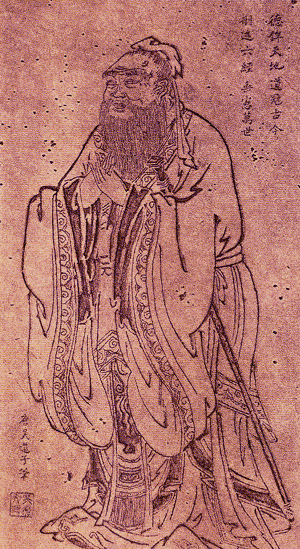 A portrait of Confucius by Wu Daozi (685-758 AD) from the Tang Dynasty Ancestor worship
Religiously or spiritually, the Chinese looked to Heaven not only for favor in this lifetime but as a place of residence of departed ancestors ... who, in keeping with the Chinese emphasis on the family as the key to all social order, looked to those ancestors to continue to intervene, now from their vantage-point in Heaven, on behalf of their descendants still living on earth. We call this religion ‘ancestor worship,’ but basically it was just good common sense for the Chinese to continue to honor family heads, even in death, so as to keep them on the good side of things going on in the family (ancestors could be serious trouble if not properly honored). So, from the emperor on down to clan and family patriarchs, the logic was fairly consistent: keep the powers of Heaven happy so that life on earth would continue to be safe and prosperous. Daoism (or Taoism)
The Chinese generally also had a deep reverence for the physical world around them – which could be both incredibly beautiful and bountiful ... but also intensely savage when floods, droughts, locusts descended upon the largely rural society. Daoism, supposedly formulated by the ancient teacher Laozi (was he real, merely mythical, or a combination of many similar teachers?), emphasized the importance of maintaining a simple harmony or balance with nature ... learning how to ‘go with the flow’ rather than try to beat back life. In Daoism there was always a suspicion about urban civilization, an artificial culture resulting from man’s effort to bring life under his own mastery with his walls, buildings, and public works ... and armies to defend these human artifacts. To the Daoist, it was better to keep things simple, natural, and harmonious with respect to nature and its incredible powers. Thus just as Confucianism was something almost like a religion to the upper class Chinese, Daoism served as a popular religion among the common people. Buddhism
Buddhism was a later import from India, thanks to Indian missionaries who in the 100s and 200s AD began to bring this greatly revised version of Hinduism across the Himalayan Mountains to Tibet ... and beyond that to the heart of China (and even further, to Korea and Japan). Nothing about Buddhism seemed to conflict with the ancestor-worship, Confucianism and Daoism practiced by the Chinese ... though there was some political competition at times between the Daoist and Buddhist monks and their imperial sponsors. In any case, the work of the Buddhist missionaries seemed to be greeted with fair success. Behind the success of Buddhism in China were the many written works or sutras translated into Chinese ... and the many Indian teachers who interpreted these works to the various Chinese, from the emperors on down to the common villagers. Buddhism sought to honor the Buddha himself by careful study and mediation on the high moral principles of the sutras ... which worked well with the Confucianists ... and then live simply and honestly according to those same moral principles, which worked well with the Daoists. One of the great teachers (again, real, fanciful or a combination of several teachers?) was the Buddhist monk Bodhidharma who founded the Chan (in Japan, Zen) school of Buddhism ... which carefully instructed and disciplined its disciples concerning the path to Buddhahood ... something close to Daoism in process ... though – in line with classic Buddhism – seeking the extinction of the sense of self (or release from mortal bondage and its concerns) ... and not just the mere harmony of the self with the surrounding world. |
|
|
The Emperor Huangdi and the Xia Dynasty (2600 to 1700 BC?)
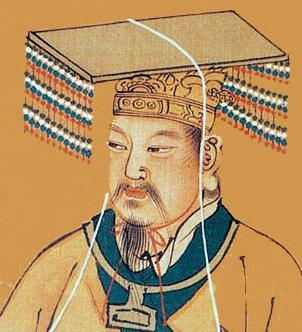 Chinese
dynasties able to enforce some degree of unity of the various Chinese
clans date way back in history ... although here too it is difficult to
separate fact from fancy. The first Chinese dynasty listed in the
dynastic histories was the Xia Dynasty, reigning anywhere from 2600 to
1700 BC (?) with its famous, through probably highly mythical, Emperor Huangdi
(Yellow Emperor) as its possible founder. To him was attributed
the founding of a huge number of Chinese cultural items (writing, math,
law, tools – even sports) ... as well as having founded the ‘Han’
Chinese people and their social order. He in short represented
all the virtues by which the Chinese identified themselves as a highly
moral, highly civilized people living amidst the barbarian nations that
surrounded them. Chinese
dynasties able to enforce some degree of unity of the various Chinese
clans date way back in history ... although here too it is difficult to
separate fact from fancy. The first Chinese dynasty listed in the
dynastic histories was the Xia Dynasty, reigning anywhere from 2600 to
1700 BC (?) with its famous, through probably highly mythical, Emperor Huangdi
(Yellow Emperor) as its possible founder. To him was attributed
the founding of a huge number of Chinese cultural items (writing, math,
law, tools – even sports) ... as well as having founded the ‘Han’
Chinese people and their social order. He in short represented
all the virtues by which the Chinese identified themselves as a highly
moral, highly civilized people living amidst the barbarian nations that
surrounded them.The Shang Dynasty (c. 1766- 1050 BC)
The next dynasty on record was the Shang Dynasty ... although it is not until the 1300s BC that we get any kind of detail about the dynasty other than the names of its emperors. This is when we get the first glimpse of imperial ancestor worship ... by which the Emperor approached his departed imperial ancestors for guidance in his ruling of the empire (just as clan and family fathers performed the same rituals for their respective societies). The Emperor was also expected to engage in the reading of the oracle bones1 which magically foretold the future. Both ancestor worship and reading oracle bones were the most critical jobs expected of the Emperor as China’s link to the Heavens. The emperor could of course be a conquering hero or political consolidator of the Chinese social realm. But he is best understood as China’s Chief Priest. This became even more the case ... when the effective area of Shang political rule became more and more reduced – as the Chinese regions became increasingly politically independent. 1These were turtle undershells or the shoulder bones of oxen that were heated and cracked ... the cracks providing divine answers (which the Emperor was supposed to be able to interpret) to particular issues. |
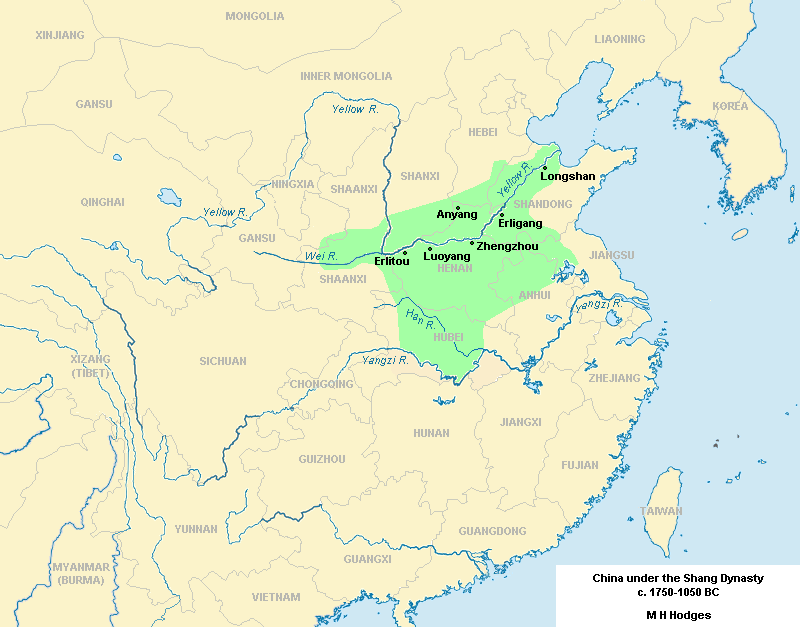
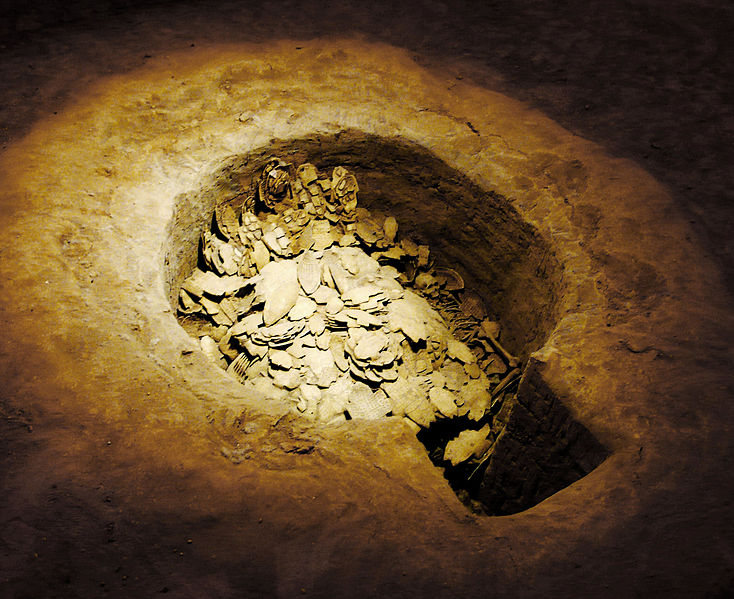
Chinese oracle bone pit at
the late Shang Dynasty capital of Yinxu (near modern Anyang)
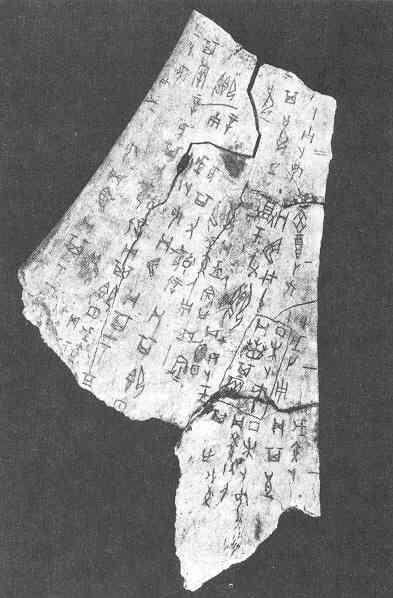
Chinese oracle bone from
the Shang Dynasty
Columbia University (East
Asian Library)
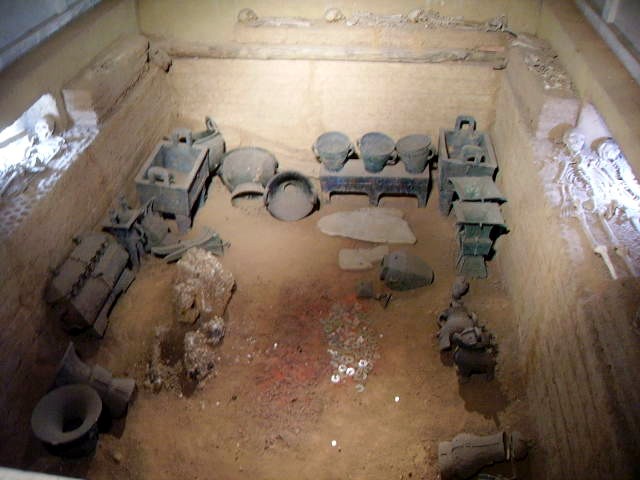
Bronzeware excavated at the
tomb of Lady Fu Hao, Yinxu
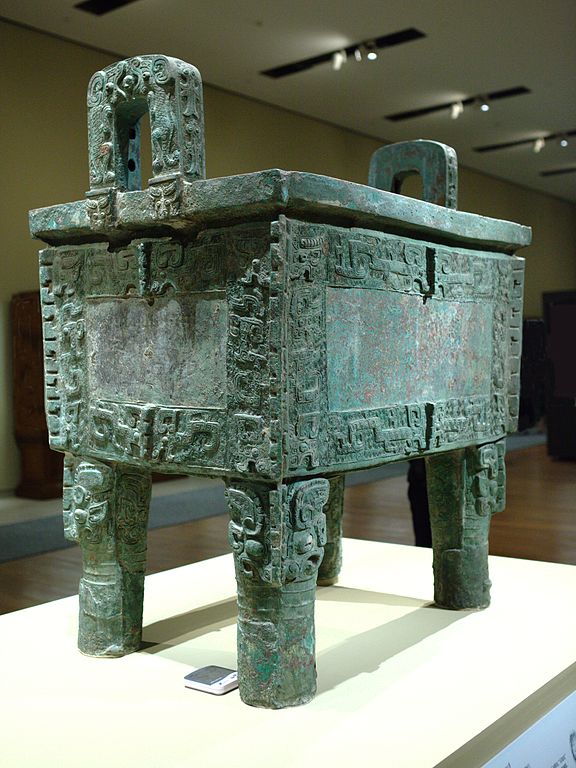
Houmuwu Ding made in the
late Shang Dynasty at Anyang
This wine vessel is the
heaviest piece of bronze work found in China so far.
Height 133 cm, width 112
cm, depth 79.2 cm, weight 875 kg.
The National Museum of
China.
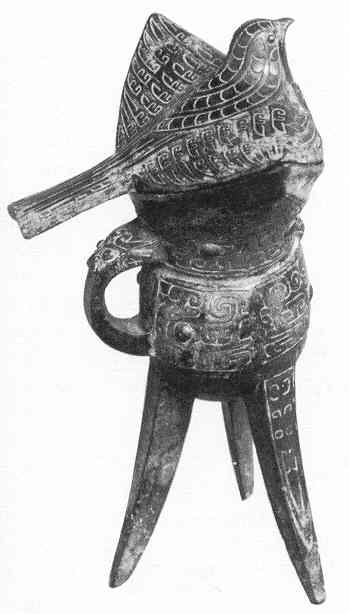
Chinese bronze wine vessel
from the Shang Dynasty
The Metropolitan Museum
of Art, Rogers Fund 1943
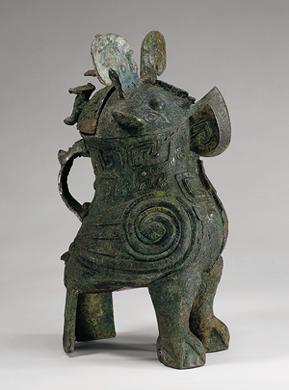
Bronze owl-shaped vessel
(zun), Late Shang Period (c. 1200 B.C.)
The Institute of Archaeology,
Chinese Academy of Social Sciences, Beijing
National Gallery of Art,
Washington D.C.
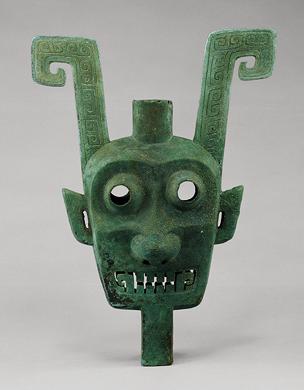
Bronze two-sided mask, Late
Shang Period (c. 1200-1050 B.C.)
Jiangxi Provincial
Museum, Nanchang
National Gallery of Art,
Washington D.C.
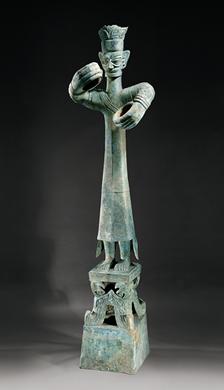
Bronze standing figure, Late
Shang Period (c. 1300-1100 B.C.)
Sanxingdui
Museum, Guanghan
National Gallery of Art,
Washington D.C.
|
The Western Zhou Dynasty (c. 1045-770 BC)
Then appeared the Zhou Dynasty in the Western Shang territory ... when the Duke of Wu formally threw off Shang authority and announced himself as king. But upon the new king’s death two years later his brother, the Duke of Zhou, claimed that he possessed the "Mandate of Heaven" and thus took for himself the title of Emperor. This was the first specific mention in the Chinese history books of the Mandate of Heaven ... and the emperor’s critical role in courting the favor of Heaven (principally the emperor’s own imperial ancestors in heaven) in securing the right to rule. So excellent was his rule however that he became quite the model of what the Chinese felt that they had the right to expect of any emperor. He became the moral standard by which the Chinese emperors earned the loyalty of the Chinese people. Falling short of that standard would also create the opposite result: the right of the Chinese people to refuse to honor and support the emperor. Politically speaking, the Zhou government was something of a feudal system, with each of the Zhou Empire’s many regions having their own aristocratic governors (some of whom would become ancestors of later dynastic rulers of China) ... the whole thing held together by the military – and moral – strength of the emperor. At first (around 1000 BC) the Zhou emperors were so strong in holding and extending their rule across northern China that they were able to extend their reach ever southward ... expanding the Han Chinese population against other Asians (such as the Vietnamese, Laotians and Cambodians) so that the latter were forced to relocate themselves deeper and deeper into the South, until they came to occupy the large Indo-Chinese peninsula (where they are still located today). But despite the effort to strengthen the emperor’s rule in China with the buildup of a disciplined army and a professional bureaucracy, ultimately it was the personal strengths of the emperors themselves that determined the strength and stability of China’s imperial government. Over time that special leadership quality weakened, the regional governors became increasingly independent, and Chinese political stability suffered accordingly. For a brief period under the long reign of Zhou King Xuan (827-782), the Zhou Dynasty recovered some of its strength. But after that China fell back into a long period of disarray. Five centuries of civil strife
But then for the next five centuries China seemed lost in constant clan warfare: the Spring and Autumn Period (ca. 770-480 BC) and the Era of the Warring States (ca. 480-221 BC).2 At first the wars were fairly numerous but small, as they were fought among multitudes of small kingdoms. But over time as the actors got knocked out, one by one, and the contenders thus became fewer in number but larger in size, the battles became much more devastating to China. Thus it was that the social philosopher Confucius set out to try to put Chinese governance under some kind of moral restraint ... and the Daoist Master Laozi attempted to show the Chinese the path of retreat from the trauma of this warring period. 2Despite the rosy sound of the ‘Spring and Autumn Period,’ the term derives from the name of a written history, the Chungqui (The Spring and Autumn Annals). Actually it was a time of horrendous civil war among the many Chinese states ... as was also the ‘Warring States Period’ ... also named after a written history, the Zhanguoce. |

|
|
China unites under the Emperor Qin Shi Huang (220-210 BC)
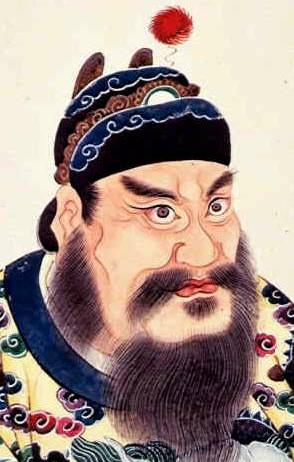 Finally
the strongman Qin Shi Huang was able in 221 BC to force the clans to
come under his tough rule. The following year he dropped the term
king and took the title huángdì (the actual imperial title that would be used after him for the next 2000 years). According to Chinese history,3
he was brutal in the way he secured absolute power for himself over
China ... even burying alive hundreds of Confucian scholars (and
burning their libraries) ... supposedly in an effort to create a single
intellectual culture (his own legalistic culture) for China ... summed
up in a strict law code he put into place and enforced rigorously. Finally
the strongman Qin Shi Huang was able in 221 BC to force the clans to
come under his tough rule. The following year he dropped the term
king and took the title huángdì (the actual imperial title that would be used after him for the next 2000 years). According to Chinese history,3
he was brutal in the way he secured absolute power for himself over
China ... even burying alive hundreds of Confucian scholars (and
burning their libraries) ... supposedly in an effort to create a single
intellectual culture (his own legalistic culture) for China ... summed
up in a strict law code he put into place and enforced rigorously.In his ten-year reign as emperor he began the building of the Great Wall, he standardized both the Chinese currency and system weights and measures, and he laid in place the foundations of a cohesive bureaucracy (made up of legal scholars appointed through examination) operating under his precisely coded laws. But when Qin Shi died,4 he was replaced by an incompetent son (murdered), a couple of scheming officials (also murdered), and then an inept nephew (executed). Quickly the empire Qin Shi had built up split into a number of self-proclaimed kingdoms. 3However, such history is to be viewed with some suspicion because it was written a century after his rule by the Han Dynasty’s Confucian scholars, who naturally hated his memory. 4His burial was also the occasion of the creation of the terracotta army of 8,000+ soldiers – each individually crafted – plus hundreds of chariots and horses and various officials and court entertainers ... buried with him "to protect him in the afterlife." |
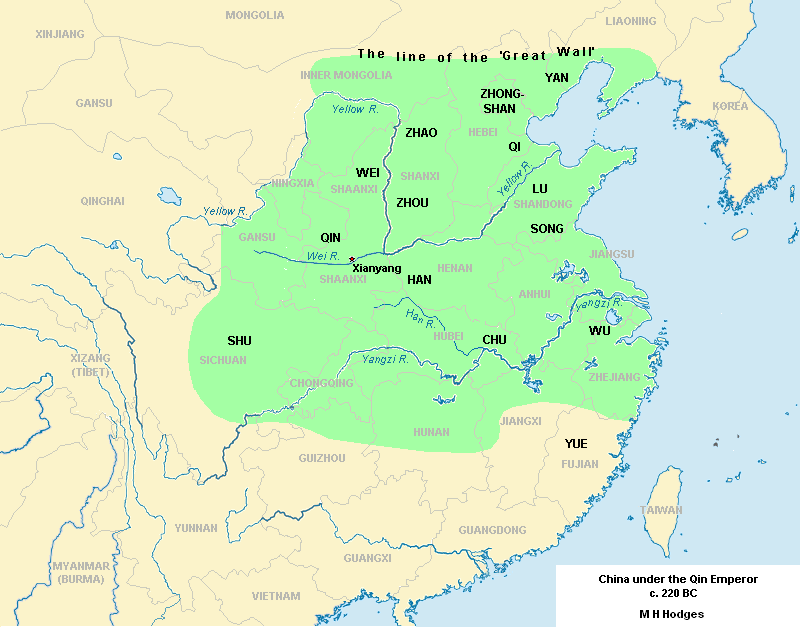
|
|
Emperor Liu Bang (Gaozu) ruled 202-195 BC
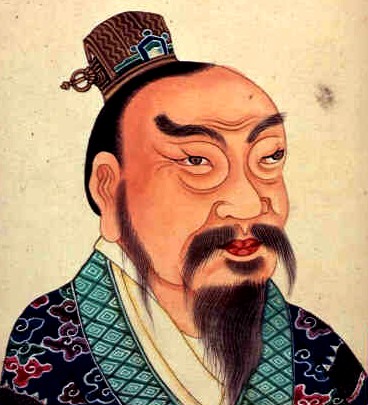 The
Chu leader then went on to destroy entirely the Qin capital (and
execute the last Qin emperor) ... but was then himself defeated in
battle (202) by his own lieutenant Liu Bang, prince of a small fief of
Hanzhong along the Han River. Liu Bang then went on to proclaim
himself Emperor (known posthumously in history as Gaozu or Emperor Gao)
and took for himself and his descendants the Dynastic name ‘Han.’
Thus the great Han Dynasty was born ... and in its four-century rule
give China its ‘Han’ character that it would carry down to today. The
Chu leader then went on to destroy entirely the Qin capital (and
execute the last Qin emperor) ... but was then himself defeated in
battle (202) by his own lieutenant Liu Bang, prince of a small fief of
Hanzhong along the Han River. Liu Bang then went on to proclaim
himself Emperor (known posthumously in history as Gaozu or Emperor Gao)
and took for himself and his descendants the Dynastic name ‘Han.’
Thus the great Han Dynasty was born ... and in its four-century rule
give China its ‘Han’ character that it would carry down to today.Emperor Gaozu took up immediately where Qin left off, building much of his governmental and economic structure on the foundations laid out by Emperor Qin. In the Western third of his empire he set up 13 commanderies which he governed more or less directly through bureaucratic supervision ... and in the Eastern two-thirds of his empire he set up ten kingdoms under the rule of his supporters in his rise to power. But he built the new Han moral code directing Chinese life on the teachings of Confucius ... setting aside portions of Qin’s Legalism and its harsh penalties (although he could be as tough as any emperor in dealing with rebellion). It was only in his dealings with the giant Xiongnu5 Empire to the north and northwest of China that Gaozu ran into difficulties. Han forces sent against the Xiongnu were defeated in 200 BC, and an agreement was negotiated between the two powers involving the sending by Chinese of expensive goods as tribute to the Xiongnu ... and the exchange of women between the two as royal wives. But sadly for China, at his death in 195 he was followed by a quick series of weak male offspring dominated by their respective mothers 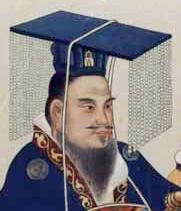 Emperor Liu Heng (Wu) ruled 141-87 BC.
It was a grandson, Liu Heng, (son of a relatively humble imperial
consort) that finally was able to bring some stability back to Han
government. In cooperation with his Daoist wife, the Empress Dou,
Emperor Wu presided over a ministry of able advisors who helped him
bring China to such prosperity that the country’s warehouses were
bulging with overproduction of food. Emperor Liu Heng (Wu) ruled 141-87 BC.
It was a grandson, Liu Heng, (son of a relatively humble imperial
consort) that finally was able to bring some stability back to Han
government. In cooperation with his Daoist wife, the Empress Dou,
Emperor Wu presided over a ministry of able advisors who helped him
bring China to such prosperity that the country’s warehouses were
bulging with overproduction of food.It was Emperor Wu who first introduced the examination system by which Chinese officials were recruited into the Chinese bureaucracy. He also established imperial universities where Confucianism could be studied by those seeking entry into the ranks of Chinese government. Militarily, Emperor Wu was able to break Xiongnu power and open up diplomatic relations with societies to the West ... and to lay out the great Silk Road connecting China commercially with the world of the Mediterranean. He also expanded Han control deeper south in China, gaining dominion over a number of kingdoms well to the south of the Yangtze River ... reaching even into northern Vietnam. And he established commanderies in Korea. Emperor Xuan (ruled 74-49 BC). Following Emperor Wu’s death in 87 BC, the imperial title was fought over by his descendants, with much of the court intrigue led by various Dowager Empresses. Some stability was finally achieved by the regency of Huo Guang, the Marquess of Bowang. He would become famous for his unselfish service to the imperial government in finally securing in 74 BC the imperial title for Emperor Xuan – at a great personal risk to himself. Emperor Xuan was the great grandson of Emperor Wu, who however had grown up as a commoner because of the fall from power of his father and grandfather resulting from the court intrigues of the times. Huo Guang had recognized in the young Xuan a hardworking yet humble youth ... able easily to identify with the Chinese commoners and their challenges because of his own personal experience. As emperor, Xuan lowered the tax burden on the people, used a kinder hand in administering justice, and was wise in his choice of counsellors. But after Huo Guang’s death in 68 BC, he had the rest of the Huo clan put to death because of their continuing attempt to control imperial affairs ... the one dark mark on his otherwise highly lauded rule. The Xin interlude (8-23 AD)
The next Han emperors, Yuan (49-33 BC), Cheng (33-7 BC) and Ai (7-1 BC) found themselves caught up in succession crises as brothers and half-brothers struggled for power ... with Empress Dowager Wang Zhengjun trying to keep the peace within the quarreling imperial family. Consort Fu, who was jealous of Dowager Wang, and the incompetence of Emperor Ai, who also died in 1 BC without an heir, finally threw Chinese imperial politics into such a crisis that the Wangs, who (except Dowager Wang) had been disgraced earlier by jealous rivals, were brought back to power as counselors to restore order to imperial politics. 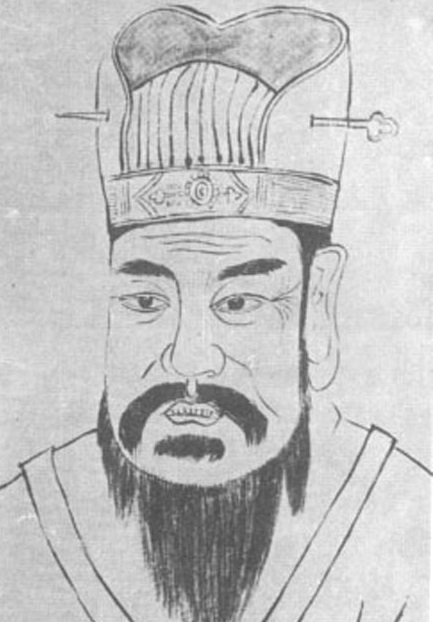 Wang Mang (1 BC-23 AD).
At this point Emperor Ai’s 9-year-old cousin Ping was installed as
emperor ... although Dowager Wang’s nephew Wang Mang, serving as
regent, was effectively in charge of imperial affairs. At one point (AD
3) Wang Mang had to put down brutally a conspiracy to overthrow him,
led by his own son and by uncles of Emperor Ping. Then step by
step he moved to place himself in the imperial throne, poisoning
Emperor Ping ( AD 5) and forcing his aunt, Dowager Wang, to turn over
the imperial seal to himself (however, the aging Dowager Wang remained
a supporter of the Han dynasty all the way to her death in AD 13). Wang Mang (1 BC-23 AD).
At this point Emperor Ai’s 9-year-old cousin Ping was installed as
emperor ... although Dowager Wang’s nephew Wang Mang, serving as
regent, was effectively in charge of imperial affairs. At one point (AD
3) Wang Mang had to put down brutally a conspiracy to overthrow him,
led by his own son and by uncles of Emperor Ping. Then step by
step he moved to place himself in the imperial throne, poisoning
Emperor Ping ( AD 5) and forcing his aunt, Dowager Wang, to turn over
the imperial seal to himself (however, the aging Dowager Wang remained
a supporter of the Han dynasty all the way to her death in AD 13).As ‘Acting Emperor’ Wang Mang selected the 1-year-old child Ying as Han Emperor ... and then turned to put down the rebellions against his own rule. Then in AD 8 he simply took full title as Emperor and founded the new Xin Dynasty. He tried to infuse his new dynasty with legitimacy by reorganizing and renaming political offices and jurisdictions with ancient titles ... and expanding the role of the Confucian scholars as the foundation of his new government. He attempted to abolish slavery and to redistribute land more equally among the Chinese ... but failed of both counts to get the country to abide by his edicts. He also tried – and failed – to reform the country’s tax and coinage systems ... leaving the country more confused than helped through his efforts. When Xia officials ordered frontier communities to end the payment of tribute to the Xiongnu (who would raid and enslave Chinese women and children when tribute was not paid), a series of wars took place (AD 10-14) ... which resolved little and merely weakened the impression of the Xin Emperor’s ‘Mandate of Heaven.’ Likewise Wang Mang’s imperial troops began to have troubles keeping the clans of the Chinese Southwest under imperial order ... as well as some of the Korean clans. Also in AD 11 the Yellow River overflowed, destroying crops and causing a major Chinese famine. Slowly the Chinese people were beginning to believe that Wang Mang had lost the Mandate of Heaven. By AD 17 agrarian revolts (led principally by the Chimei or ‘Red Eyebrows’ and the Lulin) were breaking out across the land. At this point Liu brothers of the Han clan came forward to lead the restoration of the Han Dynasty. In AD 23 Han and Xin military met in battle ... which did not go well for the Xin. Han general Liu Xiu met and killed Xin general Wang Xun ... with Han forces crushing and sending fleeing surviving Xin troops. Then as Han forces approached the imperial capital at Chang’an, rebels rose up against Emperor Wang ... and killed him. Thus ended the brief Xin Dynasty. The (Eastern) Han restoration (AD 23-220)
The brief (Ad 23-25) rule of Han Emperor Gengshi. At first (AD 23) one of the Liu leaders, Liu Xuan, was named Han emperor (Emperor Gengshi) ... but was jealous of his cousin, Liu Yan, his prime minister. He had him executed ... then fell into remorse and named Liu Yan’s brother, general Liu Xiu, as Marquess of Wuxin. But this would not appease Liu Xiu ... who waited for the opportunity to dethrone his cousin. This opportunity first appeared in AD 24 when Chimei armies attacked Gengshi’s troops and defeated every army Gengshi sent against them. They then marched on Gengshi’s imperial capital at Chang’an (AD25), where a desperate Genshi executed a number of his generals who were plotting against him, then fled the capital as another general joined forces with the Chimei. Meanwhile Liu Xiu announced himself emperor as he began to take control of a number of Chinese provinces ... and also a compliant Luoyang, making it his capital city. But the Chimei also named their own emperor, the young Liu Penzi, to whom Gengshi surrendered (on condition of being named as a prince in exchange for his stepping down). But with the Chimei effectively in charge at Chang’an, Chimei soldiers began pillaging China ... to the point that the popular mood turned toward the idea of restoring Genshi to power. But that possibility was closed off when Gengshi was strangled. 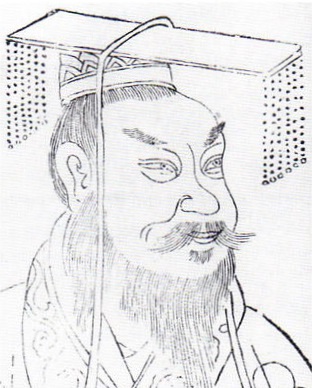 Liu Xiu as Emperor Guangwu (AD 25-57).
Having secured most of China north of the Yellow River, Emperor Guangwu
(Liu Xiu) took on the Chimei armies one by one and brought about their
defeat (including Liu Penzi). He also brought other pretenders to
the Han throne plus local clans and their warlords under his authority,
bringing the last of them under his dominion by the year 36. Liu Xiu as Emperor Guangwu (AD 25-57).
Having secured most of China north of the Yellow River, Emperor Guangwu
(Liu Xiu) took on the Chimei armies one by one and brought about their
defeat (including Liu Penzi). He also brought other pretenders to
the Han throne plus local clans and their warlords under his authority,
bringing the last of them under his dominion by the year 36.Domestically he was noted for his more generous instincts in the matter of taxes and law enforcement. Once in power he experienced no further major wars, though he was quick to put down a Vietnamese rebellion led by the Trung sisters (AD 40). His battles with the Xiongnu were minor ... although constant raids by the Xiongnu in northern China did depopulate the region as the Chinese migrated south to get away from these raids. Eventually (AD 48) the Xiongnu themselves split into two contending kingdoms, north and south, with the southern Xiongnu becoming tributary allies to the Han in AD 50. In AD 57 Emperor Guangwu died and was succeeded by his son, Prince Zhuang (Emperor Ming). Emperor Ming (AD 57-75). Prince Yang (his name changed to Zhuang as he approached adulthood) proved at an early age to be very wise ... and even his father Emperor Guangwu consulted him frequently. Emperor Ming was generous in his treatment of his fellow family members (unusual for imperial families) – at least initially – yet very tough in his handling of corrupt officials. He was careful to bring dignity to the imperial office in the way he carefully followed Confucian doctrines in his rule. To strengthen the position of Confucianism in China he built an imperial university at his capital of Luoyang ... where children of Chinese officials could learn the Confucian classics so essential to the strong moral foundations of the Chinese bureaucracy. His generals were also able to pacify the North Xiongnu ... and secure the Silk Road to the West. It was during his reign that Buddhism began to make its strong entrance into China. But late in his reign Emperor Ming executed three Chinese rebellious princes who at different times betrayed his trust ... and who each sought to bring him down by having warlocks put curses on him! But in trying to get to the bottom of the plots, Ming allowed interrogators to torture and put to death any suspected fellow conspirators ... ultimately losing control over the process when people began to accuse each other wildly – and tens of thousands ultimately died as a result of the "investigations." Finally, under the urging of Empress Ma, the emperor backed down from the "investigations." Otherwise, he ended his reign in AD 75 with China at peace ... and very prosperous. Indeed, at this point the Han Dynasty reached the height of its power and glory. Emperor Zhang (75-88). Crown Prince Da, Emperor Ming’s son by way of Da’s adoptive mother Empress Ma, had been designated by Emperor Ming as his heir-apparent ... although Prince Da had numerous brothers older than him. Then when Emperor Ming died in AD 75, the 18-year-old Prince Da took the Chinese throne as Emperor Zhang. Emperor Zhang was of a kinder nature than his father and was quick to lighten the tax load of his Chinese subjects. This hard-working emperor was well-served by his counselors (including his adoptive mother, Empress Ma ... who however died only four years into his reign) and his military generals ... and in the latter case was able to continue to pacify the North Xiongnu and secure the Silk Road to the West. Thus the Han "golden age" put in place by his father continued under Emperor Zhang. But his rule would be troubled at the palace by the Empress Dou – whom he loved very much – who, after the death of the Dowager Empress Ma, moved to have her Dou relatives placed in key positions in the Chinese administration. At various times she and her Dou relatives falsely accused her competitor consorts Song and Liang of various acts ... in order to bring shame on them and their families and clans (suicide by poison being the usual result). Eventually Empress Dou’s brothers took over the effective governance of China ... beginning a trend (government by the Empress’s clan leaders ... challenged by other clans) that would continue through the rest of the years of the Han Dynasty ... and help bring about the decline of the dynasty. Decline of the Han Dynasty
From this point on, palace politics would be very messy ... leaving Chinese leadership in turmoil – and China along with it. Emperor He (AD 88-105) found out that Dowager Empress Dou was only his adoptive mother and that she was responsible for the death of his birthmother Consort Liang. Consequently, with the strong support of the eunuch Zheng Zhong, Emperor He arrested Dowager Empress Dou and had the entire Dou clan removed from power. But this merely cleared the way for Zheng Shong (and palace eunuchs after him) to move into the power vacuum created by the Dou purge. The lack of any direct heirs also complicated the question of Emperor He’s legacy. And clan rivalries promoted by the women of the palace also greatly weakened He’s rule. Also, during Emperor He’s reign, the Qiang people of Eastern Tibet revolted against Han rule because of the corruption of Chinese officials ... and the treatment the Qiang received as non-Han Chinese. The Qiang would remain in a constant state of rebellion for the next several generations ... further undercutting the image of Han power. In 106 Dowager Empress Deng was able to maneuver He’s 12-year-old nephew, Prince Hu, into the position as Emperor An (106-125) ... then continued quite capably to govern China as regent for the next fifteen years during Emperor An’s minority years (and after). Finally with her death in 121, Emperor An had full control of his government. But Emperor An was weak in character, easily influenced by those directly around him ... and was more interested in women and drink than the affairs of state. In any case the Deng clansmen in the palace were purged and the Song and Yan clans tended to take their place at the center of power ... although the eunuchs and other clan members challenged that power whenever possible. The messy state of affairs under Emperor He became even messier under Emperor An. Meanwhile the Qiang in the West and the Xiongnu in the northwest were joined in rebellion against Han authority by the Xianbei (a Mongol people) in the north and northeast. Han authority at the frontiers was slipping. Emperor An died fairly young and now Dowager Empress Yan tried to take control as regent ... but was opposed by the palace eunuch Sun Gheng. She was defeated, her clan (as always) purged (suicide by poison) and Emperor Shun placed on the throne (125-144). He was followed by the seven-year old Emperor Zhi, who ruled only two years rule before he was poisoned. He was followed by Emperor Huan (146-168) ... who took the throne at age 14. Again, a struggle between the Dowager Empress and the eunuchs to run China during the Emperor’s youth only inspired greater corruption within the Chinese government. When in 166 students rose up in protest against the corruption, Emperor Huan merely had all the students arrested ... and the corruption continued. Two years later, at age 36, Emperor Huan died ... with no son of his own to take his place. Once again, a jealous empress had another consort put to death before moving to have the 12 year-old Liu Hong selected as Emperor Ling (168-189) with full intention of reigning over China as regent ... except that she was strongly opposed by the eunuch Zhang Rang ... and she (and her father and clan) lost. During Emperor Ling’s 21-year reign, Zhang largely governed the country ... as the emperor was more interested in enjoying the sensual pleasures and happy to leave full responsibility to his ‘father’ Zhang. Corruption in the form of heavy taxes laid on the peasants and payments to Zhang and his cohorts for the purchase of public offices became so burdensome that revolts broke out all over China ... importantly the Taoist Yellow Turban sect which in 184 intended to overthrow the Han Dynasty and place its mystical leader Zhang Jioa over China. It took a number of Han armies sent out to defeat the Yellow Turbans – and the death of Zhang Jiao himself – to finally break the rebellion. But the rebellion(s) had left the power of the Han Dynasty so weakened that the Chinese provinces found themselves looking increasingly to their own leaders rather than the imperial government for keeping the peace in the land. When Emperor Ling died (189) Zhang Rang’s enemies came after him, and he ended his life by suicide ... along with thousands of other eunuchs subsequently executed by the Han military in the effort to end the eunuchs’ power over the palace. China’s new emperor was the 8-year-old Liu Xie (Emperor Xian of Han: 189-220) – the last of the Han emperors. But effective rule was now held by China’s military leaders – warlords actually. During battles among the warlords, Emperor Xian was merely a puppet, issuing directives of the warlords using his name as authorization. Actually General Cao Cao succeeded in bringing some degree of unity back to China ... but then in 208 lost in battle much of what he had gained and found himself sharing China with other warlords. Then when he died in 220 his position was taken by his son, Cao Pi ... who forced Emperor Xian to abdicate ... and who then proclaimed the founding of the Wei Dynasty. But he was quickly challenged by the Shu and Wu kings. 5Because they left no written records for historians to study, no one is still today exactly sure who the Xiongnu were – Mongols, Turks, Iranians, Huns or some mixture. |
|
|
The Three Kingdoms (220-280)
In any case the Han Dynasty had effectively come to an end ... replaced by three bitterly contending kingdoms, the Wei being the strongest of the three. Numerous individuals from these clans would adopt the imperial title ... but the reality was that China no longer benefitted from effective imperial rule. The Jin dynasty (265-420)
Another clan, the Jin, succeeded in 265 in overthrowing the Wei ... and going on to unify the country in 280 in defeating the Wu. But the unity was brief as rebellions broke out constantly ... and corruption and family squabbles within the ruling dynasties quickly undermined the unity of the Jin government. Also Jin rulers or ‘emperors’ were captured in battle and executed (Emperor Huai in 313 and Emperor Min in 316) greatly weakening Jin power. And it was a time of great turmoil among the Chinese commoners ... who migrated south (depopulating the north) to get away from the chaos – creating in the process something of a separate Chinese society in the south. Joined by the Sixteen Kingdoms (304-439)
But different peoples (the ‘Five Barbarians’) also migrated into northern China during this same period ... establishing their own (‘Sixteen’) kingdoms, thus further weakening the Jin claim to imperial rule. This chaotic period would end up qualifying as one of China’s darkest ages. The Northern Wei unify northern China
During this time period Xianbei under the chief Tuoba Yilu migrated into northern China from Mongolia and became "Sinified" (absorbed into Chinese culture) ... and eventually adopted the Chinese name "Wei" during the reign of Tuoba Gui, who in 398 declared himself Emperor Daowu. The Zhou begin a process of reunification
The path out of the disunity that marked China since the fall of the glorious Han dynasty was set by a non-Han Chinese warlord from western China, Yuwen Tai, who began to consolidate his holdings by bringing the northern part of China under his military discipline (utilizing extensively the fubing or commoner militias as the base of his power) ... and by cleverly portraying his rule as some kind of reversion to greatly romanticized ancient noble standards ... taking for his rule also the ancient name of Zhou. He also put restrictions on Buddhism and Daoism to emphasize the Confucianist (thus more purely Han) character of his rule. All of this was timed with a major weakening of the Chinese south when the Chen ruler brought the southern capital at Jiankang (Nanking) under his rule by starving and slaughtering the city of 1 million inhabitants (the largest in the world at the time) in 548. The greatly weakened South was thus a fairly easy pickoff by the new Zhou northern dynasty ... especially after the Chens lost an important battle to the Zhou army in 577. But two years later Yuwen Tai died and his rule was passed on to his notoriously brutal and amoral son Yuwen Pin. Emperor Wendi founds the brief Sui dynasty
But the key factor to holding Zhou gains in the face of imperial corruption was Yuwen Pin’s father-in-law, the duke of Sui – who took over governmental affairs and began putting down the rebellions which had broken out across the country. Then when Yuwen Pin died the next year (580) the duke finished off the last of the rebellions ... and then proceeded to eliminate members of the Yuwen clan. The following year (581) he took the title of Emperor, as Sui Wendi. When he then brought the Chen south to defeat in 589 (but showing impressive clemency to the defeated southerners), largely all of China was under his strong rule. China now had an emperor in fact as well as in name. Then Wendi sent out his armies and diplomats to deal with the surrounding peoples, bringing northern Vietnam into his orbit of control, and establishing working relationships with the Kingdom of Sulla (South Korea)6 in the East and the rising Turks and the far West. Being a devout Buddhist, Wendi lifted the Yuwen restrictions against Buddhism and Daoism ... but strengthened his government administration along even stronger Confucianist lines ... giving his government a more universal appeal among the people. Yet Emperor Wendi could be very tough on those who opposed his rule, executing many and imposing tough discipline even on his own family. Much wealth was lavished on Buddhism in the form of the new temples and statues erected in the hundreds of thousands. And he rebuilt his capital city, Chang’an, along truly monumental lines. The Emperor Yangdi
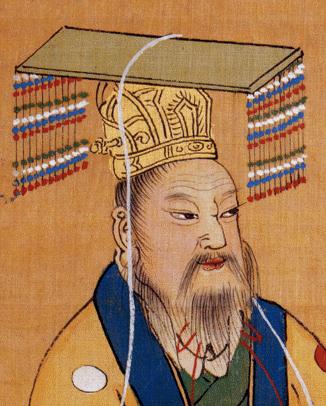 His
son Yangdi (who may have murdered his father in his impatience to
inherit his imperial title) was no less heavy handed in his rule ...
adding to that sexually and materially wanton ways that his father did
not demonstrate. Yet he largely continued his father’s plan of
disciplining Chinese governance – including rebuilding the examination
program by which local magistrates were selected – so as to bring to an
end the governmental chaos that had existed since the breakup of Han
China three and a half centuries earlier. His
son Yangdi (who may have murdered his father in his impatience to
inherit his imperial title) was no less heavy handed in his rule ...
adding to that sexually and materially wanton ways that his father did
not demonstrate. Yet he largely continued his father’s plan of
disciplining Chinese governance – including rebuilding the examination
program by which local magistrates were selected – so as to bring to an
end the governmental chaos that had existed since the breakup of Han
China three and a half centuries earlier. But the biggest achievement during Yangdi’s rule was the building of the Great Canal (605-611), linking the northern Yellow with the southern Yangzi rivers, with extensions branching off to connect even more of China politically ... and commercially. But the enterprise had involved the forced labor of many hundreds of thousands of laborers (men, women and children), forcing Yangdi to have to chose between using the men for his fubing army or his army of canal diggers ... leaving China in a state of frustration – and a spirit of revolt. Then with massive floods destroying China’s crops (610-611) ... plus the failure of a grand military venture in Korea (614) ... restlessness turned into full rebellion. In 616 Yangdi took refuge away from his problems by retreating to his adoptive south ... where he was murdered in 618 by one of his generals. The Mandate of Heaven had clearly been removed from the short-lived Sui Dynasty. But all the Sui political and economic achievements worked greatly to the benefit of the following Tang Dynasty, which continued onward directly from the point where the Sui Dynasty had left off. 6But the North Korean Kingdom of Goryeo (or Goguryo) remained successfully defiant of Sui ... and usually also of Tang ... China. 6But the North Korean Kingdom of Goryeo (or Goguryo) remained successfully defiant of Sui ... and usually also of Tang ... China. |
|
|
Emperor Gaozu (618-626) founds the Tang Dynasty
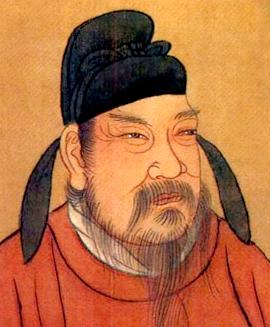 But
first, the rebellions springing up all around China had to be dealt
with. This is the point at which the Li family stepped forward to
take charge of the pacification of China. Li Yuan, Duke of Tang
(and related to Sui emperor by marriage), took charge of the process of
pacification even before the emperor’s murder. Then with Yangdi’s
death, Li Yuan went through the motions as imperial regent of installing
another young Sui offspring, Emperor Gong ... but soon answered the
urging of his supporters (and the call of Heaven) and set aside Gong
and named himself China’s new emperor (better known in history by his
title awarded after his death, "Gaozu," meaning progenitor or dynastic
founder) ... clearly putting before the Chinese a new dynasty, the
Tang, as China’s imperial rulers. Li Yuan spent most of his brief
reign putting down rebellions and bringing China under his
control. But he also kept most of the Sui officials in place,
making his move into the imperial office quite smooth by Chinese
standards. But
first, the rebellions springing up all around China had to be dealt
with. This is the point at which the Li family stepped forward to
take charge of the pacification of China. Li Yuan, Duke of Tang
(and related to Sui emperor by marriage), took charge of the process of
pacification even before the emperor’s murder. Then with Yangdi’s
death, Li Yuan went through the motions as imperial regent of installing
another young Sui offspring, Emperor Gong ... but soon answered the
urging of his supporters (and the call of Heaven) and set aside Gong
and named himself China’s new emperor (better known in history by his
title awarded after his death, "Gaozu," meaning progenitor or dynastic
founder) ... clearly putting before the Chinese a new dynasty, the
Tang, as China’s imperial rulers. Li Yuan spent most of his brief
reign putting down rebellions and bringing China under his
control. But he also kept most of the Sui officials in place,
making his move into the imperial office quite smooth by Chinese
standards.Emperor Taizong consolidates the imperial gains (626-649)
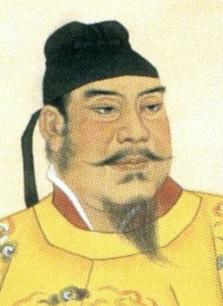 But
Tang Emperor Li Yuan was deposed by his ambitious son, Li Shimin, in
626. To consolidate his hold on the imperial office, Li Shimin
then had his brothers killed (a not uncommon practice in Chinese
imperial politics). He took the temple name Taizong ... by which
he is generally known in history. But
Tang Emperor Li Yuan was deposed by his ambitious son, Li Shimin, in
626. To consolidate his hold on the imperial office, Li Shimin
then had his brothers killed (a not uncommon practice in Chinese
imperial politics). He took the temple name Taizong ... by which
he is generally known in history. He had serious challenges to face in the form of the Turkish tribes to the north of China – strengthening under the growing power of the Eastern Khagan (or Khan of Khans) – and the Koguryo Korean kingdom to the northeast. A couple of attempts by Taizong to subdue Koguryo ended in humiliating failure. With respect to the Turks, Taizong attempted to profit from the internal rivalries of the Turks ... but did succeed in the exchange of a diplomatic mission and gifts with the Khagan, which both the Chinese and the Turks each chose to interpret as tribute being sent in submission by the other party! Anyway, it kept relations with the Turks fairly peaceful. Although Taizong was himself rather indifferent toward Buddhism, his rule marks the beginning of an important mission of a Chinaman, Xuanzang, to India through Tibet in his quest to create a deeper connect between Buddhist China and the Buddhist homeland of India. In this, despite incredible hardships involved in his personal pilgrimage, he was hugely successful, his return years later to China with multiple artifacts and a library of Buddhist works translated into Chinese having a huge impact on Chinese culture ... perhaps impacting Taizong, but certainly his successor, Gaozong. Chinese historians would treat Taizong as the model of imperial excellence ... a leader willing to listen to good counsel. The laws became codified, the bureaucracy trimmed back and closely supervised and the fubing militias organized and trained. He was such a thorough enforcer of the peace that the roads and towns of China became entirely safe for pilgrimage, travel, and commerce. While this may have been a bit of an exaggeration of the court historians, Taizong managed to keep that reputation as a model emperor all the way down to today. Emperor Gaozong (649 -683)
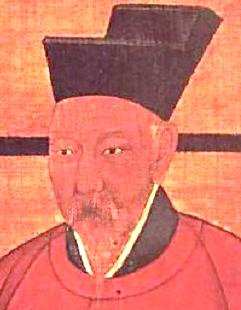 Li
Zhi was the third of Emperor Taizong’s sons by Empress Zhangsun (and
ninth of his total of 14 sons) ... but favored by the Emperor after
some of the older sons got caught up in an intense political rivalry,
one that was even partially aimed at the Emperor himself at one
point. Thoroughly loyal to his father, Li Zhi was considered
however to be of a weak personal constitution. But receiving the
throne upon his father’s death (a long illness) in 649 as Emperor
Gaozong, he chose wise counselors (most importantly his uncle
Zhangsun) ... and during the first years of his reign China
continued to experience the prosperity brought about during his
father’s reign. Li
Zhi was the third of Emperor Taizong’s sons by Empress Zhangsun (and
ninth of his total of 14 sons) ... but favored by the Emperor after
some of the older sons got caught up in an intense political rivalry,
one that was even partially aimed at the Emperor himself at one
point. Thoroughly loyal to his father, Li Zhi was considered
however to be of a weak personal constitution. But receiving the
throne upon his father’s death (a long illness) in 649 as Emperor
Gaozong, he chose wise counselors (most importantly his uncle
Zhangsun) ... and during the first years of his reign China
continued to experience the prosperity brought about during his
father’s reign. But conspiracies against him abounded in the imperial court itself, forcing the emperor to have to execute a number of high officials (including his sister). Then he lost all effective power to the intrigues of Consort (then Empress) Wu. The Zhou interlude (690-705)
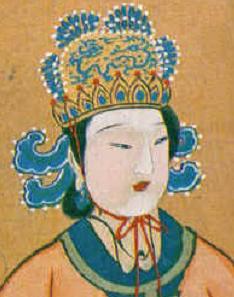 Empress Wu Zetian attempts to install her own "Zhou" Dynasty (684-705).
At first only a consort, Wu succeeded through fantastic court intrigue
(and the moral weakness of Emperor Gaozong) to have the Empress removed
and herself installed in her place, had the sons who were in line to
receive the throne exiled or executed ... including even her own sons
... and finally took total control (around 655) of Chinese political
affairs with the failing health of her husband, the Emperor. With
Gaozong’s death in 683 she set aside her older son Li Zhe after only a
year as emperor (Zhongzong), replaced him with his 12-year-old brother
Li Dan as emperor (Ruizong). But she intended to remain the
effective ruler of China. Empress Wu Zetian attempts to install her own "Zhou" Dynasty (684-705).
At first only a consort, Wu succeeded through fantastic court intrigue
(and the moral weakness of Emperor Gaozong) to have the Empress removed
and herself installed in her place, had the sons who were in line to
receive the throne exiled or executed ... including even her own sons
... and finally took total control (around 655) of Chinese political
affairs with the failing health of her husband, the Emperor. With
Gaozong’s death in 683 she set aside her older son Li Zhe after only a
year as emperor (Zhongzong), replaced him with his 12-year-old brother
Li Dan as emperor (Ruizong). But she intended to remain the
effective ruler of China.Then in 690 she took direct control of the Empire as reigning Emperor, demoting Ruizong from Emperor to the rank of Crown Prince ... also forcing him to change his family name from his father’s Li to her family’s name Wu. She then announced that China was under a new dynasty (the Zhou, named after a famous dynasty of earlier days in Chinese history, which she claimed she was descended from) and took for herself the name Wu Zetian. She would rule China with an iron fist, keeping an eye on her empire through large body of secret police ... with her armies also quick to put down rebellions – which were frequent. To secure her rule she also ordered, on a rather regular basis, the exile or execution of numerous princes, princesses, counselors, scholars, generals and other officials – including twelve whole branches of the imperial family. On the other hand, the common people of China found her rule most acceptable, as prosperity continued in the countryside. She even moved some of the industrial dynamic that had long been focused on the Chinese northeast further west into the Chinese interior. She continued to support strongly the fubing, keeping military expenses low and the strength of her military up ... expanding the empire thereby to its furthest extent thus far ... even finally bringing Korea under Chinese imperial influence. She also received the first Arab Muslim ambassador to China in 651. She was partial to Buddhism and elevated it above Daoism (her husband’s family however had made much of the fact that they were supposedly descendants of Daoism’s founder Laozi) ... although she did order the Dao de Jing of Laozi to be added to the list of required reading by the imperial university students. She also opened (somewhat?) the examination system leading to civil service appointments to commoners (formerly only members of aristocratic families were eligible). Finally in 705 her unwise sexual adventures (at 80 years of age!) led her to be successfully overthrown in a palace coup and forced to give up the throne to her older son and briefly former emperor, Zhongzong. The Tang dynasty was officially restored. The short reigns of Emperor Zhongzong and Emperor Ruizong. (705-712)
Zhongzong (705-710). With his mother’s overthrow in 705, Zhongzong took back his position as emperor. But he was of a weak character (like his father) and in fact his wife, Empress Wei and her lover Wu Sansi (Wu Zetian’s nephew) actually ruled China. Zhongzong died in 710 (poisoned by the Empress Wei) setting up a scramble for power within the imperial household. Ruizong (710-712). Empress Wei’s intention of placing the young Li Chongmao on the throne – so that she would be able to control China (like Wu Zetian) – was challenged by the sister of Zhongzong and Ruizong, Princess Taiping ... in company with Li Longji, son of the former Emperor Ruizong. The two moved swiftly against Empress Wei (who died in the coup), placing Ruizong back on the throne as emperor and Li Longji as crown prince. Zhongzong (705-710). With his mother’s overthrow in 705, Zhongzong took back his position as emperor. But he was of a weak character (like his father) and in fact his wife, Empress Wei and her lover Wu Sansi (Wu Zetian’s nephew) actually ruled China. Zhongzong died in 710 (poisoned by the Empress Wei) setting up a scramble for power within the imperial household. Ruizong (710-712). Empress Wei’s intention of placing the young Li Chongmao on the throne – so that she would be able to control China (like Wu Zetian) – was challenged by the sister of Zhongzong and Ruizong, Princess Taiping ... in company with Li Longji, son of the former Emperor Ruizong. The two moved swiftly against Empress Wei (who died in the coup), placing Ruizong back on the throne as emperor and Li Longji as crown prince. Emperor Xuanzong (712-756)
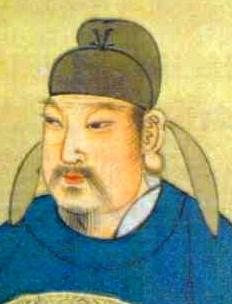 But
Emperor Ruizong abdicated after two years, taking the position as
"retired emperor," (though keeping much of the effective rule of China
still in his own hands ... at least during the next year), elevating Li
Longji to the imperial throne as Emperor Xuanzong. But that next
year (713) rumors of a coup being planned by Princess Taiping led
Emperor Xuanzong to move first, resulting in the death of the Princess
and a number of her followers. This would mark the effective
beginning of Emperor Xuanzong’s actual rule. But
Emperor Ruizong abdicated after two years, taking the position as
"retired emperor," (though keeping much of the effective rule of China
still in his own hands ... at least during the next year), elevating Li
Longji to the imperial throne as Emperor Xuanzong. But that next
year (713) rumors of a coup being planned by Princess Taiping led
Emperor Xuanzong to move first, resulting in the death of the Princess
and a number of her followers. This would mark the effective
beginning of Emperor Xuanzong’s actual rule.The early years (the Kaiyuan era, 713-741) of the reign of Emperor Xuanzong were marked by such excellent rule that Tang China reached an even greater height of culture and regional power. His chancellors, Zhang Yue (1721-1726) and Liu Youqiu (among many others) were a very important part of Xuanzong’s early success. He cleared out Wu’s much hated secret police, placed very effective military governors in the regions bordering the Turkish lands, reduced the size of his armies along the northern borders – granting salaries to those who now served – and restored to grand importance the sacrifices to Heaven at Mount Tai. China prospered. But during the latter years of his reign (the Tianbao era, 742-756) Xuanzong left governance to his chancellors and his regional governors (the jiedushi) and instead indulged himself with the tens of thousands of beautiful women brought to his palace. In time he was betrayed in his trust of his counselors, principally Li Linfu (734-752), a scheming chancellor who used his office to benefit himself handsomely rather than work to the benefit of the imperial government itself. Also in 751 Xuanzong’s armies lost the Battle of Talas against the Muslim armies of the Abbasid Caliphate, and thus outlying territory in the West now fell under Muslim dominion. As far as chancellors went, Yang Guozhong took up where Li Linfu left off and thus the corruption continued. Rebellions now began to break out here and there around the empire. Rumors of plots and counterplots (including a number of executions) among those surrounding the emperor now began to break out. Xuanzong’s government found itself in deep trouble. The An Lushan Rebellion. The worst for Xuanzong came when General An Lushan (a bitter rival to Yang Guozhong) planned and then commanded a massive uprising against the Emperor in 755. An Lushan proclaimed himself as emperor and founder of a new Yan dynasty. The emperor lost heart (the Imperial Guard assassinated Chancellor Yang Guozhong and the wily Consort Yang) and fled Chang’an (his imperial capital) ... and turned the imperial throne over to his son Suzong, letting him deal with the chaos (although as ‘retired emperor’ he occasionally manipulated things from behind the scene; however he died in 762, a worn out and depressed version of his former self). |
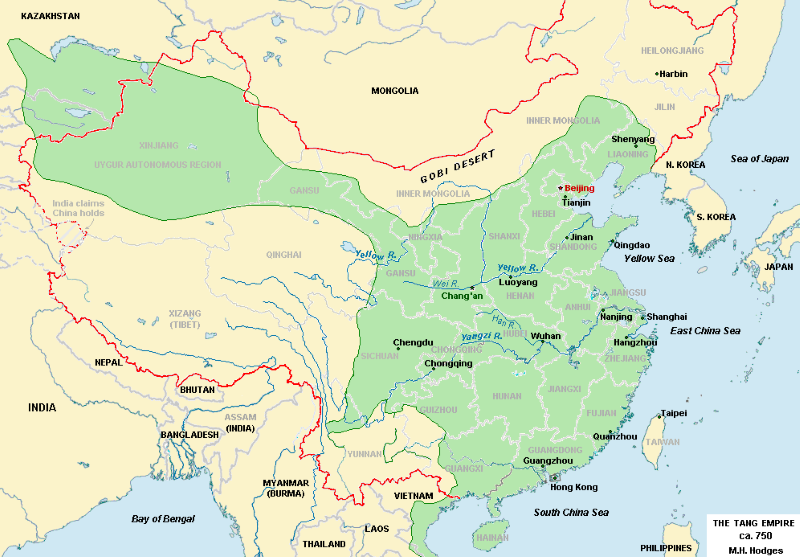
|
Dynastic decline
The new emperor Suzong found dealing with the An Lushan rebellion a bit easier when An Lushan’s son assassinated his father (757) in order to gain his own imperial position ... but actually weakening his position in the process. Emperor Suzong was able to recapture the capital Chang’an soon thereafter. But the An Lushan Rebellion would last over five more years, further weakening the political position of the Tang Dynasty. Although much of the north of China would be brought back under Tang rule, the Western Regions (Arab and Turkish Sogdian and Uighur regions) would now go their own way. Now the jiedushi (regional governors) began to take up the ancient role of local warlords ... collecting their own taxes to finance their own separate governments, thus fracturing China’s basic political unity achieved under the Sui and first Tang emperors. The imperial bureaucrats selected by careful examination would be ignored ... and then abandoned as a tool of the increasingly merely nominal figure of the emperor. A brief revival under Xianzong (805-820)
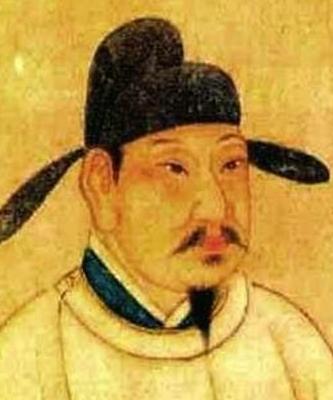 At
first the weakening of the hand of the imperial government freed up the
economy ... and China actually seemed to prosper a bit with the rise of
the merchant class in the latter part of the 700s. Then in the
early 800s the Tangs once again came under a strong hand, that of
Emperor Xianzong. He cut back the power of most of the jiedushi
with his own rebuilt imperial army in order to restore Chinese
political unity. But tragically, his successors did not
demonstrate any of the same talents for rule. China now slid back
into political trouble ... one that would grow deeper with the passing
of time. At
first the weakening of the hand of the imperial government freed up the
economy ... and China actually seemed to prosper a bit with the rise of
the merchant class in the latter part of the 700s. Then in the
early 800s the Tangs once again came under a strong hand, that of
Emperor Xianzong. He cut back the power of most of the jiedushi
with his own rebuilt imperial army in order to restore Chinese
political unity. But tragically, his successors did not
demonstrate any of the same talents for rule. China now slid back
into political trouble ... one that would grow deeper with the passing
of time.Full decline of the Tang Dynasty (820-960)
For the masses life once again began to be very difficult. Battles among rival warlords would destroy farmlands and villages. The roads would be infested with huge bands of robbers and the rivers by teams of pirates. And a Mongolian people to the northeast, the Khitans, were growing ever more powerful ... eventually establishing their own Liao Dynasty – one which would pose a direct challenge to the independence of Chinese society ... at least in the north. The masses knew that Heaven was angry and that the Mandate of Heaven had passed from the hands of the Tangs ... though it would take many more generations of ‘would-be’ emperors until that Mandate was clarified with the rise of the Song Dynasty in around 960. In the meantime, China suffered terribly. The worst came during a massive rebellion (874-884) in which the entrepreneurial Huang Chao challenged Tang authority by eventually (878-879) attacking the port city of Guangzhou (Canton) and massacring the Arab and Persian merchant population there ... and then marching on the Tang capitals at Chang’an – forcing the Tang Eperor Xizong to flee. Huang Chao then declared himself Emperor and head of the new Qi Dynasty ... which, however, lasted only until his death (at the hand of his nephew) in 884. The Tang dynasty was thus ‘restored’ ... although its power at this point was largely only symbolic. The era of the "Five Dynasties" and "Ten Kingdoms" (907-960)
By the early 900s there were five dynasties (Liang, Tang, Jin, Han and Zhou) ruling northern China in rapid succession ... the middle three actually Turks who had adopted Chinese culture and ruled as Chinese dynasties only in the northern portion of China. All five dynasties originated – as with all dynastic founders – had been founded by "usurpers," military governors originally serving under the Tang. Each dynasty claimed to possess the Mandate of Heaven; each dynasty however was short-lived: the Later Liang (907-923), the Later Tang (923-936), the Later Jin (936-946), the Later Han (947-950) and the Later Zhou (951-960). The founder of the Later Liang had murdered two Tang Emperors on the road to power, the Khitans then helped the Tangs overthrow the Liang ... but brought the Tangs – and after them especially the Jins – under Khitan mastery. So weak were these ‘dynasties, that at one point (946-947) the Khitans even seized the Jin capital at Kaifeng. The Hans recovered Kaifeng and some of the prefectures under Khitan dominance ... but they were soon overthrown by a rising Zhou power. Despite the chaos (and it was quite severe) this period saw some key advances in Chinese culture ... notably the block printing of all the Confucian classics (some 130 volumes) and the introduction of paper money in the form of bankers’ promissory notes. In both areas the Chinese would be centuries ahead of the West in the development of printing and banking. At the same time that the Five Dynasties were savagely replacing each other one after another, in the south of China ten smaller but more stable kingdoms were able to operate regionally with some degree of security and prosperity. This contrast in living conditions thus caused the massive migration of many Han Chinese from the north to the south. Also, a huge growth in the population occurred – principally in the prosperous south, where by the early 900s 60 percent of the 100 million Chinese now lived. The Khitan Liao Dynasty (907-1125)
Abaoji (ruled 907-926). To the north of the Five Dynasties (centered in modern Manchuria) was the semi-Chinese, semi-Mongol empire of the Khitans, headed after 907 by the Liao Dynasty. Its empire constituted most of Mongolia, northern Goryeo (Korea), and northern China. Its founder, the Khagan Abaoji was a mighty conqueror who grew up amidst violence and succeeded in turning the hard lessons he had learned from life to the art of conquest. But he was also a highly intelligent ruler, administering the northern portion of his empire through traditional Khitan principles (rule through feudal lords) at the same time directing the southern portion of his empire along Han Chinese bureaucratic lines (his bureaucracy heavily staffed by Han Chinese). Although Khitan tribal leaders saw their own powers eroded through this system, so successful did it prove in governing the empire that it would remain as the principle system of governance from that point on. The Khitans and the Han Chinese. Khitan culture differed strongly from the Han culture of the Chinese ... especially in the role of the sexes, women frequently occupying key political positions – not by usurpation but by right, according to the Khitan moral code. Given the shortness of life among the warlike Khitans, many claimants by birth to a newly vacated imperial throne would be just boys ... and fall under the supervision of their mothers (or even imperial concubines) – women who often continued to lead even after the boys reached manhood. We have already seen how the Khitans dominated politics in northern China during the Five Dynasties period. And even with the rise of the more enduring Song Dynasty, the wars between the Khitans and Chinese would be constant. Finally after much bloodshed, the Khitan and Song Empires agreed to a Treaty (1005) ... establishing a fixed border and offering a century of peace between the two peoples (at the high price of tribute that the Chinese were required to pay the Khitans). This would be the first instance of the Chinese having to live at the toleration of a Manchurian/Mongol people ... one followed up by Jurchen, Mongol, and Manchu supremacy. But the Chinese learned to adapt to this awkward relationship ... and continue to develop along their own cultural and economic path. Thus in a sense Chinese history at this point began to follow a two-path development of Han Chinese to the South and Manchurian/Mongolian people to the North. |
|
|
Taizu of Song (960-976)
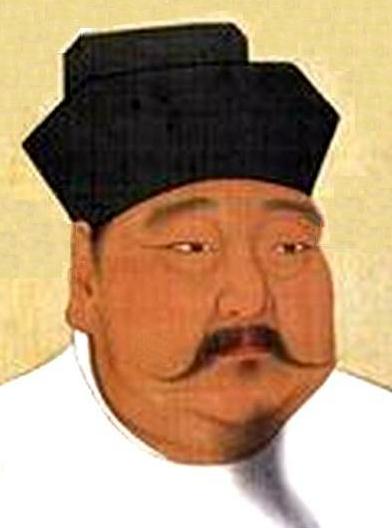 Following
the typical pattern of the ‘Five Dynasties’ period, in 960 Zhou
military commander Zhao Kuangyin rose up against Zhou Emperor Gong,
forcing him to abdicate ... and taking command of (Northern) China
himself as Emperor Taizu of Song. But unlike the other dynasties,
the new ‘Song’ Dynasty would prove to have lasting qualities ...
although it would take some time to certify this fact. Following
the typical pattern of the ‘Five Dynasties’ period, in 960 Zhou
military commander Zhao Kuangyin rose up against Zhou Emperor Gong,
forcing him to abdicate ... and taking command of (Northern) China
himself as Emperor Taizu of Song. But unlike the other dynasties,
the new ‘Song’ Dynasty would prove to have lasting qualities ...
although it would take some time to certify this fact.During his 16-year reign the new Emperor Taizu defeated other Chinese states, starting with the smaller and weaker kingdoms in the south, broke the power of the independent warlords, replaced China’s effective governance by civilian administrators answering solely to him, and thus brought under his effective rule largely all of China – that is, China south of the territories in the north held by the Khitans in the northeast and the Xia in the northwest. Although the Tang rulers had themselves used civilian administrators (chosen through an examination focusing on the Chinese classics in literature), Emperor Taizu increased the number of schools preparing young men for just such examinations ... and actually made the administrators who came to office through the examination system the vast majority of his governing officials. And he was able to reward amply his generals in taking their retirement from active duty ... considerably cutting back on the conflicts that had previously torn China apart. He also proved to be a major patron of the arts and the development of science and technology. Under his governance, China began a long period of relative peace and prosperity ... at least to the south of China away from the troubled northern borders with the Khitans and Western Xia. With the signing of the Shanyuan Treaty of 1005 with the Khitans, the realm of peace would expand considerably. |
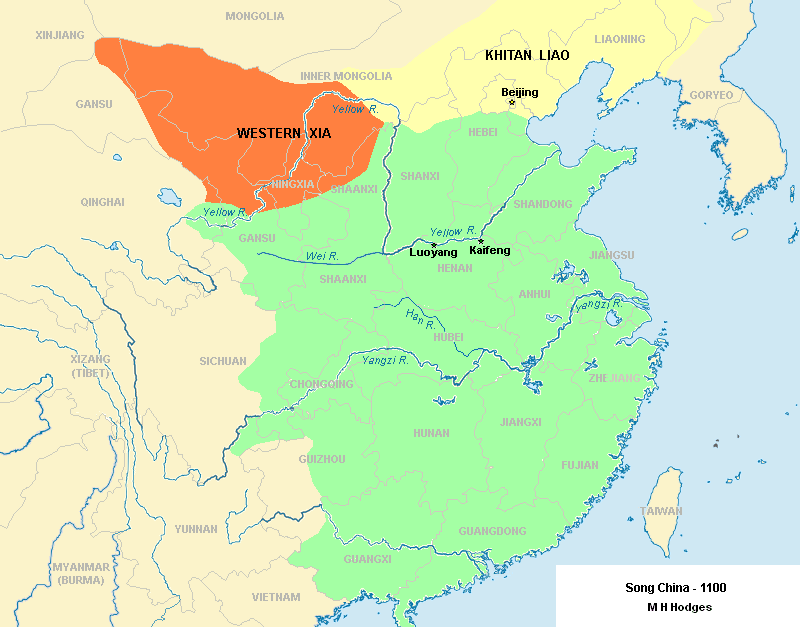
|
The Period of the Northern Song (960-1127)
In fact, this period of peace and prosperity performed some major cultural developments in China. The population recovered to its previous Han and Tang size, 50 million people according to official figures ... although the population was likely much larger than that. This stability – and accompanying economic development – allowed tremendous development of Chinese society ... still united politically under the leadership of the Song Emperors, but locally very dynamic in the conduct of economic, social and cultural affairs. Somehow China’s fate seemed less dependent on the dynamic of imperial court politics – and the doings of the emperors. This was in great part due to the transference of governing dynamics from the Chinese military to the Chinese Confucian bureaucracy ... the former seemingly less necessary for the good order of China – and the latter ever more tightly disciplined by the exacting Confucian moral code that guided closely the conduct of Chinese government throughout the Empire. During this period commerce and trade were greatly facilitated by the expansion of coinage – and also the use of paper money and sophisticated banking methods. Chinese trade and investment societies formed for the purpose of investment and the protection of professionalism in industry. Industry everywhere boomed ... especially iron production – thanks to the substitution of coal for charcoal, making the process cheaper ... and less threatening to China’s forests! Canals were dug to facilitate internal trade ... and a huge navy was developed to protect China’s overseas commercial shipping. Some of the cultural achievements of Chinese society during this period are outstanding. Literacy spread widely because of the growth of Chinese printing ... thanks not only to the wide use of block printing but also the development of moveable type – a discovery in the 1000s five centuries before the same discovery was made in the West in Europe. Consequently, this period in Chinese history saw great development in the world of literature, philosophy, science, art and architecture as well as scholarship in general. And religiously, it was a very active period, with movement back and forth between India and China by numerous Buddhist monks. But huge numbers of Muslims, Persian Manichaeans and even Jews made their way to China ... to do commercial business as well as engage the Chinese with their religions. Settled conditions also allowed more leisure ... and thus time for festivals, social clubs, sporting events and theater ... all of which developed to a highly sophisticated degree. |
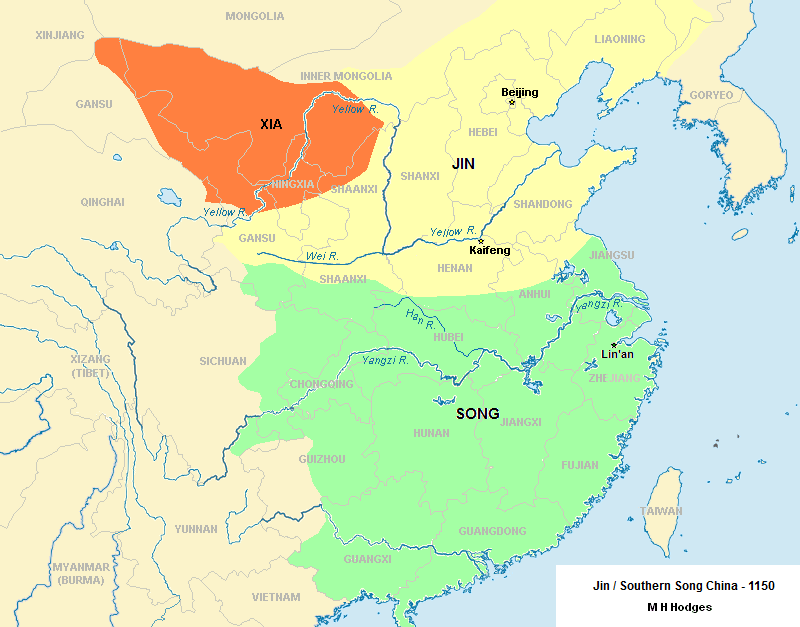
| Court
politics of course continued as usual ... although it tended to focus
more on policy than personality. For instance, efforts in the
1040s by imperial Chancellor Fan Zhongyan to reform the methods of
recruiting and administering the huge Song bureaucracy, to increase its
effectiveness both in local government and in imperial defense, met
with stiff resistance from the older members of the court who felt
threatened by these reforms ... and ultimately Fan was banished to the
provinces. But his reform efforts would be taken up again only a
few decades later when Emperor Shenzong (1067-1085) gave full backing
to his Chancellor Wang Anshi for just such reforms. Mounting problems with the Jurchen’s Jin Dynasty to the north. But the peace of the north would be broken when in 1115 a subject tribe of the Liao, the Jurchen, rose up against their Liao masters and declared their own "Jin" Dynasty. The very artistic but politically weak Chinese Emperor Huizong was advised by his eunuch advisor Tong Guan to ally with the Jurchen in bringing the Liao Dynasty to an end (1125). But then the Jurchen or Jin turned on Huizong when the greatly weakened condition of the Song military became obvious, seizing the Song capital at Kaifeng and capturing the Emperor and nearly all of his Imperial court in 1127. The Jurchen Jin Dynasty (1115-1234)
Remnants of the Song Dynasty were able to escape south of the Yangtze River and reposition their government at Lin’an (modern Hangzhou) ... and carry on much as before – although with only the southern half of China to claim as their own. The Jurchen Jin now ruled what was formerly northern China from their capital at Yanjing (modern Beijing). Both Empires considered themselves to be the true Zhongguo (Central Kingdom or State) ... that is ‘China.’ The battle between the two Chinas would at first be fierce ... until 1141 when a treaty outlining the border between the two Empires was signed (allowing a brief period of peace) and then another treaty in 1164 ushered in a longer 40-year period of peace between the two societies. The Jurchen were not ethnically Han Chinese, but quickly adapted Han culture as their own ... and (according the the natural bias of the court historians) were well received as their new dynasty by the Han Chinese clans living in the newly conquered Jurchen territory. But Jurchen Emperors would have troubles with their own Jurchen noblemen (and from time to time Khitan troops), facing rebellions as they attempted to solidify their power Han-style. The period of rule by Emperor Shizong (1161-1189) and his grandson Emperor Zhangzone (1189-1208) marked the height of Jurchen prosperity and strength. Emperor Shizong tried to support Jurchen culture (having Chinese classics translated into Jurchen) ... as did his grandson ... although Emperor Zhangzone was also a great lover of Han culture. The Southern Song carry on (after 1127)
When the Song Imperial government retreated south with the rise of the Jin Empire, life largely continued as it had before when the Song Dynasty had ruled the whole of China … with the exception of the wars with the Jin that waged on and off constantly. With its trade routes by land to the West now cut off by the hostile Jin, Song trade took more eagerly the sea route … necessitating even more a strong navy … established as a permanent feature of Chinese defenses in 1132. But this same navy also enabled the Song (also using new paddlewheel boats) to achieve a victory against the Jin in battles on the all-important Yangtze River (1161) … in which the Song launched gunpowder bombs at the much larger Jin navy throwing the latter into confusion and handing the Song a great victory... and ultimately the peace treaty of 1164. Genghis Khan
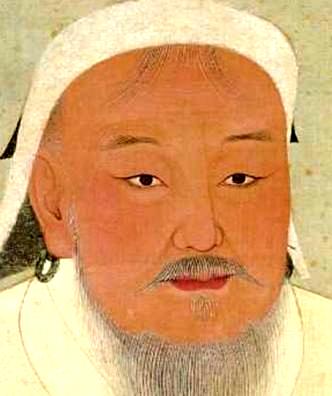 Then
at the beginning of the 1200s an event to the north of the Jin Empire
took place that would shake up not only China, but all of Asia ... and
even Eastern Europe. The Mongol Khan, Temüjin, had proved so
successful in his consolidating Mongol power in the north that in 1206
he took for himself the title Genghis Khan (universal governor) ...
announcing to the world the arrival on the political scene of a great
new military power. Then
at the beginning of the 1200s an event to the north of the Jin Empire
took place that would shake up not only China, but all of Asia ... and
even Eastern Europe. The Mongol Khan, Temüjin, had proved so
successful in his consolidating Mongol power in the north that in 1206
he took for himself the title Genghis Khan (universal governor) ...
announcing to the world the arrival on the political scene of a great
new military power.Temüjin had first united by force (and much intrigue) the numerous nomadic Mongol tribes of Northeast Asia, tribes that normally occupied themselves in fighting each other ... when they were not fighting their ancient tribal enemies, the Tatars. Temüjin was very demanding of the performance of his troops, though generous to them in victory ... and with respect to defeated fellow Mongols, quick to invite them into his growing military organization. Nonetheless, he had some very treacherous court politics (including dealing with some early and once-close friends, who eventually fought him for power) to get settled before he could be sure his rule was secure. A big part of his early success was due to the diplomatic moves of the Jurchen Jin ... who helped him return to power after a defeat Temüjin experienced in 1187 at the hands of his former close friend, Jamukha, put Temüjin in the political wilderness for the next ten years. But Temüjin returned to the scene when in 1197 the Jin put him in command of a unit fighting the Tatars ... whose defeat helped restore Temüjin to power. But his relationship with his friend Toghrul was soon broken ... as Toghrul chose to ally himself with Jamukha in 1201 – when Jamuka was awarded by the Mongols the title, Gür Khan. It was the great battle between Jamuka and Temüjin for Mongol dominance in 1206 – which Temüjin won decisively – that ultimately would seal the fate of the Mongols ... and soon much of the rest of the great Eurasian land mass. The fall of the Jurchen Jin
In his move to power, Temüjin – in alliance with the Jin – had taken on the Empire of the Western Xia in 1205 ... and four years later (as ‘Genghis Khan’) had utterly crushed the Xia. But then in 1211 he turned on the Jin Empire, gathering Khitan and Jurchen rebels as he went. One by one Genghis Khan’s armies attacked (and looted) the various Jin capitals ... including the main capital (today’s Beijing) – although under a humiliating treaty the Jin were allowed to retain their position there. But the next year Jin Emperor Xuanzong moved his court to the southern capital at Kaifeng. Foolishly Xuanzong attempted to restore Jin prestige by attacking the Song Empire ... and suffered a huge defeat. Thus now he found his empire squeezed between two hostile empires, the Mongol to the north and the Song to the south. At this point the Jin Empire began to break down ... with not only hostile Khitans but also disaffected Han Chinese living in the Jin Empire defecting to the Mongol side of the imperial struggles. Beijing was taken and sacked in 1215 by Genghis’s army and Manchuria was lost to the Mongols. Then Genghis found himself busy elsewhere in his attacks into Western Asia ... and the Jin attempted to rebuild during this time. But in 1228 the Mongols returned in force ... though the Jin put up a fierce resistance. Then when in 1233 the Jin capital at Kaifeng finally fell, it was all over for the Jin. The further rise of the Mongols
Ögedei Khan (ruled 1227-1241). Genghis Khan had died in 1227 ... but his position – and ambition – was taken up by his son Ögedei, who would supervise the further expansion of the Mongol Empire across all of Asia and into Europe – much further than his father might have even imagined possible. When the Mongols had begun their rise to the north of the Jin, it seemed to the Song as if the Mongols would be a natural ally against the Jin. The Song, of course, were hoping that an alliance with the Mongols would help the Song regain their lands in the Jin north ... and institute a permanent Mongol-Song peace. Thus the Song had entered into the alliance with the Mongols ... and thus Ögedei Khan had renewed the Mongol assault on the Jin in 1228. Eventually (1234) the Mongols were able to chase down the last Jin Emperor (who committed suicide) and thus the Jin Empire was brought formally to an end. Seeing their longtime Jin enemy destroyed, the Song then moved to retake, one by one, the former imperial capitals in the north at Kaifeng, Luoyang and Chang’an. But the Mongols would not be happy with this northward expansion of the Song ... seeing it as a break in the Mongol-Song diplomatic relationship. Soon the Song were to discover some things about the Mongols that the Jin had just learned. The Mongol Empire splits. With Ögedei’s death in 1241, his wife Töregene took authority as regent, and eventually was able to have her son Güyük elected Great Khan in 1246. However Ögedei’s three brothers (Jochi, Chagatai and Tolui) had established dominions of their own ... whose own sons now competed for the title as Great Khan. Batu Khan and the Golden Horde. But Güyük lived only two years before he died (poisoning?) on his way to meet with his Jochid cousin Batu, who (with his brother Orda) had taken control of the Mongol lands in the West. Orda’s "White Horde" ruled Mongol lands in central Asia from Lake Balkhash west to the Volga River, and Batu’s "Golden Horde" ruled Mongol lands west of the Volga River, through southern or Kievan Russia to Bulgaria, Hungary and Poland. Increasingly, Batu’s Golden Horde was operating as a separate, but huge empire by its own right. Möngke Khan (1251-1259). With Güyük’s death, the Mongol Council (the Kurultai) chose Möngke Khan (son of Tolui) as the new Great Khan. Leaving the issue with Batu and the Golden Horde aside for the time being, Möngke Khan addressed himself increasingly to the issue of the Song reoccupation of the southern regions of the former Jin Empire. Seeing this Song move as a break in Mongol-Song relations, Möngke Khan invaded the Song Empire in 1259. But he was killed in this very endeavor, creating yet another struggle among his Mongol successors. 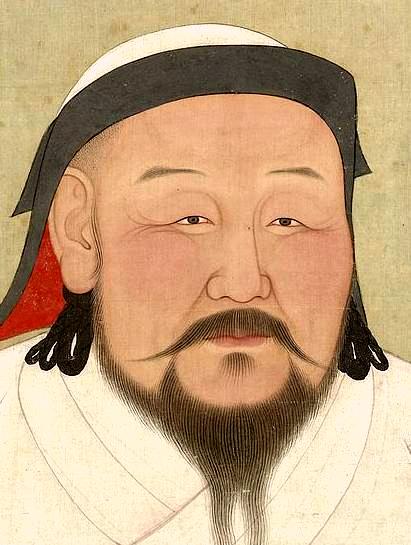 Kublai Khan.
Finally his brother Kublai was able to take the title as Khagan (King
of kings) in 1260 … but received in the process an empire divided among
his Mongol relations. In reality, his power would ultimately be
effective only in the Mongol lands of the East (today’s Mongolia) ...
and ultimately China. Kublai Khan.
Finally his brother Kublai was able to take the title as Khagan (King
of kings) in 1260 … but received in the process an empire divided among
his Mongol relations. In reality, his power would ultimately be
effective only in the Mongol lands of the East (today’s Mongolia) ...
and ultimately China.Hulagu Khan and the Ilkhanate. One of Kublai’s brothers, Hulagu Khan, had earlier been ordered by Möngke Khan to put the Muslim world of Abbasid Iraq, Ayyubid Syria and Mamluk Egypt under Mongol domination. This he did (except for Egypt), quite brutally ... massacring the population of entire cities in the process – the most notable (and horrific) taking place at the Abbasid capital at Baghdad. But with Möngke’s death in 1259, Hulagu returned East to help Kublai in his struggle with Song China. Hulagu had left behind some of his troops in Palestine to continue the war against the Mamluks. But a major battle there the following year did not go well for his troops. Consequently, Hulagu returned to his western lands in 1262 to restore Mongol power there. But he soon found himself at war with a Mongol cousin Berke, now ruling the Golden Horde ... who had converted to Islam and who sought revenge for Hulagu’s massacre of the Baghdad population. However an attack by Hulagu to the north against the Golden Horde achieved nothing, and consequently Hulagu had to content himself with ruling the lands he had previously conquered in Iran, Iraq and Syria – lands which collectively came to be known as the Ilkhanate. But this, by its own rights, was a huge empire … basically duplicating the extent of the old Persian Empire. The last glory days of the Song
Even as the Mongol Empire had established itself as a formidable power in the north of China, Song China in the south was itself undergoing something of a great "classical age," with the Chinese culture rich in art, architecture, literature, scholarship ... and in general a multitude of refinements (dishware,7 jewelry, silks, etc.) – all of which announced an incredibly high civilization. True, much of China in the north had been lost militarily to "barbarians" ... but the Chinese themselves saw no reason to expect that such high civilization as theirs in the south would ever find itself in serious danger. So "natural" was the obvious superiority of Chinese culture that nothing in the world seemingly could ever bring it down. Even foreigners from the West were enormously impressed. 7For instance, the fabulous blue and white porcelain that the English called "China"! |
|
|
The fall of the Southern Song Empire
The fortunes of war swung back and forth between the Song and Mongol Empires ...Kublai attacking the Song across the Yangtze River, yet having to retreat to face a brother challenging him to the leadership of the Khaganate. In 1265 Kublai returned to engage the Song and little by little advanced along the Yangtze River ... until in 1273 he finally succeeded in gaining complete control of the vital Yangtze River Basin. Then in 1275 two huge armies of the Song and the Mongols met at the Battle Yihu, with the Song being decisively defeated, opening the way for the Mongols to seize the Song capital of Lin’an. The following year the Mongols moved deeply into the Song lands in the south ... and in 1279 defeated the last major Song army at the Pearl River. The Song Dynasty now ceased to exist. Kublai Khan founds the Yuan Dynasty
Kublai Khan had to maintain a delicate balance between the Han Chinese and Mongol advisors in his court. He tended to maintain Chinese officials in their local offices ... but assigned greater status at court to his Mongol advisors. Nonetheless his Chinese advisers continued to play a critical – if somewhat blurred – role in helping him maintain authority over his huge Chinese holdings. He moved his capital from Karakorum in Mongolia eventually to Zhongdu (near modern Beijing) ... and in 1271 declared himself Chinese Emperor and head of the new Yuan Dynasty. Being the ruler not only of China but (in theory) of all the Mongol Empire, it was natural that Kublai had a very cosmopolitan interest, not just merely concerning the protection of the vital Silk Road to the West8 ... but also the continuing expansion of his empire south into Vietnam and Burma and east across the sea to Japan. However, two efforts of his navy to cross the sea to Japan failed, the second one in 1281 at the hands of a great ‘Kamikaze’ (‘divine wind’ or typhoon) which destroyed his Chinese fleet of 4,000 ships. The Chinese would not attempt such a venture again. The moves in the south seemed to be no more successful, the Vietnamese (fortified by refugee Song) in 1288 delivering a resounding defeat to Kublai’s army ... and the ‘victories’ in Burma in the 1280s being so costly that Kublai’s China derived no material benefit from the venture. The effort merely left Burma shattered ... and subject to 350 more years of civil war as local lords fought each other continuously for control of a broken Burma. All of this left Kublai’s China in economic troubles ... which in turn encouraged political strife and rebellion within Kublai’s domain, keeping Kublai busy in Tibet and in the northeast (today’s Manchuria). Kublai’s woes were compounded when a favorite wife and his heir-apparent son died before him ... and his grief became so great that he simply withdrew from his responsibilities – and died a sick and broken man in early 1294. A series of short-lived Mongol regimes (1294-1332)
Temür (1294-1307) and Külüg Khan (1307-1311). Kublai Khan was succeeded by his grandson, Temür, who attempted to continue the policies of his grandfather. But he did not have the ability to play the strong hand required to control Mongol court politics ... and political corruption began to grow rapidly under his rule. Then during Külüg’s short rule things worsened as now the Chinese economy began to falter. Buyantu (1311-1320), Gegeen (1320-1323) and Yesün Temür Khan (1323-1328).
Emperor Buyantu tightened up Mongol rule ... principally by
disciplining the Chinese civil service ... and restoring the principle
of recruitment based on academic examination rather than court
connections and of strict enforcement of the Confucian codes. His
son Gegeen attempted to continue the reforms, but was assassinated only
two years into his rule. But his successor in turn, Yesün Temür,
also was soon assassinated. Mongol China was falling into a state
of revolt and political division at this point.
Tugh Temür (1328-1332). Behind the court rebellion was El Temür, a Kipchak military officer who maneuvered to bring Tugh Temür (son of Külüg Khan) to the Mongol throne ... and then control him. Tugh Temür attempted to turn his throne over to his brother after only one year of rule, but El Temür had the brother assassinated ... forcing Tugh Temür to return to the throne. Tugh Temür was a man of great artistic tastes and skills ... and of much less interest in military matters, a sad lacking given the rebellions that were spreading across the land. But he died only four years into his reign and was replaced as Khagan by his son – who lived only two months. Toghon Temür (1333-1370) ... the last Mongol Emperor
Toghon Temür was only 13 when he inherited the throne ... and found himself under El Temür’s strong hand ... but only briefly, for El Temür died that same year. But El Temür’s place was taken by the Mongol General Bayan of the Merkid ... who proved to be just as authoritarian as El Temür. Finally in 1340, with the help of Bayan’s nephew, Toghon Temür was able to remove Bayan from power ... with the nephew, Toqto'a, then taking command of the Chinese court. Discipline was restored and it looked as if the Yuan Dynasty might return to strength. But the classic destroyers of dynastic tranquility were ravaging the Chinese countryside: floods, famine, the plague, pirates on the rivers and warlords ravaging the land. The worst to occur was the huge shift in the channeling of the mighty Yellow River which devastated multiple cities and left the Grand Canal useless. Finding himself fought at court over his plans to rechannel the Yellow River (it was considered too expensive) Toqto'a resigned his posiiton in 1344. But things only went from bad to worse ... and Toqto'a was recalled in 1349 to try to get China’s vast river system back to normal working operation. But the Chinese economy was weakening ... and funding for the huge venture (using massive amounts of paper money to pay the workers and other expenses) only weakened the economy further. And a new rebellion had broken out in the countryside in 1351, that of the "Red Turbans." Toqto'a was commissioned to crush the rebellion ... a task to which he dedicated himself over the next few years. But in 1354, he was falsely accused of corruption by a court rival, Hama ... who had Toqto'a banished. Toqto'a refused his numerous supporters’ request to combat Hama ... and instead quietly retired (although Hama had him poisoned the next year). With a weak emperor and an unscrupulous chancellor trying to lead the country, the Yuan Dynasty now found itself in deep trouble. Over the next couple of decades warlords took control of the provinces ... and Toghon Temür gradually withdrew from the political life of the country – as it fell into civil war. 8We know many details of his court from the account of the Venetian tradesman, Marco Polo – who with his father and uncle (who also earlier had traveled to China) spent a quarter-century (1276-1291) exploring the Mongol East – and serving in Kublai Khan’s court for 20 of those years. Marco Polo’s account of the journey, recorded by a cellmate (Rustichello da Pisa) while both were imprisoned in Genoa during a war between Polo’s home city Venice and Genoa (1298-1299) – narrated an adventure so fantastic that few people at the time believed the account ... although it was widely read ... and although by the standards of the day it has seemingly proven to be amazingly accurate in detail. |
|
|
The birth of the Ming Dynasty
Yuan decline. At this point Yuan power was disintegrating rapidly. The Great Mongol Empire stretching across the vastness of Asia was itself losing its hold ... and worse, had lost interest in whatever support it might offer to the Mongol Yuan Dynasty in China – which in Mongol eyes had become too "Chinese" (or "Sinified"). The dying Yuan Dynasty was on its own as far as the Mongol cousins were concerned. Yet the Han Chinese themselves had never really accepted the legitimacy of the Mongol government ruling the land. They were willing to support it ... as long as it brought peace and prosperity. But beyond that they had no particular loyalties to the regime ... and when it found itself in trouble the Yuan government quickly discovered how shallow was its pool of support in China. The rapid rise of the Buddhist Red Turban Army – made up of Han Chinese – was a very strong indication of this dynamic at work in China. 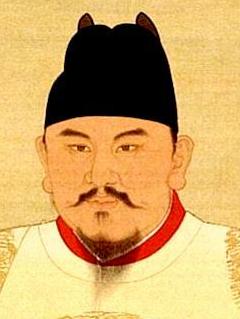 Zhu Yuanzhang/The Hongwu Emperor (1368-1398).
Zhu Yuanzhang was a Han Chinese peasant who as a Buddhist Monk joined
the Red Turbans in 1352 ... and rose quickly through the ranks.
Then as a Red Turban commander, he and his troops were able to capture
the city of Nanjing in 1356, establishing the city as Zhu’s new "Ming"
power base. From there he continued to extend his control over a
broken China. In 1363 his Ming forces took on his major rival,
Chen Youliang of Han, in a series of massive naval battles (involving
hundreds of thousands of sailors on both sides) in which Zhu’s Ming
fireships tore into Chen’s Han navy three times its size ... crushing
the Han fleet – and Chen’s political aspirations. Then in 1367
the commander of the Red Turbans died mysteriously in a meeting with
Zhu. At this point Zhu was effectively the sole candidate in a
position to replace the dying Yuan Dynasty. The following year
(1368) his army was sent to the Yuan capital of Dadu (Beijing) ... and
Yuan Emperor Toghon Temür fled north to Mongolia, leaving his capital
to Zhu. At this point Zhu announced himself as Ming Emperor
Hongwu. Zhu Yuanzhang/The Hongwu Emperor (1368-1398).
Zhu Yuanzhang was a Han Chinese peasant who as a Buddhist Monk joined
the Red Turbans in 1352 ... and rose quickly through the ranks.
Then as a Red Turban commander, he and his troops were able to capture
the city of Nanjing in 1356, establishing the city as Zhu’s new "Ming"
power base. From there he continued to extend his control over a
broken China. In 1363 his Ming forces took on his major rival,
Chen Youliang of Han, in a series of massive naval battles (involving
hundreds of thousands of sailors on both sides) in which Zhu’s Ming
fireships tore into Chen’s Han navy three times its size ... crushing
the Han fleet – and Chen’s political aspirations. Then in 1367
the commander of the Red Turbans died mysteriously in a meeting with
Zhu. At this point Zhu was effectively the sole candidate in a
position to replace the dying Yuan Dynasty. The following year
(1368) his army was sent to the Yuan capital of Dadu (Beijing) ... and
Yuan Emperor Toghon Temür fled north to Mongolia, leaving his capital
to Zhu. At this point Zhu announced himself as Ming Emperor
Hongwu.The Hongwu Emperor immediately undertook all kinds of social reforms, designed to restore Han Chinese to positions of authority recently held my Mongol officials. He had two reasons to want to remake the huge Chinese bureaucracy ... not only because of extensive Mongol personnel but also as a peasant himself, he resented greatly the way bureaucratic officials enriched themselves at the cost to the Chinese farmers and other commoners. But as he would soon discover, cleaning out a bureaucracy is not an easy job ... as bureaucracies fight back at efforts to reduce their power. Nonetheless he was able to cut back on bureaucratic seizure of peasant land ... encouraging the expansion of Chinese farming to a production rate achieved neither before nor since. And just during the 30-year span of his reign the Chinese population jumped from 60 to 100 million in size. He also had a peasant’s contempt for the merchant class – who under the Song Dynasty, had played a central role in the Chinese economy. The Hongwu Emperor wanted to encourage rural farming over urban manufacture and trade.9 He even restricted trade to the Japanese, supposedly to weaken the power of the Japanese "pirates" ... but mostly just making life difficult for China’s coastal traders. Nonetheless, the Chinese economy moved strongly back into commerce and trade despite the restrictions. He also reorganized the Chinese military into local self-standing units, similar to the fubing system instituted by the Sui and Tang Dynasties. The purpose was to have China at the ready in case of future Mongol attacks – which the Chinese rightly expected at any time. It was also (as with the fubing) done to keep military units small and thus not useful for warlords to challenge imperial authority. His other accomplishments were significant. He had the entire Confucian Code updated and revised ... and the educational system built around that legal system also updated. He had the massive 30-mile wall surrounding Nanjing built. He supervised the resettling of hundreds of thousands of Chinese – including huge numbers of his Muslim troops10 – south of the Yangtze River in the Hunan Province. But he did not really understand economics and had massive amounts of paper money printed to pay his soldiers and workers ... making China’s huge inflationary problem even worse. While tolerant of Islam, he tore into the Christian community ... seemingly for its refusal to worship the ancestors (in particular his ancestors) ... virtually eliminating the religion from China (Nestorian Christianity had previously existed in China for centuries). 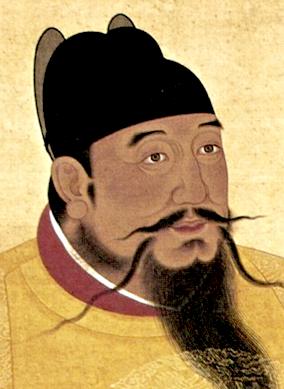 The Yongle Emperor (1402-1424).
A struggle for succession within the imperial family erupted after the
death of the Hongwu Emperor in 1398. The Hongwu Emperor had
designated a grandson as his heir (Jianwen Emperor). But one of
Hongwu’s sons, Zhu Di, rose up in rebellion againt Jianwen ... and
finally in 1402 was able to seize and burn to the ground the Nanjing
Palace, complete with the young emperor and members of his family and
court caught inside. The Yongle Emperor (1402-1424).
A struggle for succession within the imperial family erupted after the
death of the Hongwu Emperor in 1398. The Hongwu Emperor had
designated a grandson as his heir (Jianwen Emperor). But one of
Hongwu’s sons, Zhu Di, rose up in rebellion againt Jianwen ... and
finally in 1402 was able to seize and burn to the ground the Nanjing
Palace, complete with the young emperor and members of his family and
court caught inside. Zhu Di then moved to proclaim himself the Yongle Emperor ... and the next year moved his capital and court to Beijing ... reconstructing the city (1407-1421) as a fabulous capital, with its new Forbidden City housing the Yongle Emperor and his court. And then he proceeded to the slaughter of supporters (and their entire family – on a very wide basis of ‘relationship’) of Jianwen among the court officials and Confucian bureaucracy. And he also took up the cause of cleansing the culture of any Mongol influence still remaining in China. Also, unlike his father, he invested considerable effort in building up China’s commercial fleet (thousands of ships constructed during his reign - some of them huge by the standards of the times) in a major emphasis on building the Chinese economy through commerce and trade (and diplomacy). He sent out a number of huge (and very expensive) commercial expeditions to ports around East and Southeast Asia ... but also reaching all the way to Northeastern Africa. And he spent many of his years fighting Mongol raiders in the north ... to keep land routes open to the West. Ming China over the next 200 years
The Hongxi and Xuande Emperors ... and Emperor Yingzong (1425-1464). The Yongle Emperor’s son, Hongzi Emperor, lived less than a year before dying and leaving his throne to his son, the Xuande Emperor (1425-1435). The Hongxi Emperor, in his brief tenure on the throne, terminated the expensive naval expeditions so loved by his father, had the massive Chinese navy destroyed, and closed down most of China’s foreign trade. He seemed to be reverting to the policies of his grandfather (set aside by his father). But the Xuande Emperor reversed again some of his father’s policies ... sending out yet one last massive trade expedition before shutting down the program. The period of the Xuande Emperor’s rule is remembered especially for his military retreat from Annam (Vietnam) and his extensive reliance on eunuchs as personal advisors ... but also for the peace and prosperity experienced by China at this time ... perhaps even constituting for China the Ming Dynasty’s "Golden Age." The Xuande Emperor’s son, Yingzong, had a very mixed time of it as emperor ... given two imperial names (Zengtong and Tianshun) because he was captured in a war with the Mongols, ending his first period of rule (1435-1449) ... his place as emperor was taken by a younger brother (the Jingtai Emperor: 1449-1457) ... and then he was able to set aside his brother (poisoned?) to return to the throne to rule another seven years (1457-1464). The "Tumu Crisis." Yingzong’s loss to the Mongols in 1449 was the most humiliating Chinese military defeat in Chinese history, when a Chinese army of 500,000 was routed by a mounted Mongol army of only 20,000 – nearly collapsing the Ming Dynasty. Yingzong was held by the Mongols for a year (actually befriending the Mongol leader), released ... and then imprisoned by his younger brother for seven years ... when he was finally able to overthrow his brother, the Jingtai Emperor, the latter weakened already by the death of his son. The Hongzhi Emperor (1487-1505). The bright and highly educated (Confucianism) Hongzhi was able to bring some degree of governmental control back to the imperial palace ... cleaning out corruption and bringing on wise counselors as his advisers. Consequently China returned to a peace and prosperity not seen since the grand days of the Yongle era several generations earlier. The Zhengde Emperor (1501-1521). Unfortunately, his son did not follow up with his father’s policies. The Zhengde Emperor was not interest in running the government but instead devoted himself to carnal pleasures ... especially that of the immense harem that he gathered over the years. He also addressed his boredom by undertaking hugely expensive expeditions around the country. However, he occasionally engaged himself in frontier battles (to amuse himself?). Meanwhile, eunuchs took control of the political life of the country, allowing immense corruption to develop within the Chinese government. 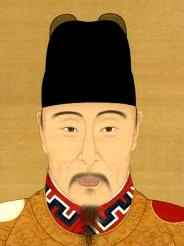 The Jiajing Emperor (1521-1567).
The Jiajing Emperor was known to be very intelligent, but also cruel
... inspiring 1542 an assassination attempt by his concubines which
failed, resulting in the torturous death of the many female
plotters. He was also not supremely interested in the
affairs of state, leaving those matters to his advisors (such as Yan
Song and his son during the latter half of his reign). Corruption soon
spread throughout the Jiajing Emperor’s government. The Jiajing Emperor (1521-1567).
The Jiajing Emperor was known to be very intelligent, but also cruel
... inspiring 1542 an assassination attempt by his concubines which
failed, resulting in the torturous death of the many female
plotters. He was also not supremely interested in the
affairs of state, leaving those matters to his advisors (such as Yan
Song and his son during the latter half of his reign). Corruption soon
spread throughout the Jiajing Emperor’s government.It was also during his long reign that the Manchus began to cause serious troubles along the country’s northern borders ... with Manchu raiders even able to reach the outskirts of Beijing in 1550 ... before being bought off by the promises of special trading rights. He became increasingly obsessed in his later years with the fear of aging and approaching death, engaging in sexual activities with young girls that he hoped would revive his masculine strength. He also became involved in alchemy in a similar hope ... his life ending in 1567 – possibly accidentally from an overdose of one of his self prescribed mercury treatments. 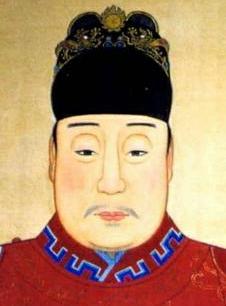 The Wanli Emperor (1572-1620).
In the first ten years of his rule, the Wanli Emperor – with the
excellent support of his chief minister, Zhang Juzheng, was able to
conduct effective domestic and foreign policy for China. But with
the death of Zhang in 1582, the unity of Chinese government fractured
over political infighting among his advisers. Then a long
(1592-1598) and stalemated war with the Japanese over control of Korea
drained the imperial treasury considerably – and undercut severely the
reputation of the Wanli goverment among the people. Consequenlty,
the Wanli Emperor withdrew more and more from political affairs,
isolating himself within the Forbidden City ... leaving Chinese
government to increasingly corrupt eunuchs and other government
officials. Also, a financial disaster which had been looming for
years – because of a lack of precious metal for Chinese coinage –
finally broke out during the last years of the Wanli era, crippling the
Chinese economy and spreading poverty everywhere. And to make
matters even worse, something of a ‘Little Ice Age’ developed in the
early 1600s, ruining agricultural productivity, worsening the situation
with uncontrolled flooding, which in turn caused deep hunger and
vulnerability to disease among the Chinese. Thus when the Wanli
Emperor died in 1620 (after nearly a half-century rule), China found
itself in deep in trouble. The Wanli Emperor (1572-1620).
In the first ten years of his rule, the Wanli Emperor – with the
excellent support of his chief minister, Zhang Juzheng, was able to
conduct effective domestic and foreign policy for China. But with
the death of Zhang in 1582, the unity of Chinese government fractured
over political infighting among his advisers. Then a long
(1592-1598) and stalemated war with the Japanese over control of Korea
drained the imperial treasury considerably – and undercut severely the
reputation of the Wanli goverment among the people. Consequenlty,
the Wanli Emperor withdrew more and more from political affairs,
isolating himself within the Forbidden City ... leaving Chinese
government to increasingly corrupt eunuchs and other government
officials. Also, a financial disaster which had been looming for
years – because of a lack of precious metal for Chinese coinage –
finally broke out during the last years of the Wanli era, crippling the
Chinese economy and spreading poverty everywhere. And to make
matters even worse, something of a ‘Little Ice Age’ developed in the
early 1600s, ruining agricultural productivity, worsening the situation
with uncontrolled flooding, which in turn caused deep hunger and
vulnerability to disease among the Chinese. Thus when the Wanli
Emperor died in 1620 (after nearly a half-century rule), China found
itself in deep in trouble.The Tianqi Emperor (1620-1627) was only 15 when he inherited the throne – and all of China’s problems that came with it. Unfortunately, beside his youth, the Tianqui Emperor showed no intellectual talent for or interest in ruling China. Thus it was that he came to be dominated entirely by his eunuch Wei Zhgongzian and his former wet-nurse Madam Ke. Left on his own therefore to govern as he wished, Wei not only had all of his political enemies tortured and killed, but had palaces for himself and his family – and temples honoring him – built all around China. And Madam Ke had all the emperor’s concubines imprisoned ... to leave herself in charge of the all-important harem. The political corruption reached such a deplorable level that a group of Confucians of the Donglin Movement did what they could to pressure for moral restructuring. But Wei responded by having their leader executed. The arrival of the Europeans
Meanwhile, Europeans of all variety were beginning to make their way to China, to engage in the trade in Asian goods that made these merchants very rich back in Europe. The Portuguese were the first to establish trade relations directly with China (1516), eventually (1557) awarded their own trading center of Macau on the south China coast, offering Japanese silver in exchange for Chinese silks. But the Spanish and then the Dutch arrived early in the 1600s, increasing greatly the role of the European tradesman in Chinese affairs. The Spanish brought to a hard-currency hungry China their own silver from their mines in America. And the entrepreneurial Dutch soon figured out how to move in on this business. And in 1639, with the Tokugawa government in Japan shutting down the country to outside trade (and virtually every other form of external relationship), the price of silver skyrocketed ... making the European tradesmen very rich and the Chinese peasants (who were required to pay their taxes in silver) very poor. By the mid-1600s the mood of the average Chinese was very dark. The Congzhen Emperor (1627-1644)
and the end of the Ming Dynasty’s rule over China The Tianqui Emperor died without any sons to inherit his throne, thus passing that right (or burden) on to his younger brother, the Congzhen Emperor. One of his first acts was to dismiss Wei (who committed suicide). The Congzhen Emperor wanted to clean up the corruption that gripped his government. But it was so extensive that it was well beyond his ability to bring under control. The Confucian Donglin Movement attempted to bring scholars of integrity into government service ... but ultimately drew the suspicion of the Congzhen Emperor when their power began to increase. But what ultimately would bring the Ming Dynasty to an end was the widespread peasant rebellion organized into two rebel armies – which were quick to declare the foundations of new dynasties of their own – and the growing power of the Manchu to the north ... who had also declared the founding of their own dynasty: the Qing. Finally in 1644, as a huge rebel army led by Li Zicheng approached a starving Beijing, the Congzhen Emperor gathered the royal family and had them put to death ... and then proceeded to hang himself. The Ming Dynasty was thus reduced to total confusion. 9This social-cultural division would remain as a deep divider within Chinese society ... even down to today – and be part of the antagonism within the Chinese Communist Party between its leader Mao Zedong, with a fully peasant’s heart, and the older Communist "Establishment" made up of urban-industrial intellectuals. 10The Hongwu Emperor was very favorably disposed toward Muslims, appointing a number of them as generals and having numerous mosques built for them. |
|
|
Nurhachi and the rise of the Manchu (1616-1626)
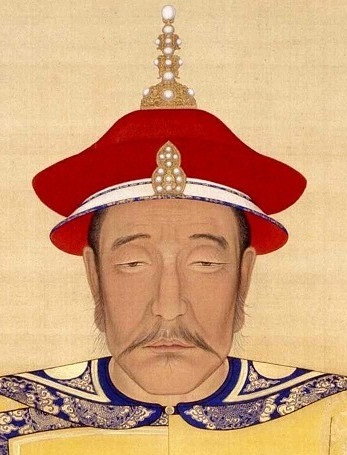 Nurhachi
was a Jurchen who led his clan to prominence in the late 1500s in the
area we know today as Manchuria. He forcibly united numerous
Jurchen clans into a single society and then reorganized the various
Jurchen military units into a more effective fighting structure ... and
was thereby able to restore Jurchen power in the Liaoning
province. In 1616 he named himself Khan and founder of a new Jin
dynasty ... taking for his new dynasty the name of the former
Jurchen Jin. (However his son Hong Taiji would change this
dynastic name to "Qing.") Nurhachi
was a Jurchen who led his clan to prominence in the late 1500s in the
area we know today as Manchuria. He forcibly united numerous
Jurchen clans into a single society and then reorganized the various
Jurchen military units into a more effective fighting structure ... and
was thereby able to restore Jurchen power in the Liaoning
province. In 1616 he named himself Khan and founder of a new Jin
dynasty ... taking for his new dynasty the name of the former
Jurchen Jin. (However his son Hong Taiji would change this
dynastic name to "Qing.") He now turned his attentions to Ming China ... claiming Ming abuse of the Jurchens as his justification for attacking the Ming ... though he was just as glad to take on the Koreans to the East and the Mongols to the North and West. His success in battle soon began to draw Mongols and disaffected Han Chinese into his armies. He was able by 1621 to capture the strategic northern Ming cities of Liaoyang and Shenyang ... but was seriously wounded in a disastrous battle with the Ming in 1626 and died shortly thereafter. Hong Taiji (1626-1643) founds the "Qing" dynasty
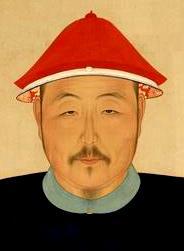 Hong
Taiji was able to take command at his father’s death and continue his
father’s expansion policy. From Manchuria he conquered westward
into Mongolia ... assimilating Mongols as he went. But in his
first effort to invade China he got stopped in 1628 by Ming armies –
with their use of Portuguese cannons (which subsequently he learned to
cast and adapt for his own use). He tried again several times
(with mixed results). But he was able in 1637 to defeat the Josen
Korean allies of the Mings ... thus getting the Koreans to switch their
allegiance from the Ming dynasty to his new Manchu or "Qing" dynasty. Hong
Taiji was able to take command at his father’s death and continue his
father’s expansion policy. From Manchuria he conquered westward
into Mongolia ... assimilating Mongols as he went. But in his
first effort to invade China he got stopped in 1628 by Ming armies –
with their use of Portuguese cannons (which subsequently he learned to
cast and adapt for his own use). He tried again several times
(with mixed results). But he was able in 1637 to defeat the Josen
Korean allies of the Mings ... thus getting the Koreans to switch their
allegiance from the Ming dynasty to his new Manchu or "Qing" dynasty.In the meantime he restyled his political accomplishments, renaming the Jurchens as "Manchus" and his dynasty as "Qing" rather than "Jin." This was apparently part of his effort to merge his Jurchen and Mongol supporters with his Han Chinese supporters ... even requiring marriages among his officials across these ethnic lines to help draw the Han Chinese into even stronger support of his efforts to completely overtake Ming China. Indeed, eventually he had more Han Chinese than Manchus in his governmental service (although the highest level positions were still held by Manchus and Mongols). And it was an army comprised mostly of Han Chinese that he prepared to take on the weakening Ming dynasty to the south of his growing domain. Then as Hong Taiji was about to invade Ming China, he died (1643) ... setting up a huge crisis – because he had designated no heir to follow him upon his death. The Shunzhi Emperor (1643-1661)
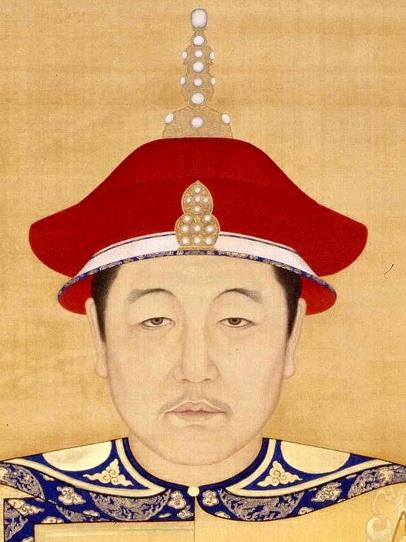 An
agreement was reached among the Manchus to name Hong Taiji’s 5-year-old
son Fulin as the new emperor (the Shunzhi Emperor) ... with Dorgon,
Hong Taiji’s half-brother, acting as regent. Meanwhile with the
suicide of the Ming emperor, Ming officials fell into fighting among
themselves ... as they debated what to do about the peasant rebellions
that had thrown the Ming government into disarray. At this point
Han Chinese soldiers were defecting in mass numbers to the Qing army of
the Shunzhi Emperor (under Dorgon’s command). Then the Ming
commander Wu Sangui took Dorgon’s offer to ally together against the
rebel army ... Dorgon claiming to be avenging the death of the Ming
Chongzhen Emperor caused by the rebel army seizure of Beijing.
Together Dorgon and Wu crushed the rebel army and took control of
Beijing (1644). An
agreement was reached among the Manchus to name Hong Taiji’s 5-year-old
son Fulin as the new emperor (the Shunzhi Emperor) ... with Dorgon,
Hong Taiji’s half-brother, acting as regent. Meanwhile with the
suicide of the Ming emperor, Ming officials fell into fighting among
themselves ... as they debated what to do about the peasant rebellions
that had thrown the Ming government into disarray. At this point
Han Chinese soldiers were defecting in mass numbers to the Qing army of
the Shunzhi Emperor (under Dorgon’s command). Then the Ming
commander Wu Sangui took Dorgon’s offer to ally together against the
rebel army ... Dorgon claiming to be avenging the death of the Ming
Chongzhen Emperor caused by the rebel army seizure of Beijing.
Together Dorgon and Wu crushed the rebel army and took control of
Beijing (1644).At this point the Mandate of Heaven was officially proclaimed to have passed on to the Shunzhi Emperor ... as the Qing held even a formal funeral in honor of the Chongzhen Emperor to mark the transition from the Ming to the Qing dynasty. Then the process of bringing the rest of China under the rule of the Qing got underway ... with Wu working with Dorgon to achieve this task. It would take 17 more years to overcome the last of the Han rebel troops ... and the last pretender to the Ming throne, Prince Gui, who was caught and executed in 1662. Now the process of integrating the Manchu and Han Chinese (by marriage) would begin ... mostly within the military society (which had been eager supporters of the Manchus because of the Ming downgrading of the status of the military in favor of the Confucian scholars in running the country). Ming officials were left in place by the Manchus and Beijing would remain the Chinese capital in an effort to establish among the Han Chinese the legitimacy of the new Qing dynasty as China’s new rulers. But one policy instituted by Dorgon in 1645 would remain very unpopular among the Han Chinese: the order for all men to shave the top-front of their head and wear the queue (or pigtail) at the back Manchu-style (under the Ming the men wore long hair bound in a top-knot). Men caught not obeying this new order were immediately executed ... causing deep resentment and even in places rebellion against this Manchu order. But it was fiercely enforced. When Dorgon died in 1650 during a hunting accident, the 12-year-old Emperor turned to his mother, Empress Dowager Xiaozhuang, to run his government. In reaction to the massive power Dorgon had accumulated during his regency, Dorgon’s family was purged from court and his honors and titles were now taken away. The Kangxi Emperor (1661-1722)
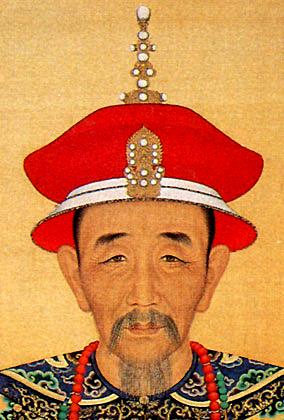 But
the Shunzhi Emperor’s reign turned out to be relatively short, as he
died of smallpox in 1661 at the age of 24. His place was taken by
his son Xuanye who at age seven became the Kangxi Emperor ... reigning
61 years – although effective rule in his early years was held by his
grandmother Xiaozhuang and a series of four regents. But
the Shunzhi Emperor’s reign turned out to be relatively short, as he
died of smallpox in 1661 at the age of 24. His place was taken by
his son Xuanye who at age seven became the Kangxi Emperor ... reigning
61 years – although effective rule in his early years was held by his
grandmother Xiaozhuang and a series of four regents. His long reign would bring bringing China to its greatest extent of landholding. His government would early on (1673) break the rebellion of the "Three Feudatories" in the south of China, finally forcing full unity on the country. His navy would bring the island of Taiwan (1683) under Qing dominion. To the north of China, he blocked Russia’s eastward expansion across Asia from reaching south below the Amur River (1689) ... and brought the various tribes of the northern reaches of Manchuria and "Inner Mongolia" (1690-1696) under Qing dominion. To the West, the attempt to control Tibet (and its Buddhist Dalai Lama governor) proved to be more complex – requiring constant action and not much success ... until in 1720 a huge Qing army was finally able to seize Tibet’s capital city, Lhasa. The Kangzi Emperor worked long and hard to make his rule a success, encouraging Han scholars to refine the writings and histories of Confucian China. He himself studied the Confucian classics ... much like any of his Mandarin (Confucian bureaucrat) officials ... and he was vigilant in maintaining the integrity of the Confucian exam system that recruited his bureaucratic officials. He was intrigued by Western technology and culture, brought to him by a large number of Jesuit priests sent to China by the Roman pope (the Kangzi Emperor authorizing in 1692 the toleration of Christianity and its missionary activities in the country).11 He also set up a Grand Council which brought him information for deliberation that by-passed the often slow-moving and at times obstructionist Mandarin bureaucracy ... allowing him to stay on top of events around his realm. And his efficiency allowed him even to lower some of the taxes on his subjects ... yet maintaining the fiscal health of his imperial treasury. The only blemish in this outstanding reign occurred over the matter of succession ... especially as the emperor grew older – and especially as he had a huge number of sons hoping to receive the Qing throne upon his death. His son Yinreng was named crown prince and thus raised with the expectation of inheriting his father’s throne. However over the year Yinreng demonstrated terrible character traits (sleeping with his father’s concubines – and young boys) ... and began grooming a support group designed to speed his access to the throne. In 1707 his father had had enough and removed him as crown prince ... opening up a crisis concerning who would now inherit the crown prince position. Yinreng was finally restored by his father to his previous position in 1709 ... but got caught in a plot to depose his father in 1712 and his father returned him to house arrest. For the next ten years the issue of succession was effectively suspended and no crown prince was announced. Finally at the end of 1722, the dying Emperor announced that his 4th son, Yinzhen would replace him (as the Yongzheng Emperor). The Qing dynasty reaches the height of its power under the
Yongzheng and Qianlong Emperors (1723-1735 and 1735-1796) Yongzheng. Upon taking office, the Yongzheng Emperor moved to tighten discipline within the palace and the massive bureaucracy. He also tightened further the Confucian position at the center of Chinese culture – expelling Christian missionaries and basically outlawing Christianity. He moved to tighten tax collection to remedy the worsening economic conditions that had set in upon China during the last years of his father’s rule. This brought some degree of fiscal discipline in the north ... but his Mongol inspectors found themselves greatly resisted by deceptive officials in the south of the country – where the financial crisis continued. 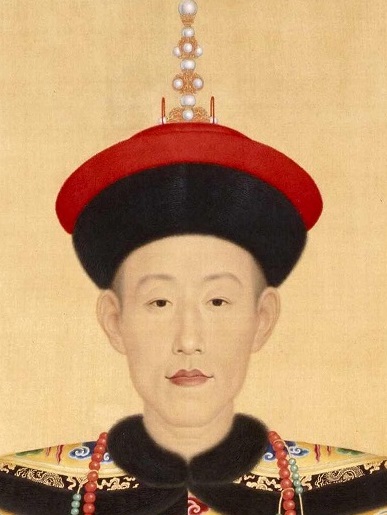 Qianlong.
When the Yongzheng Emperor died in 1735, his place was taken by his
son, Hongli (or Prince Bao), who took the throne as the Qianlong
Emperor. Several main features of the Qianlong Emperor’s long
rule stand out. Qianlong.
When the Yongzheng Emperor died in 1735, his place was taken by his
son, Hongli (or Prince Bao), who took the throne as the Qianlong
Emperor. Several main features of the Qianlong Emperor’s long
rule stand out. The first was his great interest personally in Chinese culture, especially in the arts and in literature. He amassed a huge art and craftware collection for himself ... and he sponsored (employing thousands of copyists) the compiling of a collection of Chinese literature in 36,000 volumes. But the literature was carefully censored ... with thousands of works banned (and hundreds of thousands of copies burned) if they included negative comments about either the Manchus or more particularly the Qing dynasty. The second was his equally stern and even exceptionally cruel hand in dealing with troublesome societies ranged along the Chinese frontier. The worst instance was in his dealings (1755-1757) with the Dzungars, a group of nomadic Tibetan Mongol tribes living in the western region he renamed Xinjiang (still known by that name today) ... committing virtually mass genocide in the way he largely eliminated this entire society: hundreds of thousands (400 or 500 thousand?) were killed by his troops or by exposure and disease (particularly rampant smallpox) caused by his merciless assault on their land ... with over a hundred thousand others being forced to flee to neighboring regions. Han Chinese and Manchus (and some Turkic Uyghur tribesmen) were then resettled in the vacated lands. The third main feature of his rule was how his tough hand brought peace to the land ... which in turn brought massive growth of the Chinese population ... to a point where the huge population growth presented its own major problems. The Han population needed to be resettled in the border areas in order to accommodate this huge growth. The most obvious area was to the north of China, above the Great Wall ... that is, within the more sparsely settled land of the Manchus and Mongols. But there were strict laws protecting the north from exactly such Han settlement. But as the population reached something around 300 million (it had been 100 million at the beginning of the 1700s) the Qianlong Emperor changed the policy and began to resettle Han Chinese by the hundreds of thousands in southern Manchuria ... so that by the end of the century the Han Chinese outnumbered the Manchus in the fast-growing cities of Manchuria. The fourth main feature was found in how that long realm of peace brought in its later years a decline in the readiness of his military and in general a relaxing of his supervision of the massive bureaucracy – producing on both counts a rise in the level of political corruption that seemed to infect the Qianlong Emperor’s reign during his last years. The emperor seemed to lose interest in political affairs, indulging himself in his love of the arts and leaving his government to very corrupt public officials. The corruption registered itself most noticeably in the change from a huge surplus in the imperial treasury during the first half of his reign ... to quite the opposite in his last years: a massive shortfall in tax revenues in comparison to the government’s lavish expenditures – and the massive size of the embezzlement (12-years worth of treasury surplus) taken by the massively corrupt counselor Heshen. Taxes were raised again and again in order to try to cover the shortfall ... at a time when public works projects protecting the Chinese from floods and relieving them from droughts were left abandoned. All of this inevitably led to massive rebellion in the provinces – the most threatening to the dynasty being the White Lotus Rebellion, which started up in 1774 and reached extremely serious proportions after 1796 (before it was finally bloodily crushed in 1804). Clearly at this point the Qing dynasty was facing the first stages of decline ... a trend that would continue through the next century (the 1800s). In 1796 the Qianlong Emperor stepped down from his position – insisting that he would not stay in power longer than his grandfather (61 years) and appointed his son, the Jiaqing Emperor to take his place ... although the Qianlong Emperor tended to hold ongoing power from behind the throne – until his death in 1799. The Jiaqing Emperor (1796-1820)
One of the first things that the new emperor did upon the death of his father was to force former counselor Heshen to commit suicide ... as part of the emperor’s effort to cleanse the Qing government of the corruption that engulfed it. He also had the White Lotus anti-tax rebellion to deal with ... along with the rebellion of the Miao people in the south of China. He was determined to settle the country down and return it to peace and prosperity. Chinese sensitivity to European intrusions into Chinese affairs deepened drastically at this point. In 1811 the attack on Christianity (identified at that time simply as Catholicism) was ramped up with making the spread of Catholicism punishable by death. But the biggest problem he faced in this area was the loss of China’s silver supply, which was going to buy the vast amounts of opium being imported into China from India by the British merchants of the British East India Company. The rising problem of British opium sales to China
Attempts had been made earlier in the mid-1700s to regulate a growing East-West trade ... by the Chinese emperor’s granting of a small and tightly defined coastal trading post at the southern port of Canton to European traders who showed up at the Chinese doorstep (the English and Dutch at this point primarily). At first these Europeans appeared to be no more than typical foreign dependencies ... with little to offer (or threaten) Chinese society and culture – and thus seemingly coming in ‘tribute’ to the superior authority of Chinese government and society. And indeed it certainly looked that way. The problem for the Europeans was that the demand for Chinese porcelain, silks, (and, very importantly to the British, tea) and other refinements was not met with a similar interest on the part of the Chinese for things European. Chinese society appeared to be entirely self-sufficient in all social aspects. In an attempt to gain some leverage, some advantage for themselves – to ‘equalize’ this vital East-West trade – in 1793 the British sent a special delegation to the Chinese court of the Qianlong Emperor to work out a much larger commercial arrangement as ‘equals.’ But the Emperor dismissed the effort, assuring the British that the Chinese had no need for anything coming from the Europeans ... except the silver by which the Europeans purchased Chinese goods. The Chinese could always use European silver. But that relationship was beginning to change on its own, despite official policy. The British were quick to detect a ready market in China for the sales of opium, produced under British direction in the Indian Bengal province. Thus the British pressed ahead with the request for a small trade concession with this highly addictive drug ... getting a small foot in the Chinese door that would soon enough throw the Chinese door wide open to British (and European) ‘trade’ in China. In 1817 the British negotiated a trade deal with the Jiaqing Emperor, allowing the opium trade because it gave the revenue-short Chinese government a new tax source and the British East India company the revenue to expand their tea purchases from the Chinese governmental monopoly. It looked like a win-win situation for both the British and the Qing government. The Daoguang Emperor (1820-1850)
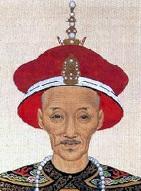 The
Jiaqing Emperor died suddenly (and mysteriously) in 1820 and his place
was taken by his grandson Mianning, who took the imperial name
Daoguang. Mianning had distinguished himself earlier for the way
he defended the Forbidden City from an attack by members of the White
Lotus in 1813. He was by all instincts a hunter and
warrior. As emperor he was able to suppress a tribal rebellion
(1826-1827) that erupted in the Xinjiang Province early in his reign. The
Jiaqing Emperor died suddenly (and mysteriously) in 1820 and his place
was taken by his grandson Mianning, who took the imperial name
Daoguang. Mianning had distinguished himself earlier for the way
he defended the Forbidden City from an attack by members of the White
Lotus in 1813. He was by all instincts a hunter and
warrior. As emperor he was able to suppress a tribal rebellion
(1826-1827) that erupted in the Xinjiang Province early in his reign.But he had much bigger problems awaiting him from the Europeans, especially the British and their opium trade. The Daoguang Emperor – as also much of Chinese officialdom – had a very hard time of it understanding the nature of the challenge posed by these European "barbarians." At first they appeared to be no more than a typical group of troublesome foreigners positioned along China’s borders, much like the tribes to the north and west of China. But these strangers who arrived on China’s shores to the south came armed with a technology and military organization that vastly outpaced the tribal raiders of the north in terms of the threat they posed to the integrity of Chinese society and culture. And it was not just their Christianity and their opium ... although those were formidable challenges enough to a Chinese dynasty and society having an increasingly hard time of it holding things together. The Qing Dynasty was itself undergoing the decline typical of dynastic cycles ... at a time that the Europeans were organizing massively for a global imperialist urge that would roll back any society and culture that confronted them. The First Opium War (1839-1842)
Ultimately it would be the single issue of the sale of British opium that would set off this massive struggle between Chinese and European cultures ... a struggle that would swing very much in favor of the Europeans over the next century. The Daoguang Emperor came quickly to understand the economic damage the opium trade was causing China – as increasingly large amounts of silver were leaving China for the purchase of opium. But also apparent was the social-cultural damage the opium trade was inflicting on the Chinese population, now "hooked" on the drug. The Chinese demand was proving to be overwhelming. Efforts were made to stop the trade ... but corrupt Chinese officials benefitted so greatly from bribery which opened China wide that the Qing government lost all control over the regulation of the movement into China of the deadly drug. The declaration in 1838 of the death sentence awaiting Chinese drug traffickers did not seem to have much effect on the trade. Meanwhile the British12 were growing increasingly irritated at the Chinese government’s refusal to allow the principle of ‘free trade’ to control the economic relations between the two countries. For the British Whigs who ran the British government this principle of free trade was at the center of everything they stood for politically ... and they were not going to let some Chinese government stand in its way on the basis of misguided principle.13 Finally in 1839 a frustrated Daoguang Emperor authorized the seizure of tens of thousands of chests of opium and the blockading of the port of Canton ... provoking a British response in the form of a gun battle that destroyed a great number of Chinese ships. The next year (1840) the British East India Company showed up with an Indian army (Sepoy troops) and a well-armed navy and took the port of Canton from the Chinese. Then in 1841 the situation even worsened for the Chinese as the Chinese found themselves at war with Indian Sikhs in Western Tibet ... as well as the British who had expanded their operations along coastal China. But from there the British then moved inland (1842), defeating the Chinese in the Yangtze River valley and at the Grand Canal ... and seizing the strategic cities of Shanghai and Nanking (Nanjing). Consequently, the Chinese were forced to sign the humiliating Treaty of Nanking, which granted Britain extensive trading rights (and missionary activity) in a number of China’s port cities, plus huge reparations payments from the Chinese government for financial losses suffered by the British in this struggle. And the port of Hong Kong would be turned over to the British as British – not Chinese – territory. Nothing was specifically mentioned about the opium trade. Two years later, both the Americans and French also received a number of trading concessions from the Qing government. And the war with the Indian Sikhs, which also ended in 1842, resulted in the Qing having to acknowledge the Sikh Empire’s control over Western Tibet. The loss of face of the Qing in these conflicts would not go unnoticed by the Chinese people. The Xianfeng Emperor (1850-1861)
The Taiping Rebellion (1850-1864). Yizhu was the fourth and favorite son of the Daoguang Emperor ... who in 1850 inherited his father’s throne as the Xianfeng Emperor at the age of only 19. Immediately (the end of 1850) he was faced with a major rebellion that would take longer to bring to an end than he himself was on the throne ... and would be the bloodiest of all uprisings in Chinese history. The rebellion – actually something like a true civil war – began when Qing forces in the very south of China confronted the "God Worshiping Society" led by a strange self-proclaimed mystic Hong Xiuquan ... who claimed to be a younger brother of Jesus Christ. Hong also claimed that he had been called by God to rid China of devils ... among them the corrupt Qing government. Up to that point (1850) Hong and his followers (the Taiping) had focused their efforts mostly in clearing the south of local bandits and pirates. Qing troops sent out to curb the growth of this Taiping Movement however succeeded in getting themselves routed by the Taiping (the beginning of 1851). To cover this embarrassment, more Qing troops were sent out ... and the Taiping simply took to the hills to begin a guerrilla-style war against the Qing. Little by little the Qing lost ground to growing Taiping armies. The situation became extremely serious when in 1853 the Taiping were able to seize the strategic city of Nanjing ... slaughtering whatever Manchu inhabitants they found there and then making the city their headquarters. Whereas the Taiping Movement found wide support among Chinese commoners ... upper-class Chinese were repulsed by the strange, non-Confucian character of the movement and opposed it as best they could. The Europeans decided to stay neutral in the affair. And as for the Qing, they seemed to be unable to stop the Taiping, whose armed movement spread across China. But the movement was already suffering from Hong’s lack of interest in commanding the movement (he was enjoying the pleasures of palace life in Nanjing), a local Han army (the Xiang Army) under the excellent command of Zeng Guofan had organized to oppose the Taiping, and the British General "Chinese Gordon" was now commanding a Qing military unit also moving strongly against the Taiping. The turning point in the war came in 1860 when the Taiping held off a Qing attempt to retake Nanjing ... while they themselves however failed to capture Shanghai. Gordon’s army stopped a second attempt of the Taiping to take Shanghai in 1862 ... and Taiping fortunes began to decline visibly thereafter. Then Hong died in 1864 just as the Qing were making another effort to retake Nanjing ... and leaderless, the Taiping lost the battle for Nanjing and most of the surviving Taiping leadership was executed. The movement continued in the hills for a few more years. But after the fall of Nanjing the Taiping Rebellion was basically over. The net result was that the long civil war made very clear the depth of the weakness of the Qing dynasty’s hold over China. From this point on, the decline of the dynasty would be unstoppable. The Second Opium War (1856-1860). Meanwhile, at the same time that China was caught up in the massive Taiping Rebellion a second round broke out in the war between China and the West – principally the British and the French, but occasionally the Americans as well – over the issue of the West’s growing economic and political position in China. The Chinese confronted these Westerners in various minor incidents which became major issues of national pride on all sides14 – Western as well as Chinese – bringing the two sides into increasing military conflict along the various port cities of southern China. At first the Western action was mostly by the British. But when a rebellion broke out in British India among the British East Indian troops (the Sepoy Rebellion) in 1857 – which to the British was a much bigger matter than the troubles in China – the French took a much larger role in this growing conflict with Qing China. In 1857 the British Government of Palmerston was facing a national election ... and the issues of both the Sepoy Rebellion in India and the growing conflict in China were issues at the very center of the elections between a seemingly equally divided British electorate. Both British national pride and the policies of the British Government in handling these crises – plus some strong British sympathies with the Qing dynasty struggling to retain some degree of social order in China – were under intense debate. Ultimately the spirit of British nationalism swung behind the Palmerston Government increasing its majority position in Parliament ... and stiffened British resolve to force the Qing Government to pay for slights to British prestige in China. The "unequal treaties." British negotiations – joined by the French, Americans and also Russians – led in 1858 to a Treaty forcing on the Chinese a number of humiliating concessions to the Westerners: the opening to the West of ten more Chinese port cities – including the capital Beijing – the Yangtze River and even the interior of China as well ... and a large indemnity paid by China to the British and French. The Chinese resentment to these terms inspired Chinese officials to attempt a military challenge to the treaty in 1859. But with the Sepoy Rebellion in India finally put down – in 1860 the British and French military (actually well served by Chinese soldiers who had joined them) responded by capturing port city after port city and then heading inland to seize Beijing ... and burning the Qing’s Summer Palaces to the ground. As a result, the indemnity imposed on the Qing government was increased ... and the Manchus were forced to give up part of their position on the Pacific Ocean to the Russians – who proceeded to found the key Russian Pacific port city of Vladivostok there. The Dowager Empress Cixi (1861-1908)
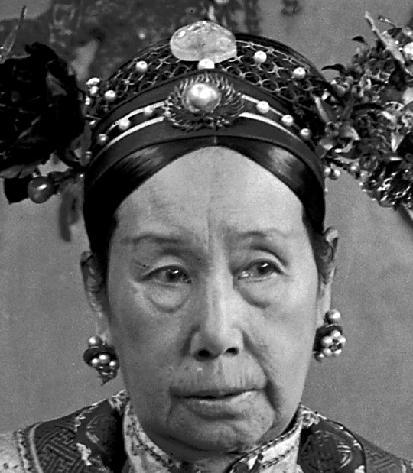 The Tongzhi Emperor (1861-1875).
With the death of the Xianfeng Emperor in 1861, the Qing once again
found themselves led by a child emperor (only five when taking the
throne). Naturally it would be at this point regents and not the
emperor who would rule China ... the most notable and enduring being
the Emperor’s mother, the Dowager Empress, Cixi (or Tz’u-Hsi).
While she shared the regency with others she was definitely the one who
commanded China ... all the way until her death in 1908. She and
her ally, the Dowager Empress Ci’an,15
worked together (thus the reign title "Tongzhi" meaning "ruling
together") ... and were able to block an effort of other regents to
depose the two of them. The Tongzhi Emperor (1861-1875).
With the death of the Xianfeng Emperor in 1861, the Qing once again
found themselves led by a child emperor (only five when taking the
throne). Naturally it would be at this point regents and not the
emperor who would rule China ... the most notable and enduring being
the Emperor’s mother, the Dowager Empress, Cixi (or Tz’u-Hsi).
While she shared the regency with others she was definitely the one who
commanded China ... all the way until her death in 1908. She and
her ally, the Dowager Empress Ci’an,15
worked together (thus the reign title "Tongzhi" meaning "ruling
together") ... and were able to block an effort of other regents to
depose the two of them.Unfortunately the young emperor as he grew up demonstrated not the resolve to mature like earlier child emperors ... but proved as a youth to be dismissive of his advisors and dangerously dissolute in how he went about his personal life and business as emperor. But he died at the age of 18 (1875) of smallpox ... creating something of a succession crisis because he left behind a pregnant wife, but no sons to take his place. The "Tongzhi Restoration" (1860-1874). Nonetheless, during this Tongzhi period, social and political reforms were introduced by the two Dowager Empresses to try to discipline dynastic rule ... involving both an attempted revival of traditional Confucian bureaucratic standards and at the same time some modernization of the Chinese military and industrial infrastructure (railroads, factory operations, military equipment and organization). The Chinese nobleman and general Zeng Guofan (most responsible for crushing the Taiping Rebellion) was given the lead in implementing these changes. And indeed China seemed to settle itself down during this period – if not ending the decline of the dynasty, at least putting a pause to that decline. The Guangxu Emperor (1875-1908). Upon the Tongzhi’s death in 1875, the Dowager Empress moved immediately to have the emperor’s four-year-old cousin Zaitian take the throne as the Guangxu Emperor. The imperial family agreed to the decision ... and the Dowager Empresses Cixi and Ci’an continued as China’s governing regents. Not until 1889, however, would the young Guangxu Emperor actually take up the affairs of state ... although the Dowager Empress Cixi would still continue to influence policy from behind the scenes. The French takeover of Cochinchina (Southern Vietnam) 1859-1867
Meanwhile, to the south of China, a crisis developed over efforts of Catholic missionaries to bring the Vietnamese to the Christian faith – and the reaction of local authorities to that effort. Vietnam (composed of Tonkin in the North, Annam in the center, and Cochinchina in the south) was a society that China had considered to be part of its own imperial orbit. But France was intending to place its own imperial grip over the region. The French effort began in 1858 when the Vietnamese Emperor Tu Duc executed two Spanish Catholic priests (by no means the first of such events in Vietnam) at a time that the French were in the region in large force during the Second Opium War. A joint French-Spanish expedition aimed at punishing the imperial government of Vietnam for this grand insult to the dignity of Christian Spain (and France) succeeded in capturing the strategic city of Saigon (center of the vital rice trade) ... and then holding off efforts of the Vietnamese military to retake the city. Then with the Opium War over in China, the French and Spanish Filipinos (with some help from the Americans in 1861) slowly reduced Vietnamese power and forced the Emperor Tu Duc in 1862 to finally agree to some harsh peace terms: the free and well-protected practice of Christianity throughout Vietnam, the opening to the French of a number of coastal ports in Tonkin and Annam, the surrender of most of Cochinchina and its Saigon capital to French control, and a huge indemnity payment to the French and Spanish. Three years later the rest of Cochinchina was turned over to the French ... and the Kingdom of Cambodia requested the French for status as a French Protectorate (against an expansionist Siam or Thailand). Thus was laid out the foundations of what would become French Indochina. The Tientsin (or Tianjin) incident (1870)
Then in 1870 an incident would occur which would involve directly the Qing government with the French. French nuns operating a Catholic orphanage in Tientsin (a major northern port city and gateway to Beijing) were suspected by the local Chinese community of practicing deadly rites,16 leading an angry mob to burn to the ground numerous churches and to rape and kill ten nuns, plus kill two priests, numerous Chinese Christians, some Russian traders (presumed by the Chinese to be French) ... plus two French consular officials attempting to get local authorities to stop the riots. Angry Westerners sent gunboats to Tientsin to quell the riots ... and an embarrassed Qing government reacted quickly to punish the perpetrators – and to apologize officially to the French government. But the net result of the incident was a darkened mood on the part of both the Chinese and the Westerners. The Chinese were incensed at how easily the Europeans moved on their own, without official approval, to impose their own sense of order. And the Europeans no longer trusted the Qing officials to protect their missionaries – or even their traders – and were determined to provide that protection within China themselves. The rise of the Japanese
The Tokugawa or Edo Period. The Japanese in the late 1500s were caught in an intense debate over the challenge that an expansionist West was posing to the integrity of Japanese society. Christianity had been making great inroads into the country by the late 1500s ... along with the military and early industrial technology of the West. Finally in the year 1600, the winner of a three-way struggle for power among Japan’s largest clans and their daimyo or lords brought the powerful Tokugawa clan to dominance in Japan ... and their daimyo Ieyasu to the position of Shogun, or military overlord. Ieyasu put into effect a number of laws in 1612 designed to eliminate Christianity, then in 1629 undertook the slaughter of thousands of Japanese Christians – and in 1635 moved to essentially close the country to all outside influences (the sakoku policy). For the next two hundred years a very rigid, but quite politically stable, feudal society – under the absolute rule coming from the Edo Palace of the Tokugawa Shoguns – held itself firmly in place in Japan. The "opening" (or Bakumatsu) of Japan. The seeming security of isolated Japan came suddenly to an end when in 1853 American navy Commodore Matthew Perry, sent to Japan to open up trade between Japan and America, boldly ignored the orders of a sickly Shogun to respect the policy of sakoku ... and instead made a visible and quite huge demonstration of American sea power to the shocked Japanese. He left a letter of diplomatic demands with the Japanese bakufu (government) with the promise of returning a year later to hear the Japanese reply, though in fact he came back six months sooner with an even larger American fleet. The Japanese bakufu agreed to open Japan to American trade. But the confusion this left both Japanese society and its bakufu became critical. The bakufu decided (the Ansei Reform of 1854-1856) to enter into a relationship with the Dutch as a counterbalance to the Americans ... although some of the Japanese daimyo were strongly opposed to change. In any case, over the next few years the Americans managed to acquire even more extensive trade rights from the Japanese. And the Japanese confusion even deepened further ... drawing not only formerly excluded clans but also the Japanese Emperor – highly respected but usually above the matter of actual political decisions – into the debate: should Japan attempt to retrench more deeply into its traditional strengths, or began to adapt the ways of the West that seemed key to the West’s obvious strengths? Various Japanese leaders took one side or the other in the debate. But the side favoring the Westernizing of Japanese society clearly began to gain the upper hand. The Japanese intended to develop a Western-style military and navy with all due speed. Then with the incident in 1862 between the British and local samurai of Satsuma, which turned into a brief (1863) but humiliating battle for the Japanese, the urgency of military modernization seemed even more self-evident to the bakufu. The "Meiji Restoration." In 1867 the Japanese emperor died and his 17-year-old son, Mitsuhito, became the Emperor Meiji. He formed a close bond with a number of reformist daimyo who had the clear intention of bringing the young emperor forward as more than just a religious figure. Then when later that year the Tokugawa Shogun turned his power over to the Emperor and retired, all governing power seemingly found itself in the hands of the Meiji Emperor. Actually it took the Boshin War early the next year, in which the Emperor’s troops crushed a Tokugawa army, to make it clear that the Shogun’s powers had indeed come to a complete end. Tokugawa lands were turned over to the Emperor. But then other daimyo also agreed to surrender title to their lands to the Emperor, creating a fully centralized Japanese state and society. Now the principles of the Emperor’s 1868 Charter Oath could be put into full operation: Japan was going to modernize technologically along Western lines, though preserve the most important features of traditional Japanese culture. And this program would be overseen by a council of imperial advisors acting in the Emperor’s name. The feudal system and rule by the clan daimyo of the Tokugawa Period had thus come to an end. And the Japanese society was put under military conscription requiring all males to give the nation four years of military service – thereby undercutting the exclusive military privileges enjoyed by Japan’s extensive samurai military caste. Japan was developing a modern military (and navy) on the same scale and capabilities as the mighty Western armies and navies that were overrunning Asia. And Japan would be backing up that force with its own newly industrialized society, meeting its own manufacturing needs within Japan itself. Japanese imperialism. It was by all evidence from the behavior of the mighty Westerners in the affairs of the Asian societies, the unashamed "Age of Imperialism." Modeling themselves after the Germans, whom the Japanese seemed to admire most and on whom they based most of their interpretations of social, economic and political "modernization," the Japanese soon found that they were as well equipped to play the imperialist game as any of the Western powers. As with the West, part of the motivation was simply national pride. Japanese mercantilism. But a big part of it was also what was understood at the time as economic necessity: securing sources of needed raw materials and in turn markets for their finished industrial products (a program long known as "mercantilism"). Japan was strangely devoid of most raw materials it would need to industrialize fully. Thus it required a secure source of such basic products. In developing an industrial economy it was able fairly easily to secure sources of industrial investment: its own nobility plus interested foreign investors. But as a rising industrial producer, Japan would need to be able to have an equally secure market for selling (profitably, of course) its finished industrial products. Sino-Japanese tensions over Korea (1884-1885). Thus Japan looked west to the Asian mainland for lands it could secure as part of its much-needed mercantile empire. The first target was nearby Korea (rich in coal and iron ore), which in 1884 underwent a coup attempt against the Korean royal family, in which the Japanese supported the reforming party. But the effort failed when the Chinese dispatched an army under Yuan Shikai, forcing the Chinese and Japanese plotters to have to flee to Japan. Yet the peace terms agreed upon by Japan and China over this incident attempted to neutralize Korea ... which under the Qing had been a Chinese dependency. However, the Chinese basically ignored the terms of the agreement and appointed Yuan Shikai as Korean governor. But the Japanese were not finished with Korea. The Sino-French War / the Tonkin War (1884-1885)
While the Chinese were busy dealing with the Japanese in Korea the French were expanding their operations from Cochinchina north to the Tonkin region in Vietnam just below China. The crisis that erupted between the Chinese and the French over the area originated with French interests in spreading Catholicism to the region ... and using it as a gateway into China for their tradesmen, avoiding the restrictions at the ‘open’ trade ports monitored by the Chinese. But what stood in their way was a local Chinese independent army of "Black Flags" ... that the poorly equipped Vietnamese appealed to for help in dealing with the aggressive French who had just seized the Tonkin capital of Hanoi (1882). Conflicts between the French on one side and the Vietnamese and Chinese Black Flags on the other grew during the next year (1883) ... provoking the French to mount a full-scale invasion of China to go after the Black Flags in 1884. The Qing were ready to fight just such an invasion ... and the two sides met in battle in Tonkin ... with the Chinese faring poorly. The Dowager Empress Cixi decided that a negotiated settlement was thus the better route for China to take at this point. And thus it was that a French "protectorate" over Tonkin and Annam was formally recognized by the Chinese. But the local Chinese – nor the Vietnamese – took to this agreement ... and the conflict continued. At this point the battle between the two groups (now mostly the French against the Qing military) took on serious proportions. The French navy destroyed Chinese navy ships at Fuzhou, killing thousands of Chinese ... and creating a general patriotic outrage of the Chinese against not only the French but all Westerners in general. The French navy continued to inflict severe damage on the divided Qing navy (the rival northern admiralty refused to help the southern admiralty). Meanwhile back in Paris, there was much political controversy brewing over the "Tonkin Affair" as the action was termed. And the Chinese were at this point deeply engaged against the Japanese over Korea. Thus once again a peace settlement was agreed on between the warring parties in 1885 ... and held this time (although local Vietnamese insurgency and ‘piracy’ would continue sporadically into the 1890s). The French had also inserted themselves into Taiwan ... although their position there was weak and they eventually abandoned the island. The First Sino-Japanese War (1894-1895)
Meanwhile – despite the 1885 agreement – Japan had not lost interest in Korea and in 1894 sent its army to seize and establish a puppet government in Korea, one that it could control. War with China naturally resulted, but this time producing in 1895 a major humiliation of the Chinese army and navy by the Japanese. The Shimonoseki Treaty of 1895 ultimately called for the complete independence of Korea and the withdrawal of all Chinese and Japanese troops from Korea; but also the loss of both the island of Taiwan17 and the Liaodong Peninsula18 to Japan (which Japan had seized during the conflict); the opening of a number of Japanese ports to Japanese traders; and the payment by China to Japan of a huge indemnity. Now the Chinese found themselves humiliated not only by the aggressive Westerners, but also by the ‘barbaric’ Japanese. Japan was acting in China exactly the same way that the Westerners were. Not surprisingly, at this point the Qing government found itself under debate along much the same lines that had so engaged the Japanese just prior to the Meiji Restoration in Japan: how could China hold onto it traditional culture? Did it need to modernize along Japanese or Western lines? The "Hundred Days Reforms" (1898)
In 1898, with China virtually falling apart (Westerners at this point were scrambling to grab Chinese ‘concession’ territory as Qing authority was crumbling), the young Guangxu Emperor attempted deep modernizing reforms of the Chinese government. But this was early on blocked in something of a palace coup by conservative officials – led by the Dowager Empress Cixi – who put the emperor under house arrest.19 The "reformers" had actually attempted to assassinate the Dowager Empress .. who not only struck back at the reformers but had some strong "reform" ideas of her own as to how China should respond to the growing threats to the dynasty’s existence. The Boxer Rebellion (1899-1901)
Then Chinese commoners took action of their own to address this problem of Western intrusion into their "Central Kingdom." Actually a series of factors came together at the end of the century which pointed to the massive rebellion known in the West as the "Boxer Rebellion." In the Shandong province just south of Beijing20 a serious drought – then floods – devastated the countryside, causing farming families to have to take economic refuge in the cities – a sure sign of social breakdown. Then too, there was the growing interest among Chinese men for membership within the military societies that were springing up here and there ... societies dedicated to fighting for great causes that the men hungered for amidst this Chinese moral-social drift. Some martial groups seemed particularly dedicated to overthrowing the Qing dynasty, others to removing the barbaric threat of the Westerners and their Christian religion ... and some to both causes. Furthermore, these groups seemed to believe that they possessed some special divine powers, even divine protection. Some went so far even to claim that they were divinely protected from not only the slings and arrows of their adversaries ... but even from the bullets and cannonballs of the Westerners. The Boxers. The one group that drew immediate attention was the militia known as the "Righteous and Harmonious Fists" – a title shortened by the Westerners simply as the "Boxers." In October of 1898 a group of Boxers attacked a church (that had formerly been a Daoist temple) – but were shut down by Qing soldiers who killed 27 Boxers ... and caught and executed the leaders. Imperial support. But this would not be the end of this group ... attracting not only the interest of other Chinese, but even some officials in the Manchu court (especially the Dowager Empress Cixi and the other anti-reformists) – who saw in this movement natural allies in their effort to rid the country of the detested Westerners. Thus as the movement spread among the Chinese, in early 1900 the Dowager Empress swung her official support behind the growing Boxer movement. Boxer initiatives. That same spring the Boxer movement began to spread from Shandong toward Beijing, Boxers burning churches and killing Chinese Christians (whom they considered to be Chinese traitors) as they went. By early June they had seized the rail lines into Tientsin (Tianjin) and Beijing was thus cut off from the sea. And units of the Chinese army guarding Beijing seemed themselves to be as hostile to the Westerners (and Japanese) as the Boxers. Then the Boxers broke into Beijing, burning churches and killing Christians as they went. American, British and German soldiers protecting the diplomatic quarters fired on the attacking Boxers ... driving much of the Chinese population of the city to fury. The Europeans were finding themselves isolated. When the Western diplomats refused Cixi’s order that they leave Beijing under military escort (the Westerners rightly did not trust the Chinese army at this point) the Dowager Empress made it now a matter of all-out war between the Westerners and the Chinese. But many of the Chinese generals refused to join her in the battle with the Westerners (powerful Shandong governor Yuan Shikai actually moved on his own against the Boxers). Then from mid-June to mid-August (1900) the diplomatic quarters of the Forbidden City housing the Western embassies and legations remained under siege by both the Boxers and elements of the Chinese military. But the Westerners (and Chinese Christians gathered with them), despite the huge loss of life on their side, managed to hold out against their attackers ... because the Chinese for mysterious reasons did not use their vastly greater numbers to invade the quarters directly, only shell it and undermine it with explosives. The Allied counter-attack. Then in August as an 8-nation Western and Japanese army of 20,000+ men fought their way forward from Tientsin to the gates of Beijing, the Dowager Empress Cixi decided it was time to sneak out of the imperial capital. Also Manchu General Ronglu’s troops moved to help force Chinese troops attacking the Western embassy area to back off – thus helping the foreign troops reach Beijing. By mid-August the Boxer and Chinese imperial army troops in Beijing had been routed and the Western Legation Quarter liberated. At this point the Boxer rebellion was over. But now the 8-nation allies began to take their revenge. Beijing was looted of its treasures (shipped back to Europe or America or Japan), thousands of Boxers executed, their property confiscated (some of it given to the Chinese Christians in compensation for their suffering), and Chinese women raped and killed by the allied troops. The German troops who arrived too late for battle nonetheless also participated in the ravaging of the Chinese – the Germans said to be the worst of the lot. But the war was not over. Although the capital Beijing and its all-import port city Tientsin had been taken by the allies, the Chinese seemed determined to carry on their fight against the foreigners from the interior of the country. But the Dowager Empress saw that continuing resistance was useless, and agreed to negotiated terms ... that allowed her to return to Beijing to rule the country. But peace came at a heavy price for China: huge reparation payments in silver by China to the Westerners, massive payments to take place annually over the next 39 years. The Open Door Policy (1899). Nonetheless, China avoided being carved up into separate colonial territories belonging to one or another of its adversaries. The Open Door Policy had been put forward by the American Secretary of State John Hay in 1899 ... and backed solidly by the British because of two key ideas embraced by both the Americans and the British. 1) Keeping China open to all foreign traders would offer the entire country as a market for any skillful entrepreneur (such as the Americans and British understood themselves to be). In a sense this was simply the extension to China of the American Monroe Doctrine which had been earlier in the century put in place to keep all of Latin America open to free trade (again, with the British and Americans benefitting the most from this policy). 2) It seemed obvious at this point that China would be easier to work with by dealing directly with a single Chinese imperial government in Beijing ... rather than with the multitude of local lords and their respective governments that any division of China would engender. The Japanese now become China’s biggest headache. But perhaps the most important outcome of the war was the stepping back of the West from its previous extremely active political involvement in Chinese affairs ... and instead the considerable stepping up of Japanese involvement in place of the Western involvement – the kind of involvement that would now place the Chinese and Japanese in almost constant cultural, economic, military and political contention with each other. China’s "New Policies." In 1901 Dowager Empress Cixi announced a series of social-political reforms, hoping to bring China forward so as to be better able to answer the challenges posed by the Westernized world (including Japan) ... and the threat to the Qing dynasty posed by disillusioned Chinese. The traditional Confucian schools were replaced by schools teaching a more Western curriculum, the Chinese legal and penal system was modified so as to operate along more Western lines, military academies were set up to instruct soldiers along Western military lines, and the tax collection system was reorganized and disciplined to cut out the corruption that had crippled the tax system. Then in 1908 directives along constitutional lines were issued by the Qing government ... providing in progressive stages for China’s first elections: locally, then in 1910 provincially, then in 1912 nationally. Accordingly, legislative assemblies were to be put in place at all three levels of Chinese society, local, provincial and national. But the Dowager Empress was reaching the end of her life. The Guangxu Emperor had secluded himself during those last years ... probably waiting for Cixi to die so that he could finally take political control (he was only 37 at that point). On the day before the Dowager Empress drew her last breath (mid-November 1908) the Emperor also died ...certainly by poisoning. Perhaps it was under the orders of the dying Dowager Empress, afraid that he would reverse her reforms upon her death. Perhaps it was by her political ally General Yuan Shikai, powerful head of the Qing military, who had reasons to believe that he would be eliminated, with Cixi no longer there to support him. Taking the Guangxu Emperor’s place was his 2-year-old nephew, Puyi ... with his father Zaifeng taking over as regent. One of the first things Zaifeng did was dismiss General Yuan Shikai. 11Dominican monks, unlike the tolerant Jesuits, were highly opposed to the ‘idolatry’ of Confucian ancestor worship ... and in 1715 convinced the Pope to officially condemn those rituals ... causing the Kangxi Emperor then to block further Christian missionary efforts in China. 12And the Americans, because in 1834 the British convinced the Qing government to open China to ‘free trade’ ... at least enough to allow a broader field of private traders (in addition to the British East India Company) to trade with China. American traders also jumped at this new opportunity. 13Much like the Americans who have long felt that the failure of a government to base themselves on constitutional principles similar to their own required the overthrow of such a government ... and its replacement – by American military force if necessary – with a ‘constitutionally elected’ government (usually sponsored directly by the Americans themselves). 14Such as the Arrow incident at Canton, when local Chinese authorities boarded and arrested the ship’s British crew, claiming that the ship had engaged in piracy. 15The two Dowager Empresses would more or less rule China together ... until the Dowager Empress Ci’an’s stroke and death in 1881. 16The Catholics had been baptizing sickly Chinese orphans just prior to their death ... causing the Chinese to believe that baptism actually caused those deaths. 17The Taiwanese would continue to resist the Japanese occupation of their island. But within two years the Japanese had cruelly broken the power of the Taiwanese guerrilla armies (and ravaged the civilian population as well) ... though anti-Japanese resistance in Taiwan would never be brought fully to an end. 18Russia and Germany however forced Japan to give up (but with monetary compensation) the Liaodong Peninsula, taking parts of it for themselves. The Russians immediately began to build there a port city for their growing Pacific naval fleet: Port Arthur. 19There he remained until his death in 1908 – probably poisoned by the Dowager Empress who knew she was dying (she died the day after the Emperor, and just as she saw to the installation – also the previous day – of the new Manchu Emperor Puyi). 20The Shandong province had recently been taken over by the Germans; the French, the Russians and the Japanese were also moving to secure and expand special areas of influence for themselves ... attempting to ‘carve up’ China the way the Europeans had so recently carved up Africa. |
|
|
The Xinhai Revolution (1911-1912)
But it was becoming increasingly evident that the days of the Qing dynasty were numbered. Numerous small societies of Han Chinese were forming to oppose the Qing government ... by overseas Chinese as well as those in China itself. Ironically, many of those leading these revolutionary societies had been raised under the Qing reform movement, learning Western ideas and ways – and traveling abroad to learn more about the larger world outside of China. The character of these societies varied greatly, some being out and out utopian anarchists (overthrow of all government to allow the people to live freely ... an idea similar to Marx’s Communism), some calling for the creation of a Chinese Republic along Western lines, some hoping to establish a new Han Dynasty along traditional lines. But they all had one thing in common: they wanted the government of the ‘foreign’ Manchus to an immediate end. 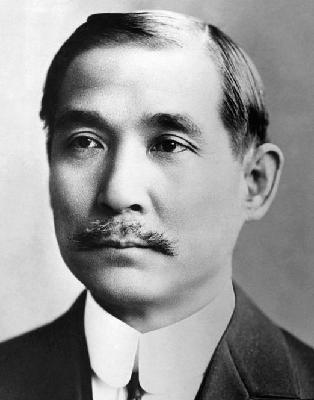 Sun Yat-sen.
Sun Yat-sen was born in 1866 in the south of China (Canton or Guangdong
Province) ... and in 1878 at age 13 moved to Honolulu, Hawaii, to live
with an older brother. He quickly picked up the English language
and Western ways in school there and eventually went on to Oahu College
... although his brother pulled him out after a semester and sent him
back to China to finish his education, fearing that he was about to
become a Christian! But he ended up in British Hong Kong, studied
medicine at the Hong Kong College of Medicine, was licensed as a
Medical Doctor in 1892 ... and at the same time was baptized as a
Christian, eager to see the Chinese world around him "converted" to
things Christian (i.e., "Western"). Sun Yat-sen.
Sun Yat-sen was born in 1866 in the south of China (Canton or Guangdong
Province) ... and in 1878 at age 13 moved to Honolulu, Hawaii, to live
with an older brother. He quickly picked up the English language
and Western ways in school there and eventually went on to Oahu College
... although his brother pulled him out after a semester and sent him
back to China to finish his education, fearing that he was about to
become a Christian! But he ended up in British Hong Kong, studied
medicine at the Hong Kong College of Medicine, was licensed as a
Medical Doctor in 1892 ... and at the same time was baptized as a
Christian, eager to see the Chinese world around him "converted" to
things Christian (i.e., "Western").Frustrated with the state of affairs in China under the Qing, Sun quit his medical practice and devoted himself to working full-time with friends to modernize China ... becoming increasingly "revolutionary" as he watched the Qing government unable to stand up to the Japanese (the First Sino-Japanese War, 1894-1895). He participated in an uprising in 1895 against the Qing government which failed miserably ... and he took refuge in Japan. There he became involved in a society devoted to fighting Western Imperialism ... and became very active in the support (shipment of arms) of the uprising against American imperialism in the Philippines. But his hope of using Philippine independence as a launch-pad for a similar movement in China against the Qing, ended when the Americans in 1902 successfully (more or less) crushed the Philippine uprising. Meanwhile he had been on the move elsewhere around the world, attempting to enlist support for his revolution against the Qing government – which the Qing government got wind of and in 1896 attempted to have him assassinated while in London. His escape from this effort made the London newspapers ... and at that point brought a lot of attention to him as a Chinese patriot. He found himself seemingly in permanent exile when in 1900 he led an attack on provincial authorities in Guangdong and once again failed, forcing him to have to go abroad again, to Japan (where he met up with fellow revolutionary, military-trained Huang Xing), Europe and America. But he (and Huang) used this time to organize a new revolutionary society (the Tongmenghui) in Japan, then Singapore ... and to gather globally funding for his revolutionary activities. It also allowed him time to organize the political philosophy that would direct his actions: nationalism, democracy, and welfare. But his fortunes improved not at all, as other attempts to organize revolts against the Qing government failed (1907 and 1908). This in turn led to a challenge to his authority within the Tongmenghui, forcing him and Huang to move their operations to British-controlled Penang (Malaya). The end of the Qing Dynasty
The Wuchang Uprising of 1911. In early 1911 Huang organized an uprising (Sun was abroad raising financial support) against Qing authority in Guangzhou ... which once again failed – disastrously (with Huang wounded in the attempt). Then in October of that same year at Wuchang a protest over the Qing Government’s seizure (or "nationalization") of Chinese railroads – to finance the indemnity payments China owed the West – got out of hand. However the Qing’s local New Army, instead of moving against the protesters, came over to the side of the rebels, even declaring their support for the creation of a new Chinese Republic (October 11). The next day Hankou and Hanyang also were taken over by rebels. The rebellion now began to spread rapidly, as rebel groups took over one city after another during the second half of October. At this point the desperate Qing government decided to recall to active service Yuan Shikai and his large New Army (the Beiyang Army) ... to crush the rebellion. Yuan was given the position of Prime Minister, set up his own cabinet, and then called for the removal of Zaifeng from the Regency ... supported in this move by Yuan’s political ally, the Dowager Empress Longyu.21 Meanwhile, Huang at the beginning of November had moved to take command of the rebellion ... which was spreading rapidly – as 15 provinces in Southern China moved to declare their independence from the Qing government and call for a new Chinese Republic. The Provisional Government. At the beginning of December, a major battle with the rebels resulted in a clear victory by Yuan Shikai’s Beiyang Army. But Yuan himself was interested in seeing China end dynastic government and move to a Republic. Thus he sat down with the rebels to negotiate some kind of arrangement designed to move China in that direction. In the latter part of December Sun arrived back in China (accompanied by an American military adviser) and was elected at Nanjing by an assembly of representatives of the breakaway provinces ... to be the leader of a new "provisional" Chinese Republic, slated to start up on the first day of 1912. At the same time, Huang was also chosen to serve as the head of the new Republic’s army. Yuan Shikai takes command
But negotiations with Yuan Shikai were still underway. A deal was struck with Yuan, offering him the position of President of the Republic ... provided that he could get Qing Emperor Puyi to abdicate. And in February, with the Dowager Empress Longyu maneuvering the deal, Puyi did abdicate. And thus also Sun stepped down as head of the revolution, to make way for Yuan to take over the presidency. Sun seemed content that his goal – a Chinese Republic – had been met and the Republic was in strong hands with Yuan. Then the new Provisional Government moved its headquarters to Beijing in March. 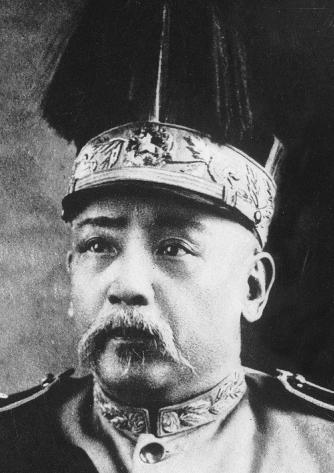 Yuan
was a highly skilled power broker, who made his way to power through
military command. As a youth he was trained as a Confucian
scholar. But failing twice to qualify in the exams necessary for
entry into officialdom, he turned to military service as his path to
power. Here he succeeded immensely. He came to prominence
when he was sent by the Qing to China’s protectorate, Korea, to help
the Korean military modernize. The traditionalist versus
modernist debate was going on within the Korean government, and the
modernizers looked to Yuan for assistance. The Japanese were also
modernizing ... and looked to Korea to extend their imperial influence
as a sign of their rising modern power. Using as an excuse the
turmoil going on in Korea over this debate – and the ‘harm’ this was
causing Japanese interests in Korea – Japan became more assertive ...
thus forcing the Qing into a confrontation over the status of Korea as
a Chinese dependency. Not able on his own to resolve this crisis,
Yuan was recalled to China ... just prior to the outbreak of the First
Sino-Japanese War in 1895 (which spared him being identified with
China’s humiliation resulting from the war). Yuan
was a highly skilled power broker, who made his way to power through
military command. As a youth he was trained as a Confucian
scholar. But failing twice to qualify in the exams necessary for
entry into officialdom, he turned to military service as his path to
power. Here he succeeded immensely. He came to prominence
when he was sent by the Qing to China’s protectorate, Korea, to help
the Korean military modernize. The traditionalist versus
modernist debate was going on within the Korean government, and the
modernizers looked to Yuan for assistance. The Japanese were also
modernizing ... and looked to Korea to extend their imperial influence
as a sign of their rising modern power. Using as an excuse the
turmoil going on in Korea over this debate – and the ‘harm’ this was
causing Japanese interests in Korea – Japan became more assertive ...
thus forcing the Qing into a confrontation over the status of Korea as
a Chinese dependency. Not able on his own to resolve this crisis,
Yuan was recalled to China ... just prior to the outbreak of the First
Sino-Japanese War in 1895 (which spared him being identified with
China’s humiliation resulting from the war).Yuan was assigned the task of developing the Qing’s first New Army (the Shandong New Army) that same year ... and as such trained a great number of loyal junior officers and created the most effective of China’s modern military units ... one positioned to best defend (and influence politically) China’s government in Beijing. In 1898 he was involved in the palace coup on the side of the Dowager Empress Cixi ... and the next year was appointed governor of the all-important Shandong province as part of her trust in him. When the Boxer Rebellion broke out he brutally crushed it in Shandong (massacring tens of thousands in the process) ... and even helped the Westerners break the Boxers in Beijing. After the rebellion he was placed over the large Beiyang region (much of northern coastal China), overseeing regional economic development, foreign trade operations, and the huge Beiyang army. He also became a big supporter of the Dowager Empress in her own reform program, including the development of a new Constitution providing for a Chinese monarchy on the model of Meiji Japan and Bismarck’s new Germany ... all of which was due to go into full effect in 1916. But with the Dowager Empress’s death in 1908, Yung was removed from power ... and went into ‘retirement’ (fortunate in not having been put to death – as was the dying Emperor wish). There he quietly watched events unfold ... waiting for an opportunity to make a comeback. When the Wuchang Uprising broke out in 1911, he was called on by the Qing government to lead the huge Beiyang army to crush the uprising ... but he simply waited – as the Qing government grew more desperate – and then he finally moved. As already noted, he delivered a huge blow to the Republican rebels ... and then sat down to negotiate an agreement with them. And thus it was that he himself became Provisional President of the New Chinese Republic in 1912. Now he began to assemble a national cabinet and demonstrate his strong interest in increasing the powers of the President. Tensions with the Kuomintang (KMT). Elections in February of 1913 for the new National Assembly brought a clear victory for the Nationalist Party (the Kuomintang or KMT) – and opposition to Yuan by KMT organizer Song Jiaoren ... considered the leading candidate for the position of Prime Minister. Song was most vocal about his concern for the presidential powers held by Yuan ... and wanted the presidential powers transferred away from the President to the new Prime Minister. A month later Song was assassinated. And those accused of designing the plot soon suffered the same fate. Yuan himself escaped charges. But tensions between the KMT and Yuan grew stronger, accusations being leveled against Yuan for his handling of the government’s finances (putting the government in debt with a number of foreign banks in order to finance his Beiyang army). When the KMT called for Yuan’s removal as President, he responded with military action against the KMT. But by mid-1913, a number of the southern Chinese provinces were in full rebellion against Yuan’s government. Yuan sent his army after the KMT’s forces and scattered them. Sun and others then escaped to Japan. In October an obliging Chinese Parliament formally elected Yuan as the Republic’s President and Yuan named a loyal Beiyang General, Duan Qirui, as his prime minister. Meanwhile conditions in the south of China worsened as bandit leaders were inspiring revolt, even encouraged by Sun Yat-sen from his seat in Japan – from which he was attempting to organize a "Second Revolution" ... against Yuan’s government. Yuan responded by dismissing all KMT members of parliament ... and then in January of 1914 by simply dissolving the Parliament itself and replacing it with a Council of State made up of members loyal to him. So also he replaced provincial governors with proven supporters. And then put into effect a new constitution, one that gave him almost unlimited powers. And he outlawed the KMT. Nonetheless, opposition to Yuan did not cease, but simply reorganized itself along a number of different lines ... including Sun’s rebuilding in mid-1914 of the recently outlawed KMT (now renamed by Sun the ‘Chinese Revolutionary Party’) more tightly around his personal rule. World War One and more troubles with Japan. When World War One broke out in August of 1914, Japan allied with Britain and France against Germany, and seized German holdings in China’s Shandong Province. Then in 1915 the Japanese sent Beijing a list of Twenty-One Demands, calling for Japanese ‘protection’ over railroad and mining operations in several Chinese provinces and the appointment of Japanese ‘advisors’ to Yuan’s cabinet ... in essence demanding that China become a Japanese protectorate. Yuan felt that he had to accept at least some of these demands, notably Japanese control of the German territories seized by Japan ... plus Japanese control of southern Manchuria and the eastern region of Inner Mongolia. The Chinese were furious that Yuan had capitulated so easily to the Japanese. But Yuan knew that China was in massive disarray and in no position to put up effective resistance to a Japanese military move against China. Nonetheless it weakened Yuan standing among the Chinese people. Yuan needed to do something to rebuild his power. Yuan’s move to become Emperor. Yuan now began to take the position that the Provisional Government had simply been a means of ending Manchu rule in China, that the Chinese were used to being governed by a ruling monarch, and that only such an autocratic government could direct and protect China (against the foreigners who constantly overran China). Soon some voices of support for a monarchy began to grow ... and in November of 1915 a special Assembly was convened – to call Yuan to the throne as a new Chinese Emperor. A month later he accepted the offer. Yuan would rule as the Hongxian Emperor, beginning January 1st, 1916. But the move immediately proved not to be as popular among the Chinese as Yuan had expected. Even his Beiyang army officers became divided over this move. From Japan, Sun Yat-sen began to organize opposition to Yuan. Now Chinese provinces rose up in revolt. Failure ... and death. Yuan postponed the date for his taking the throne ... and finally in March called the whole thing off. Demands then grew for him even to abandon his position as President of the Republic. Meanwhile, the revolt against his rule spread to more provinces. Then in early June Yuan died of kidney failure. The political unity of China had been shattered. Warlords now began to take over what was left of China. Chaos
Adding to the confusion, World War One was having the effect of deeply dividing the on-going Provisional Government in Beijing between those who wanted to stay neutral and those who wanted to join the Allies ... in the hopes of some financial support to rebuild the Chinese treasury. This finally pitted the new President Li Yuanhong (pro-neutral but weak in power) against the on-going Chinese Prime Minister Duan Qirui (pro-Allied and the dominating figure in the government at that point) in a bitter debate that soon spread to the countryside as local authorities took sides in the contest. Then a former Qing military governor, Zhang Xun, called to mediate the dispute, instead made a strong move in the midst of this chaos to restore the Qing dynasty under Puyi. That idea died almost at birth. Anyway, after a military showdown, Li resigned the Presidency and Duan moved to have China enter the war on the side of the Allies (August 1917). Meanwhile a number of different governments were being formed in the south of China in opposition to the Duan-dominated government in Beijing. Importantly among those was a government assembled in 1919 in Canton by Sun ... built on the power of his "Constitutional Protection Army" claiming (though not very convincingly) that it was the legitimate government of China under the Chinese Constitution). Duan failed in an attempt to crush this southern government and resigned. Negotiations thus opened up between the northern and southern governments ... and a temporary peace fell into place. But Sun’s government now split into contending factions ... and finally Sun withdrew from the government and retreated to Shanghai. Meanwhile negotiations between the northern and southern governments continued through 1919, but stalled due to Duan’s meddling. About this time also, Chinese students were becoming increasingly active (the May Fourth Movement started in 1919), in opposition to the treaties negotiated at the end of the war ... but also demanding reforms at all levels of Chinese society and government. Meanwhile, Sun was working hard in Shanghai to rebuild his position, including an effort to gain international recognition of his government. At first he looked to Germany as an ally.22 Then, when it became apparent that Germany was losing the war, in an effort to gain international recognition from the Allies he switched sides ... though the China seat at the peace talks ultimately went to the Beiyang government – disappointing Sun greatly. In October of 1919 he reconstituted the KMT and began work on removing the controlling faction of the southern government that he had once led. With the help of a local governor (warlord) Chen Jiongming, Sun was able to succeed in this venture in November 1920. With a bit more cleaning up of contending warlords, in April of 1921 the southern parliament elected Sun as their president. Sun also found an ally in Lenin’s new Soviet Republic in Russia23 ... a matter of great importance in Sun’s comeback to power. Both Sun and Lenin were desirous of ending Western involvement in their internal revolutions. Soviet advisors, led by Mikhail Borodin, arrived in China in early 1923 to help reorganize and discipline the KMT along Soviet lines ... and form the United Front with the Chinese Communist Party. But Sun and his local ally Chen had split earlier in 1922 over the issue of how to organize a new Republic, centrally under the control of the KMT (Sun) or federally as a union of different provinces (Chen). By June of 1923 the conflict turned violent, a bitter military standoff lasting until August, with Sun eventually retreating again to Shanghai. Sun was finally able to retake Canton in early 1924 (with the help of the Soviet advisors, local Communists and local mercenaries), consolidated considerably his power there, and began to make preparations for moving militarily against the northern or Beiyang government in Beijing. He established that same year the Whampoa Military Academy at Guangzhou (Canton), with his faithful young friend Chiang Kai-shek as its commandant ... to train KMT officers in modern warfare (inspired by both Soviet and Meiji military tactics). The Second Zhili-Fengtian War
While the southern half of China had its own political dynamics to wrestle over, the north of China had its distinct issues tearing at it. Northern China had been caught up in a struggle between the Japanese-backed Fengtian clique based in Manchuria and the Zhili clique based in Beijing, backed by Anglo-American businesses. The struggle turned to all-out war, which resulted in a Zhili defeat at Tianjin (October 1924). Duan was brought back to power in Beijing, but was at this point merely a figurehead ruler for the Fengtian clique. This merely weakened the power of Beijing ... and encouraged the regional warlords all the more to independent action. And this in turn put much of the rest of China in a mood of protest over the general chaos that seemed to reign supreme in China. Seeing political opportunity in this development, Sun now took up a more diplomatic line in order to advance his KMT as China’s best hope. In November of 1924 he traveled first to Tianjin and then to Beijing to discuss with what little governmental authority was left in the north the possibilities of a united China. The reception was favorable. Sun Yat-sen’s death. But by this time he was a very sick man (cancer) ... and the following March (1925), he died, leaving China no further along in its quest for unity. But in death the image of the man proved to be an even stronger unifying force than he had ever been able to experience during his lifetime. He would eventually become acknowledged as the ‘Father’ of modern China. China erupts in an anti-foreigner frenzy (the May 30th Movement)
Meanwhile the KMT – in close union (the First United Front) with the Chinese Communist Party (CCP) and with considerable Soviet encouragement – was moving ever further to the left politically. In an attempt to strengthen their national base, a considerable propaganda campaign had been undertaken by the KMT-CCP government at Canton attacking the exploitation of the cheap Chinese labor by foreign business (capitalist) enterprises. The campaign seemed to be working ... as it spread not only among workers in the Chinese cities but also among the highly sensitive Chinese university student community. As 1925 advanced, the country was hit by a round not only of labor protests, but of general anti-foreigner protests everywhere. Killings on both sides occurred at a Japanese mill in Mid-May ... which only heightened tremendously the mood of hostility on both sides. Students were arrested when they marched through the international quarters protested the killing of the Chinese worker, and their trial date of May 30th, quickly became the date for an even bigger anti-foreigner national protest. Protesters in Shanghai were arrested that morning, drawing at the local police station an even bigger crowd that day (2,000?). And finally shooting broke out as protesters attempted to storm the station (a small staff or mostly foreign Asians and Brits). This in turn led to even more intense anti-foreign action as looting of foreign shops, refusal of Chinese to come to work public or private work, and multiple attacks on foreigners, spread across the country ... shutting down economic operations that could not be continued by Western volunteers ... and growing more violent as it spread (the killings of foreigners growing in numbers). ... And the warlords were taking even greater opportunity from the chaos to enhance their own growing powers locally. With Chinese businesses also hurting from the economic chaos, voices in favor of calm began to prevail ... and little by little the situation began to settle down (toward the end of the year, although elements of it continued all the way into mid-1926). Chiang Kai-Shek finally brings some degree of unity to China
That summer (1925) the young KMT military commander Chiang initiated his campaign to conquer the warlords of the North and bring all of China under KMT authority (the ‘Northern Expedition’). It would take him the next three years to accomplish this monumental feat. 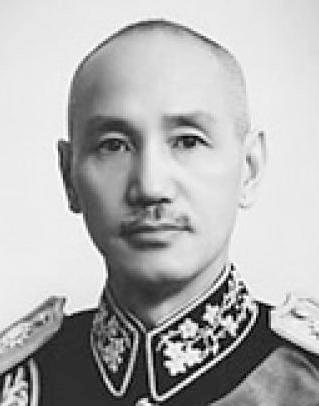 Chiang Kai-Shek24
was born in a small town Eastern China to a prosperous merchant family,
but his father died when he was eight ... leaving him to be raised by a
strongly Confucianist mother. He went to military school in China
... then transferred to a Chinese military school in Japan ... where he
became involved in anti-Qing activities among his fellow Chinese
classmates. He then served in the Imperial Japanese Army from
1909 to 1911. He returned to China in 1911 to participate in the
Wuchang Uprising as a regimental commander in Shanghai, serving under
his mentor Chen Qimei, whom he had met in Japan. When Chiang was
involved in the killing of one of Chen’s rivals in the Revolutionary
Alliance, Chiang’s stock with Chen rose even higher. But at the
same time this relationship with Chen put him closely in the company
with Shanghai’s criminal gang, the Green Gang. Chiang Kai-Shek24
was born in a small town Eastern China to a prosperous merchant family,
but his father died when he was eight ... leaving him to be raised by a
strongly Confucianist mother. He went to military school in China
... then transferred to a Chinese military school in Japan ... where he
became involved in anti-Qing activities among his fellow Chinese
classmates. He then served in the Imperial Japanese Army from
1909 to 1911. He returned to China in 1911 to participate in the
Wuchang Uprising as a regimental commander in Shanghai, serving under
his mentor Chen Qimei, whom he had met in Japan. When Chiang was
involved in the killing of one of Chen’s rivals in the Revolutionary
Alliance, Chiang’s stock with Chen rose even higher. But at the
same time this relationship with Chen put him closely in the company
with Shanghai’s criminal gang, the Green Gang.Chiang was part of the group that founded the KMT in 1911 ... and like the others (including Sun) found himself moving back and forth between China and Japan as the KMT’s fortunes changed over the next few years. Then when in 1916 Chiang’s mentor Chen was assassinated in Shanghai by agents of Yuan Shikai, Chiang took his place as head of the Shanghai branch of the KMT (still known at that time as the Chinese Revolutionary Party). Chiang was at this point working with Sun ... forming a close friendship that would go through many trials. In 1918 Chiang joined Sun when he moved to Canton to build a new revolutionary government. When the crisis exploded in mid-1923 between Sun (the military-based centralist) and local governor Chen (the federalist), it was Chiang who immediately sailed from Shanghai to Canton to organize Sun’s defenses, drawing the two men even more closely together. But eventually both chose to end their effort and head to Shanghai. When Sun regained his position in Canton in 1924, he sent Chiang to Moscow to study the Soviet Union’s political and military organization. Here Chiang discovered that the Soviet model was ill-suited for the Chinese society ... though the Soviet assistance was well appreciated. In fact at this point Chiang began to develop some very clear ideas of exactly how he personally stood in opposition to the Communist program, Chinese as well as Russian. Upon his return to Canton, Chiang was put in charge of Sun’s new Whampoa Military Academy ... and proceeded to develop a group of young officers very loyal to him and his place in the KMT. When Sun died in March of 1925, three individuals moved to try to take over Sun’s Nationalist government, one who was assassinated in August, another who was arrested for the assassination, leaving the third, (Soviet-backed) Wang Jingwei, to move into leadership. In early 1926, Wang moved to place Communists in positions of power in his government and the United Front political union between the KMT and CCP. Meanwhile Chiang was appointed to head up the National Revolutionary Army. The Canton Coup (March 1926). It was a confusing event the following March that pushed Chiang to move against Wang ... and force Communist members of the Nationalist Government to vacate many of the positions Wang had placed them in. The government’s most powerful ship, with a Communist captain and Soviet advisor onboard, moved into Canton harbor the night of the 18th/19th of March to support protests taking place on shore. It was said that this was done under Chiang’s order – though he had issued no such order. Calls had been sent out looking for Chiang, and immediately Chiang suspected a plot against him. Chiang was about to make an escape, when he decided instead to take a stand and fight back. On the 20th He ordered cadets from the Whampoa Military Academy to arrest Communist military and naval officers, he then called on other military units to join him, put Wang under house arrest,25 disarmed the Communist paramilitary Workers’ Guard ... and expelled the Soviet agents – the ones that had not fled already. The Soviet reaction in Moscow was mixed (just as the Soviet leadership was also highly divided at that time), Stalin wanted to continue to work with Chiang (under some terms of compromise) so as not to lose influence in developing events in China, whereas Trotsky and most of the Central Committee were opposed to cooperation with Chiang. Chiang takes charge. But Chiang moved ahead on his own anyway to force the CCP to agree to political terms limiting greatly their positions (no more than one-third of the membership) in the Nationalist Government, local and regional as well as national.26 He also made his position at the head of the army free of civilian oversight – giving him a free hand in his move to address the problem of the northern warlords. And with that he was ready to act. The Northern Expedition ...
and the split with the Communists (1926-1928) Developments in Wuhan. Three groups of Chiang’s National Revolutionary Army headed in different directions in the summer of 1926 to take on China’s warlords. Rather quickly a number of Chinese provinces were brought under the NRA’s control. In January of 1927 Chiang’s western forces captured Wuhan ... and then moved on to Nanchang. The KMT Government (under the strong influence of the Chinese Communists and the Soviet advisor Borodin) then in March moved to put Chiang’s NRA securely under KMT control. But they were also planning to arrest Chiang as the key threat to the leftist takeover of the KMT (which Chiang was alerted to and dodged ... embittering him deeply against the leftists of the KMT). The Nanjing Incident (March 1927). Meanwhile off to the east, hostility between the left and right wings of the Nationalist Movement (Communists and Conservatives) was deepening. When the NRA approached the strategic city of Nanjing, violence broke out, the international quarters were attacked by both NRA soldiers and civilians alike, and the rioting and looting was finally brought under control by Anglo-American naval forces. Chiang suspected that the Communists had incited the riots in order to secure Communist control of the city and weaken the position of the conservative (non-Communist) members of the KMT. Chiang’s anti-Communist bitterness deepened all the more. 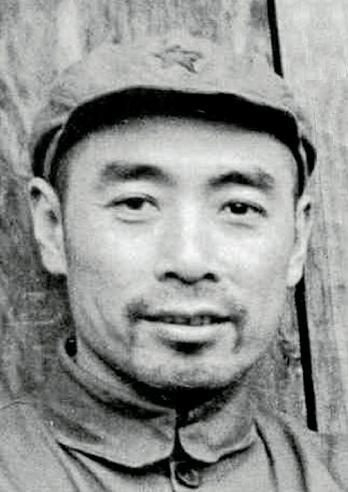 The Shanghai Massacre (April 1927). At the same time, Zhou Enlai
had been organizing industrial union workers in Shanghai for a similar
uprising, also to bring the city under Communist control prior to the
arrival of Chiang’s NRA. But the NRA’s eastern commander Bai Chongxi
was able to take control of the city by the end of March, despite the
waves of protests organized by the Communists. The Shanghai Massacre (April 1927). At the same time, Zhou Enlai
had been organizing industrial union workers in Shanghai for a similar
uprising, also to bring the city under Communist control prior to the
arrival of Chiang’s NRA. But the NRA’s eastern commander Bai Chongxi
was able to take control of the city by the end of March, despite the
waves of protests organized by the Communists. In early April Wang Jingwei had returned from his "vacation" and arrived in Shanghai to try to repair relations with the Communists ... before heading on to Wuhan (which he supported as the new Nationalist capital). But Chiang, still in Shanghai decided that it was time for a showdown with the Communists ... and organized (in cooperation with the Green Gang) a countering union organization ... to contest the Communists. Then Chiang issued an order for the purging of all Communists from the KMT. In mid-April Chiang ordered his workers to attack the Communists ... an attack in which a hundred were directly killed, thousands arrested or missing and some 300 eventually executed. The KMT Central Committee in Wuhan denounced Chiang as betraying the honor of Dr. Sun ... and Chiang immediately (mid-April) countered by setting up his own Nationalist Government in Nanjing. But then Wang discovered that Stalin had issued an order via Borodin to take over the Wuhan Government and purge all the non-Communists (including Wang) from the KMT. Now Wang and Chiang were on the same page ... and moved swiftly to have more than 10,000 Communists arrested and executed across China over the next few weeks. But Wang lost his nerve and fearing a Communist counter-action, fled to Europe ... leaving the initiative entirely to Chiang. The beginning of the Nationalist-Communist Civil War. With Chiang now in complete charge of the Nationalist Government and the KMT, the purge of the Communists continued over the next year. Communist uprisings were organized in opposition to Chiang’s Nationalist Government, Communist troops participating alongside Communist workers ... and were met with Chiang’s KMT forces in ever greater strength ... with over 300 thousand Chinese dying in the violence that shook China over the next year.  One of those uprisings (September 1927) was led by Mao Zedong, who built his following
not from the urban working class (the usual support group of the
Communists) but from peasants in Hunan and Jiangxi provinces in
south-central China. One of those uprisings (September 1927) was led by Mao Zedong, who built his following
not from the urban working class (the usual support group of the
Communists) but from peasants in Hunan and Jiangxi provinces in
south-central China. Mao was born to a prosperous farming family in Hunan province, schooled formally as a youth, was an avid reader of novels and biographies of great leaders, and developed a strong interest in political affairs early on. He wanted to become a teacher (the life of the Confucian-scholar did not interest him at all) and went off to a teacher’s college, where he became an active campus organizer ... and found himself interested in developing knowledge of the military. After graduation, he secured a position in the winter of 1919 at in the library of the Peking University (Beijing) ... where he took up the study of classic Marxism. But he was soon off to a teaching position in the Hunan capital city of Changsha in the spring of 1919. Here he joined the strongly-nationalist May Fourth student protest movement ... in Mao’s case directed against the corrupt governor of the Hunan Province, Zhang Jingyao. Mao not only helped to organize protests against Zhang but published a new political magazine and wrote articles for others, taking a radical stance in favor of ‘communalism’ – not exactly ‘Marxist’ ... but rather utopian in advocating a life of simple mutual support at the local level. Mao moved on to Shanghai, working as a common laborer, and there was introduced to KMT General Tan Yankai. He joined Tan in returning to Changsha, organizing Changsha students and helping Tan force Zhang from power. For his services, he was appointed headmaster of the junior section of the local teacher’s college ... where his income allowed him to marry his second wife in the winter of 1920.27 When a Communist Party was formed in Shanghai in 1921 Mao responded by setting up a branch in Changsha ... and attended (along with 12 others) the first ‘National Congress’ of the CCP in Shanghai and came away as the CCP’s party secretary for the Hunan province. As such, he understood his job not only to grow the local organization, but to instruct it in correct ‘Marxist’ thinking. Mao was showing great talents as a propagandist ... in both the writings he published and the speeches he delivered. The Russian Communist or Soviet advisors sent by Lenin to work with the small CCP urged it to work closely with the KMT ... at least temporarily. Mao followed up on this idea in working broadly across political lines to organize the local working classes to work cooperatively to promote a new Chinese national spirit (aimed particularly against the Japanese, the Americans and the British). In 1924 he was even elected as an alternate member of the KMT Executive Committee. But Mao’s heart was with China’s peasants ... and in late 1924 he left Shanghai to return to Hunan to take up the cause of the frustrated peasants, who had already taken action against the local landlords and were setting up communes of their own. From there he took up the position at the head of the KMT’s Peasant Movement ... something the CCP regulars were doctrinally very uncomfortable with – though leftist KMT members strongly supported the program. Also when Chiang took over the running of the KMT upon Dr. Sun’s death in 1925, Mao moved in support of Chiang ... and his National Revolutionary Army. But with the peasants taking action on their own behalf as Chiang took up the Northern Expedition, tension would come into the heart of that relationship. Many supporters of the KMT were prosperous landowners ... deeply angered by the peasants’ seizure of the farmlands. Chiang’s support came heavily from this landowning group ... whereas Mao’s heart was always with the peasants. At the Third Plenum meeting of the KMT Executive Committee in Wuhan in March of 1927, Mao spoke strongly in support of Wang Jingwei and against Chiang in the power struggle growing between the two KMT leaders. Mao was very clear in his sentiment that the Revolution must lead to the empowerment of the Chinese peasant farmer. But (as we have seen above) Chiang was not in a mood to debate the issue ... but had made up his mind to move strongly against the Communist element in the KMT ... nearly wiping out the membership of the CCP in the process. Mao survived Chiang’s purge, (though only about 10,000 of the original 25,000 members of the CCP remained) but for survival’s sake was forced to retreat with only about a thousand followers to the Jinggang Mountains, where the peasant militia he had been developing was joined by local miners to continue to fight guerrilla-style for the Communist cause. In the meantime, Mao had been removed from his position on the CCP’s Central Committee by the leaders in Shanghai – and he even lost his position as head of the Hunan branch of the party. But Mao seemed unmoved by the Shanghai group. He had plans of his own to continue the struggle that had become the very heart of who he was. Mao’s little army at this point was a very different group from what was typical of the CCP, with its scholars and urban intellectuals deeply invested in Marxist theory and its focus on mobilizing the industrial working class of the cities. But it would be Mao’s group of peasant fighters, not the traditional urban Marxists, that would survive ... and eventually become the core group of a greatly transformed CCP. But for the time being it looked as if the CCP for all practical purposes had been knocked out as a significant power group in the struggle for control of the Chinese Republic. Chiang finally comes to full power in China. In any case, Chiang would probably have not even noticed Mao’s surviving group, appearing to be at the time an matter of relative unimportance. Bigger things were going on elsewhere. In June of 1928 two warlords (allied with Chiang) took Beijing and that December a Manchurian warlord declared allegiance to Chiang ... bringing the Northern Expedition to a close. Chiang had finally come to the position of being China’s new ruler. China was now seemingly unified ... and the ‘Warlord Era’ had finally been brought to a close. Chiang seeks to establish his legitimacy as China’s ruler. Yet it was still extremely important to Chiang to be able to demonstrate the ‘legitimacy’ of his military-based rule over China (as it had always been for China’s rulers) ... and Chiang worked to get both 1) a general recognition of Dr. Sun Yat-sen as ‘Father’ of the Chinese Republic (having a huge mausoleum built in Nanjing to house the body of Dr. Sun) ... and then 2) a similar recognition of himself as the legitimate heir to Dr. Sun – making much of the fact that he and Dr. Sun had married sisters. But still, such legitimacy would not be easily achieved in the hearts and minds of the Chinese ... or easily maintained. Chiang’s Nationalist Republic takes shape
Control and reform. Something like Japan’s Meiji social revolution was undertaken by Chiang in China ... although he would never enjoy the uncontested power that the Japanese Emperor did – and would be challenged every step along the way. He worked hard to bring under governmental control and reform the national legal system, the national currency and banking system, the national education system, the nation’s material infrastructure, and even much of its industrial system. While he came down harshly on the Communist workers’ movements in China, he could be just as tough in his handling of China’s industrial capitalists ... because he was not supportive of a free and open industrial market – but government control of the economy instead. Meanwhile, the countryside in China’s interior – the vast portion of China to the west of China’s rich coastal industrial zone – remained largely under the control of warlords ... or the Communists. Taking on the warlords, as Chiang would do from time to time, proved very costly to the national treasury, the Central Plains War of 1930 costing a quarter of a million casualties for both sides of the struggle ... and nearly bankrupting Chiang’s government. Then a split opened in the government ranks in 1931 between Chiang and Hu Hanmin, formerly a major supporter, who protested against Chiang’s political overreach. Hu retreated to Canton to set up an alternative republic there, a war between the two developed ... and Chiang prevailed only with the support of a local military commander (warlord) Zhang Xueliang. Mounting problems with the Japanese in Manchuria
Japan’s own internal conflict. Following World War One most of Japan’s leaders were of the opinion that Japan’s future was best assured by adopting the democratic and capitalis' ways of the West. After all, the "victory" of the "democratic" societies (such as Britain, France and America) had clearly demonstrated the superiority of the democracies over the "autocracies" of Austria and Germany, the latter which had been something of a model for Japanese modernization since the period of the Meiji Restoration in the second half of the 1800s. To such democratic "Liberals," it was time to drop the heroizing of the Prussian German military ethic and look to the process of further democratization of Japan along more Anglo-American lines. But by no means were all Japanese in agreement on this matter. Standing strongly opposed to the ‘democratic’ liberals were the very conservative militarists embracing the traditional warrior ethic of bushido. Having lost their traditional status in the Meiji Restoration, the huge samurai or warrior caste and their descendants resented deeply the intrusion of Western ways – and found various ways to support hyper-nationalist causes in Japan and abroad. They naturally made their way into the new Japanese army where they became voices supporting the same militaristic ideals (bushido) – which during the 1920s had many traits in common with the rising Fascist spirit within Europe. Central to their political philosophy was State Shinto, with emperor-worship at the heart of this philosophy/religion. Also a strong element shaping the dispute was the obvious racism of the West in regards to things Japanese, a Western attitude which made life much more difficult for the pro-West group – and played into the hands of the hyper-nationalist bushido militarists. Although Japan was recognized by the new League of Nations as one of the world’s handful of major powers, efforts by the Japanese representatives in 1920 to get the League to include a declaration of racial equality into the League Charter failed to get the League’s support, humiliating the Japanese. Then the passage of the Exclusion Act of 1924 by the American Congress, prohibiting further Japanese immigration into the United States, only deepened the wound. And the treaty of the London Naval Conference of 1930 – which allowed Japan slightly smaller numbers of warships than Britain and America were allowed) – seemed particularly condescending to the Japanese ... and served to strengthen the view of the Japanese militarists who wanted to pull away from friendly involvement with the Western democracies. Then when the Great Depression hit at the beginning of the 1930s both the image of Western economic superiority and the status of pro-West politicians weakened considerably. The militarists' claims of "corruption" and "incompetency" widespread within the ranks of the pro-West group, and their boast that the militarist ways were cleaner, more disciplined, and thus more effective than Western ways, began to seem highly plausible to an increasingly nationalistic Japanese population. Growing impatient with their liberal government, elements of the Japanese military were ready to move on the basis of their own political agenda – a direct challenge to the authority of that government. Indeed, in late 1930 there occurred an attempted assassination of the Japanese Prime Minister by a hyper-nationalist for having agreed to the London naval limitations. Then events in nearby Manchuria would give them the opportunity to challenge that authority from yet another angle. The Mukden Incident (1931). Since the Japanese success against the Russians in the war they fought in 1904-1905, the Treaty of Portsmouth had given the Japanese the operating rights over the South Manchuria section of the China Far East Railway. The railway security guards were in fact regular members of the Japanese military ... who often passed the time in raiding the local Chinese community. In 1931 the Japanese militarists devised a plan to provoke an incident involving the Manchurian Railway, one that would allow the Japanese military to take even greater control of the valuable South Manchurian industrial zone. In September of 1931 the Japanese set off an explosion on some railroad tracks (actually a rather feeble explosion), in the hopes of luring nearby Chinese soldiers to the scene ... and then blaming them for the explosion. This did not happen, so the Japanese simply fired on the Chinese garrison, killing about 500 Chinese (the Japanese lost only two soldiers). The local commander Zhang Xueliang was under strict orders not to resist the Japanese, because Chiang at the time was focused entirely on ridding China of the Communists, and wanted no trouble whatsoever with the Japanese. The creation of Manchukuo. The outraged Chinese took the incident to the League of Nations ... and the League responded in October by calling for the Japanese to withdraw from the area. But the Japanese responded not only by ignoring the League’s decision, but once in full control of Manchuria, the Japanese the following January converted the province into a puppet state of ‘Manchukuo’ and installed Puyi, the last Emperor of the Manchu Qing Dynasty, as chief executive in 1932. When in 1933 the League officially refused to recognize the state of Manchukuo and demanded the withdrawal of Japan from the conquered territory, Japan simply resigned from the League. Subsequently nothing more than moral condemnation was forthcoming from the League – and the Japanese held onto their conquered Chinese territory. In 1934 Puyi was renamed "Emperor" of Japanese-controlled Manchukuo. The "Long March" of Mao’s Communists
Mao and the Jiangxi Soviet. Meanwhile Mao moved on his own to establish (1930) a Chinese Soviet Republic in the Jiangxi and Fujian Provinces and organized a Red Army composed of three major divisions operating in the region. But the leadership in Shanghai was suspicious of Mao’s plans (Mao just simply refused to disband his peasant army and fall under ‘orthodox’ Marxism which required the revolution to be led by urban workers ... not rural peasants). Even within the Jiangxi Soviet Mao found himself challenged for failing to follow orthodox Marxist lines of thought and action. Then an effort to remove Mao backfired ... setting Mao off on his own program to purge the Jiangxi Soviet of KMT ‘spies’ ... and other individuals less than fully committed to the "revolution" – as Mao understood the revolution should unfold. Over the next year thousands of individuals were "eliminated" (killed) ... not only reducing the size of the Party membership in Jiangxi, but also cutting back the Red Army to a quarter of its original size. But towards the end of the year the Central Committee leaders were forced to abandon Shanghai ... and made their way to Mao’s Jiangxi base ... identifying the grouping there as the foundation for the Soviet Republic of China. They were so generous to name Mao as the Chairman of the Council of People’s Commissars ... though in fact his army command was turned over to Zhou Enlai and his political position in reality quite reduced from what it was previously. But Mao nonetheless busied himself with his social programs of ‘land reform’ (peasants taking land ownership away from the hands of the landlords) and education training for rank and file CCP members. Chiang’s attack on the Jiangxi Soviet. At the same time Chiang noted the move of the detested Communists to Jiangxi ... and sent troops (1930-1931) to encircle and crush this Communist outpost. But in fact the Communists under Zhou Enlai’s directives were able to fend off Chiang’s attacks, again and again. Finally in October of 1933 Chiang undertook his boldest attempt to encircle and crush the hated Communists, building easily defended blockhouses from which to operate, encircling the Communists with a wall of barbed wire, and in the early months of 1934 moved forward in his effort to eliminate completely the starving Communists trapped inside the encirclement. Nonetheless, Zhou’s troops were able to completely surprise an element of Chiang’s army led by a local warlord and attack the encirclement, aiming to break out and link up with other Communist armies to the north (who were also retreating West deeper into the Chinese interior). In this the Jiangxi Communists finally succeeded (the beginning of December) ... although the venture nonetheless proved to be very costly, with them suffering the loss of half of their number in the breakout. Even then the surviving troops were uncertain as to which direction to head as the region was still a dangerous one for them. Now the situation grew even more serious as they began to lose huge numbers of troops (sickness, fatigue and desertion) ... and a power struggle occurred among the leaders themselves. Zhou survived politically ... although in fact it was Mao who took the lead of this group of wearied peasant soldiers as it moved in a southwestern direction away from Chiang’s pursuing army. According to Mao’s official account of the flight, it was a brutal but heroic journey. For instance, in attempting the cross the Xiang River in November 1934 the Communists supposedly lost over 40 thousand men.28 Then Mao led the army (now down to 25 thousand troops) north across the Yangtze River the following May (1935) into territory commanded by Kuomintang loyalists, enemy warlords, and ethnic groups hostile to ethnic Chinese. Soon afterwards, (in the early summer of that year) Mao was able to link up with a much larger group of the Red Army, although the leaders of both groups fell into disagreement as to joint leadership and the general direction of march. They thus split up ... with the other group ultimately being chased down by Chiang and destroyed. Meanwhile Mao and his small group continued to head north towards Shaanxi (a far-west province). Finally reaching his destination, Mao was able to link up with other Red Army units that had also conducted their own respective ‘long marches.’ At this point only about 7,000 of Mao’s original 100,000 troops had survived the Long March (although they had picked up an additional thousand peasant troops along the way) ... most of his troops having died of hunger, cold and disease (and desertion) ... plus the natural tragedies involved in crossing and recrossing rivers and climbing over very rugged mountains to escape Chiang and reach their destination well into the Chinese interior. Now it was time, at his new base in Yan'an, for Mao to began the process of rebuilding his small Communist army according to military principles of his own design ... and to begin his Communist dream of deep rural reforms aimed at improving living standards and the efficiency of the Chinese farming community ... the sector of society that he cared for most. He would also take this time to write texts explaining his theory of revolution, military tactics, and the design of a truly socialist society. The propaganda value of the Long March. The story of the Long March (as carefully cultivated by the expert propagandist Mao) would enhance considerably the reputation of Mao's small army – and began to attract peasant recruits to his cause in the coming years. It also created at the heart of Mao's army a core of very proven supporters (much like Washington's army after the Valley Forge ordeal), not only among the peasant soldiers but among the future leaders of the Chinese Communist Party. It would also later become idealized as the kind of struggle required of all Chinese in the battle to bring China’s Communist Revolution to greatness. And thanks to Western authors such as Edgar Snow (Red Star over China) to whom Mao was pleased to narrate his heroic story, great sympathy and support for the hitherto unknown Mao would develop in the larger world. Meanwhile ... Chiang has problems on multiple fronts. While Chiang was battling the Communists in the southwest of China, he was facing considerable opposition from numerous warlords around the country, plus rebellions within the Kuomintang – such as with the Fujian Rebellion (1933-1934) – plus a rebellion of the Tibetans (1930-1932), and the Kumul Rebellion of the Uyghurs in the far western province of Xinjiang (1931-1934) ... plus the Soviet Russians who themselves had invaded Xinjiang in early 1934. But his biggest problem would come from the Japanese. Growing war clouds in Japan
Japanese militarism gathering momentum in Japan. In 1932, the Japanese Prime Minister Inukai Tsuyoshi was assassinated in a failed military coup undertaken by young, radical elements of the Japanese Navy – intending a "Showa Restoration" designed to give the Showa Emperor (Hirohito) full power in replacement of the Japanese Diet (parliament) and democracy. Inukai's rule would be the last of the civilian line of prime ministers; subsequently Japan would be led by key military figures (not all of them radical militarists, however). Inukai’s place was taken by Japanese Admiral Makoto Saito a long-time Governor General of Japanese-controlled Korea. He was a military "moderate" and chosen as a compromise figure within the Japanese military in the struggle between the democratic reformers and the arch-conservative Kodoha faction. He served until a bribery scandal in 1934 brought down his cabinet; he served in the next cabinet of Okada Keisuke – until assassinated in the February 26 incident of 1936. The February 26th (1936) Incident. Although Okada was also a Japanese Admiral he was also a supporter of the idea of the democratization of Japan and did what he could to hold the Japanese militarists in check. He helped negotiate the treaty of the 1930 London Naval Conference and pushed for its ratification. He was serving as Prime Minister when the February 26th (1936) Incident took place. The Incident had actually been preceded by other attempts at forcing from power less militant members of the Imperial Cabinet ... all of which had failed. But efforts by the authorities to suppress such behavior seemed only to make some of the junior officers all the more radical. And thus they tried again on February 26th. They did succeed in assassinating some Japanese officials (including two former prime ministers) but failed to kill Prime Minister Okada. Tokyo was shaken as rebels took control of various strategic spots in the city. And the Emperor came out with a statement concerning the crisis ... although it was hard to tell from his wording whether he opposed or supported the rebellion. At first it seemed as if the coup had succeeded. But gradually the voices in the military opposed to the rebellion (for various reasons) gained the upper hand. Also the all-important Imperial Navy had not really supported the action. Over the next few days negotiations went back and forth ... as the rebellion lost strength. On the 29th, under orders of the Emperor, the rebels surrendered (many committed the ‘honorable’ path of suicide instead) and the event was over ... except for the trials that followed (19 of the plotters were tried and executed and 40 others given prison sentences). Although the rebellion had failed, Okada’s cabinet was deeply shaken by the event ... and resigned in early March. The government subsequently came down even harder on the military ... purging the Kodoha officers from the service in order to bring the military under greater discipline. Yet from this point on the military would not only ‘protect’ all civilian government, it would largely control Japanese politics. Chiang and the Xi'an Incident
Meanwhile Japan's aggressiveness and expanding control over the north of China was growing rapidly. But Chiang seemed more interested in fighting the internal civil war with fellow Chinese (warlords and Communists) than in confronting the Japanese. 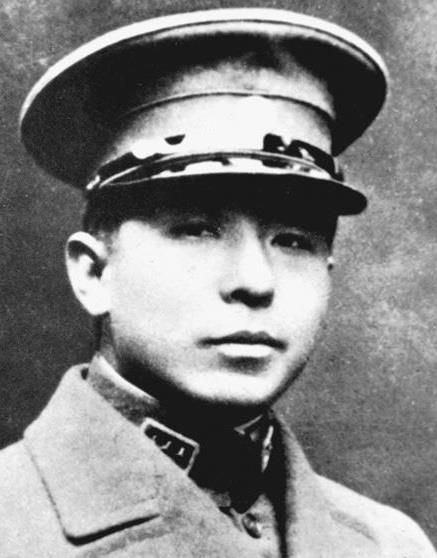 Finally
On December 12, 1936 two of Chiang's own generals seized him and held
him captive in the city of Xi'an for two weeks – in order to force from
him an agreement to a truce with Mao's Communists so that he could
focus his efforts on the mounting problem with Japanese military
aggression in northern China. Leading the effort was the "Young
Marshal" Zhang Xueliang,
essentially northeast China’s ruler (warlord) – actually a loyal
general in Chiang’s Kuomintang, but also unflinching in his opposition
to the Japanese presence in ‘Manchukuo’ (Manchuria was originally
Zhang’s home base). He wanted desperately for Chiang to focus his
actions on the Japanese problem developing in China’s north, especially
after Chiang weakened China’s position there by removing soldiers from
the region to go after the Communists ... leaving the north as a
tempting target for further Japanese aggression against China. Finally
On December 12, 1936 two of Chiang's own generals seized him and held
him captive in the city of Xi'an for two weeks – in order to force from
him an agreement to a truce with Mao's Communists so that he could
focus his efforts on the mounting problem with Japanese military
aggression in northern China. Leading the effort was the "Young
Marshal" Zhang Xueliang,
essentially northeast China’s ruler (warlord) – actually a loyal
general in Chiang’s Kuomintang, but also unflinching in his opposition
to the Japanese presence in ‘Manchukuo’ (Manchuria was originally
Zhang’s home base). He wanted desperately for Chiang to focus his
actions on the Japanese problem developing in China’s north, especially
after Chiang weakened China’s position there by removing soldiers from
the region to go after the Communists ... leaving the north as a
tempting target for further Japanese aggression against China.China was shocked by Chiang’s capture ... but it did catch the attention of the Communists, especially when Zhang sent a delegation to them in Shaanxi to talk about cooperation between the Communists and the Kuomintang. Opinions were deeply divided among the Communists about how to respond to this overture ... as was the case also for the KMT. Mao wanted Zhang to execute Chiang. But Zhou was opposed, fearing this would only help the Japanese. KMT officers also wanted to march on Xi’an to liberate Chiang. But others felt that Zhang was right; China needed to get its act together in the face of a growing Japanese threat. What seemed to shape the outcome was Chiang’s wife, who called for negotiations between the KMT and the CCP ... and Soviet leader Stalin, who supported the idea of the Communists negotiating with Chiang – forcing Mao to have to back down from his call for Chiang’s execution. Thus towards the end of December all parties (including Madame Chiang, but not Chiang himself) meet and agreed on a program of cooperation. But the deal also included the arrest of Zhang who was imprisoned for ten years and then put under house arrest ... even when the KMT fled to Taiwan (Zhang would remain under house arrest until his death in 1990). But Zhang’s actions had clearly brought some political sense to Chiang. But it also spared the Communists, who at this point were on the edge of extinction. Now Chiang’s pressure would be lifted from them ... and they could continue to develop freely their organization. The agreement held for the duration of World War Two ... but besides saving the Communists from near extinction in 1936 – the whole episode from then on would cast Chiang in a dishonorable light in the eyes of much of the Chinese nation. War breaks out between the Chinese and Japanese
(the "Second Sino-Japanese War" – 1937-1945) The "Marco Polo Bridge Incident" (July 1937). Under the ruling of the Boxer settlement of 1901, the Japanese – along with the Europeans – were permitted to keep a number of troops along the railroad connecting Beijing with the nearby port city of Tianjin ... to protect the commercial interests of the foreigners. But by 1937 the number of Japanese troops brought to the area numbered in the thousands – way beyond any need for "protecting" local interests. Tensions were building in the area as the Japanese presence grew to menacing proportions. Then on July 7, 1937 the long-expected conflict between China and Japan occurred when Chinese soldiers refused to allow Japanese troops to cross the Marco Polo or Luguo Bridge (just to the south of Beijing) to come into the town of Wanping in search of a missing soldier. Shooting soon broke out between the Japanese and Chinese at the bridge ... a shooting which began to escalate on both sides. The Tongzhou Incident (July 1937). Now the Japanese militarists had the adventure they were hoping for. But the frustrated Chinese themselves responded at the end of the month when a Chinese military unit turning murderously on Japanese living in the area (civilians as well as troops) ... after having been bombarded by the Japanese following a standoff at nearby Tongzhou. Tongzhou was destroyed by Chinese troops and hundreds of Japanese living in the town were killed. Back in Japan, the Japanese were outraged when they got word of the event ... yet the Japanese government did not respond in kind, hoping to keep a lid on things (including their own troops). In China the Japanese troops simply moved on their own against both Beijing and Tientsin, capturing both cities at the end of July ... and establishing a puppet Provisional Government of the Republic of China. The Japanese were on a roll. The Battle of Shanghai (August-November 1937). But Chiang now responded to this Japanese insult by moving to place all KMT military units under his command ... and in mid-August attacked the Japanese portion of the Shanghai International Settlement (some 30,000 Japanese living there), bombing the area and killing several thousand Japanese living there. Now the Japanese did respond, sending planes from their naval carriers to attack Chiang’s army ... only to find themselves facing a strong air defense from Chiang’s Air Force. But the Japanese brought in more advanced planes than the Chinese biplanes and little by little the Japanese were able to win the air war over Shanghai. At the same time this was accompanied by the landing of large numbers of Japanese ground troops ... soon reaching over 200,000 in number, about three times the size of Chiang’s forces. Although Chiang’s troops were able to put up an unexpectedly strong defense of the city, gradually the battle for Shanghai turned in favor of the Japanese. And by early November Chiang’s troops began their retreat from the city. The Battle of Shanghai had involved considerable bombing of the civilian population ...quite apart from any need for support of Japan’s ground troops. It was done perhaps to terrorize the Chinese population and break their will to defend themselves. In any case, it would become a major feature of the Japanese conduct of war from then on, leading to the extensive bombing of purely civilian districts in Nanjing, Wuhan and Chongqing. The League of Nations protested these bombings ... but to no avail. In the end Japan would pay dearly for the precedent they set when Americans were finally able to reach far enough across the Pacific in the face of a retreating Japanese enemy to bomb relentlessly Japanese cities (especially Tokyo) ... ultimately even unleashing nuclear bombs on the Japanese cities of Hiroshima and Nagasaki in 1945. The "Rape of Nanking" (December 1937-January 1938). A frustrated Japanese army (they had not expected the level of resistance the Chinese were able to offer at Shanghai) moved on to nearby Nanking (Nanjing) – the KMT capital city. But in the face of the advancing Japanese military, Chiang had withdrawn most of his troops from the city (although he refused to allow the civilians to leave the city), supposedly as part of a strategy of drawing the enemy into the countryside where Chiang could then conduct a guerrilla-style war designed simply to wear down the Japanese occupier. But this left the city largely undefended. After quickly overrunning Nanking (Nanjing) in early December, over the course of the next six weeks the Japanese vented their wrath on the Chinese by raping its women and slaughtering its general population.29 Surrendered Chinese soldiers were the objects of bayonet practice and beheadings, and piles of Chinese bodies littered the streets and riverbanks as testimony to the massacre ... and the world took notice. The Turning Point - the Battle of Tai'erzhuang - 1938. By this time (early 1938) the Tokyo Government seemed to have lost control over its military in China, the occupying Japanese Army there tending to simply run on its own. Tokyo was concerned about a possible conflict developing with the Russians and wanted its army in China to slow down. But there seemed to be no stopping the proud Japanese generals who were certain that they would soon be able to destroy Chiang’s army and government. Thus the Japanese headed north from Shanghai and Nanjing planning to cripple the KMT troops in the area and seize the Nanjing to Tientsin Railroad ... and then head west toward Wuhan where they would finish off the KMT government. But advanced Japanese units were caught by surprise as they headed north along this railroad, coming into stiff Chinese resistance at the city of Tai'erzhuang (March). Troops were soon brought in on both sides and the battle turned very serious ... ultimately forcing the Japanese, after considerable losses, to retreat in order to avoid encirclement (April). The Japanese were in shock ... in Tokyo as well as in China, causing a crisis within the Japanese cabinet, and breaking the myth of Japanese invincibility. Although Tokyo attempted to deny that the event had even taken place, the world press was very much aware of the turn of events at Tai'erzhuang ... not to mention the Chinese, whose morale now lifted greatly at the news. The Battle of Wuhan (June-October 1938). The Japanese regrouped nonetheless and decided to aim all their armies at Wuhan, determined to crush Chiang’s KMT government located there. Thus the Japanese poured in from the north, the east and the southeast. But Wuhan was defended at that point by a million-man Chinese army. At one point in July, the KMT, in order to block Japanese reinforcements coming in from the north, Chiang ordered the opening of the dikes on the Yellow River – which flooded three major provinces south of the Yellow River, destroying thousands of Chinese villages in the process, drowning as many as 500,000 to possibly a million people (no one was keeping records of such events) and forcing millions of others to have to flee the region. Ultimately, for all the damage it caused (which would leave this huge area ruined for many years to come) it merely forced the Japanese to find an alternate route to Wuhan ... and it left many Chinese greatly hostile to Chiang’s government (and thus highly pro-Communist) – something that would later haunt him politically in a very big way. Meanwhile to the south, the Japanese took town by town along the Yangtze River in their advance toward Wuhan, however losing a huge number of soldiers of their own along the way. Nonetheless, near the end of October, Chiang – seeing an inevitable loss to the Japanese – pulled out of Wuhan and retreated to Chongqing. However, the Japanese had failed in their mission to bring down Chiang’s government ... and had lost considerable fighting power in the process. The bombing of Chungking (Chongqing). Once again, the Japanese preceded their advance on their target city with extensive bombing, mostly at that point purely civilian targets. But repeated air attacks did not dislodge the KMT government, nor open the way for a ground attack by the Japanese. Although Chongqing would also continue to suffer on-going air attacks from the Japanese, the city would remain in KMT hands during the war as the Chinese Republic’s capital. The war drags on. The Japanese would gain a bit more ground against the KMT ... but also suffer some major defeats in battle as well. The Chinese army now simply devoted itself to outlasting the Japanese occupiers, hitting here and there guerrilla style to drain Japanese energies. By and large the Japanese found themselves in occupation of the major coastal cities and rail lines connecting them. But they were unable to make any further advance into the vast Chinese countryside. Over time it became increasingly apparent that Japan was never going to be able to "wrap up" the deal in China – and an ongoing war with the Chinese would merely continue to drain Japanese energy in the meantime. The deepening split between Chiang’s Nationalists and Mao’s Communists. The United Front forced on Chiang at Xi'an was not holding. This armistice actually benefitted the Communists greatly, for they were on the verge of extinction ... and the letup of pressure from Chiang gave them a chance to rebuild their ranks. They then joined Chiang’s KMT forces in the defense of Wuhan. But after the loss of Wuhan, Mao became much more interested in positioning his Communists so as to be able to take over from Chiang’s Nationalists where possible ... even by 1940 attacking KMT military units – as well as hunting down collaborators with the Japanese (meaning, any Chinese caught not supporting Mao’s cause). Very carefully Mao laid out plans for the eventual takeover of China ... with his reorganization of the Communist army, with the proclaiming of his special social-political programs – and just in general with the spread of "Maoist Thought." The Hundred Regiments Offensive (August-December 1940). By mid-1940 the size of the Communist army had reached around 400,000 troops. The decision was made (the question of who it was that made the decision would later become a matter of great controversy within the upper ranks of the Communist Party) to selectively attack Japanese positions in the Hebei and Shandong regions... in order to put visibly the Communist troops more actively in the war with Japan. Rail lines and bridges needed by the Japanese were blown up by the Communist troops ... and even a valuable coal mine was shut down. But the Japanese were eventually able to retake these positions and force the Communists back into the hills. Much controversy would erupt between Mao and the commanding officer of the Communist troops involved, General Peng Dehuai. Mao preferred a more defensive posture taken with the Japanese (a key Mao supporter Lin Biao was reported even to say that Mao wanted the Japanese to take over much of China because this would weaken considerably Chiang’s political position in China). To Mao’s way of thinking, such a dangerous venture as Peng undertook promised only to put his Communist army in a bad light before the Chinese nation ... something he wanted to see Chiang to fall into ... and certainly not his own troops. Later the ‘failure’ of this campaign would become a charge leveled against Peng during the Maoist purges of the upper ranks of the CCP in the chaotic 1960s. America is dragged into the war (December 1941). America had been alarmed at Japanese behavior for some time and had been backing supplies sent to help China defend itself. Likewise, the Americans in 1940 terminated the sale of some items considered vital to Japan’s military (Japan was resource poor and needed to import a great many of its vital needs). Then events in Europe would complicate matters in Asia greatly. Hitler’s Germany and Stalin’s Russia had been partners in the carving up of Poland in September of 1939, which pushed Europe into a new round of "world war." The following June of 1940 France fell to Hitler’s armies and a new French Government in the south of France at Vichy was allowed to continue under German "protection." Japan responded to these European developments by entering into a military alliance with Hitler’s Germany and Mussolini’s Italy (the Tripartite Pact) in September of 1940 and also signed a neutrality agreement with Stalin’s Russia, designed to keep the Russian and Japanese position in northern China from bringing the two countries into conflict (the agreement held ... all the way to all but the last week of World War Two in August of 1945). Also in September of 1940 the Japanese pushed their way into French Indo-China – ignoring an agreement just signed between the Japanese and Vichy governments which had permitted the Japanese to station a small number of troops in the French colony. The Japanese military wanted better control ... so as to be able to cut off completely the route through which American supplies had been reaching Chiang. Indeed, the following year, in July of 1941 (a month after Hitler had invaded Stalin’s Russia – ending Germany and Russia’s ‘special relationship’), the Japanese moved in force into Indochina, taking complete control of the French colony. American President Roosevelt reacted to this new development by cutting off the sale to Japan of vital oil supplies (America at the time was a major oil exporting nation). Japanese Prime Minister Konoye sought a negotiated settlement with the Americans, offering to withdraw from most of China (provided that Chiang agreed to terms) and accept some kind of ‘Open Door’ policy for America and others to continue to trade with China. Roosevelt wanted full withdrawal of Japan from China ... which Konoye knew he would not get the Japanese military to accept (in fact he was actually unlikely to get the Japanese to agree to much of what he had proposed anyway). The Japanese military had already been debating about taking out the American Pacific fleet as a safeguard to its expansion in the Pacific. But already anticipating an American cutoff of oil supplies to Japan, the Japanese military had come to an agreement that it needed to gain control of the oilfields in the Dutch East Indies (the future Indonesia) ... and that it would need to seize the Philippines (with American soldiers already based there) to guarantee access to those oilfields. The American Pacific fleet would thus definitely have to be taken out. Meanwhile, not making any headway with either the Americans or their own military in its effort to achieve a negotiated settlement, the Konoye cabinet simply collapsed in mid-October. At this point General Tojo assembled a new Japanese cabinet ... and the negotiations continued. But the Japanese military had already made up its mind about what it was going to do next. Thus on December 7, 1941 Japanese planes from Japanese carriers suddenly struck and sunk the American fleet anchored in Hawaii (but missed four American aircraft carriers out of port on a training missing). America responded immediately with a declaration of war against Japan ... as did also Britain, Canada, Australia and the Netherlands. The Japanese meanwhile prepared to overrun the Asian positions held by these Western powers. Japan extends its control to the Philippines and Southeast Asia. The English, Dutch and Australians were at this point greatly reduced in military strength from two years of war with Germany ... already doing what they could to fend off the Germans in the Middle East and North Africa. Thus they were able to offer only very minimal resistance to Japanese moves on their positions in Asia. Likewise, with its Pacific fleet largely destroyed, America was unable to bring to its troops in the Philippines any reinforcements when the Japanese launched their attack on the Philippines. Thus things fell quickly into Japanese hands. Almost immediately two key British battleships were sunk off the coast of Malaya and Thailand surrendered after only one day’s resistance (even allying with the Japanese before the end of the month of December 1941). Hong Kong also fell to the Japanese before the end of the month ... as did also the American bases in Guam and Wake Islands. Then in January (1942) the Japanese overran Western positions in Burma, the Philippine capital of Manila, and much of the Malay peninsula (capturing 50,000 British imperial troops30 in the process). Also to the great shock of the British in mid-February, the great British fortress of Singapore fell to the Japanese (capturing another 80,000 British imperial troops). And in March the vital Dutch positions in the East Indies fell into Japanese hands. Meanwhile American and Filipino troops in the Philippines found themselves trapped on the Bataan Peninsula, unable to receive reinforcements or even supplies, and finally in early April they surrendered; a month later the last of the American forces on the Island of Corregidor just offshore from Bataan also surrendered. But the time taken by the Japanese (two months longer than originally anticipated) to bring this Philippine resistance to an end gave Japan’s enemies time to prepare their defenses against anticipated Japanese attacks on Australia and Australian New Guinea. A Chinese-Japanese stalemate of sorts sets in. Meanwhile the Japanese decided to move from their position in central China southward through the Hunan Province with the intention of seizing British Hong Kong on the south China coast. But the Chinese not only put up a very strong defense at Changsha (late December 1941 to mid-January 1942), Hunan’s capital, but succeeded in encircling the Japanese. Facing disaster, the Japanese gave up the fight and retreated ... thrilling the Chinese – and lifting Chiang’s stature so much that American President Roosevelt included China in his description of the Western alliance built on the ‘Big Four’ (America, Britain, China and Soviet Russia). The Doolittle Raid. In mid-April (1942) 16 American bombers were launched from aircraft carriers to hit the Japanese capital city, Tokyo ... sending a message to the Japanese that their aggression has its own repercussions. Fifteen of those bombers were able to reach China after their bombing run (but all crash-landed), one of the fifteen landing in Japanese-held territory in China and the sixteenth landing in Vladivostok (a Soviet city on the Pacific coast). The shock it delivered to the Japanese was immense ... stripping from them the sense of their own invulnerability as they launched attacks on the surrounding world. It also pushed the Japanese to make the fateful decision to undertake a counterattack on the small American base on Midway Island (June 1942) ... which would turn out to be a huge Japanese naval disaster, and an early turning point in the war in the Pacific. The Japanese Jhejiang-Jiangxi Campaign (May-September 1942). But the Japanese were furious about the Chinese assistance in getting the American fliers back to their own units ... and took their wrath out on the Chinese population in a precisely engineered campaign of retribution. In this Jhejiang-Jiangxi Campaign, a quarter of a million Chinese civilians were killed by direct military action, by executions, by pillaging and burning whole villages ... or by pathogens (cholera, plague, etc.) purposely spread among the Chinese by the Japanese troops. Chiang’s alliance with the West. Americans did what they could to help the Chinese in their struggle with the Japanese. But with the loss of Burma to the Japanese, and the refusal of the Soviets to allow American supplies to be brought in through Kazakhstan and the Xinjiang province in China’s northwest (the local pro-Chiang warlord governing the region was decidedly anti-Soviet) the only supplies Americans could send to Chiang had to be flown over "The Hump" of high mountains (to the north of Burma) bordering Northeast India (Assam) and the Chinese southwest. American General Joseph Stilwell was assigned to work with Chiang ... but quickly developed views opposite those of Chiang’s concerning the conduct of the war in China. Stilwell wanted Chinese assistance in getting the Burma road reopened ... but Chiang wanted to keep his forces in the Chinese East to protect the area he was hoping American airmen would need to land in after more Japanese attacks (which never really continued after the Doolittle Raid). Chiang also was supportive of Gandhi’s independence campaign against British control of India, and viewed the Burma Campaign as a device merely to protect British India from Japanese expansion ... troubling Chiang’s relationship with British Prime Minister Winston Churchill. Furthermore, Stilwell seemed to have little confidence in Chiang’s ability as military commander (Chiang’s strategy was to simply wait out a weakening Japan – while Stilwell wanted unrelenting pressure to be put on the Japanese). Also the priority front that the Americans were obviously conducting against the Japanese was in the Pacific ... not in China nor even Southeast Asia. Consequently, relations between the Americans and the British and Chiang’s government were at times quite strained. By 1943 it was quite apparent that the Japanese were on a retreat – slow though it be – and by 1944 the Japanese had fallen back in the Pacific to their own home and the Burma Road had been reopened. But a major Japanese counteroffensive in China in 1944 to control the entire coastal region of China brought about numerous Chinese defeats ... bringing Stilwell to demand that the Chinese military be put under his command. But instead Stilwell was replaced by American General Wedemeyer. Then at the end of 1944 the Burma Road was reopened and in early 1945 the Chinese were able to retake the southern provinces of Hunan and Guangxi. Then as the Chinese troops were advancing northward towards Shanghai, the war came to an abrupt end with the atomic bombings in early August of the Japanese cities of Hiroshima and Nagasaki. The Chinese Civil War resumes
CCP-KMT relations during the war. During the war with the Japanese the cooperation between Mao’s CCP and Chiang’s KMT had been tenuous at best. America pressured Chiang and the Soviets pressured Mao to cooperate, pointing out that the only people to benefit from the CCP-KMT rivalry would be the Japanese. Nonetheless the two groups did not campaign together but conducted their own operations quite separate from each other. There were actually moments of direct confrontation between the two Chinese armies ... as in late 1940-early 1941 when Chiang threatened military action against the CCP’s New Fourth Army if it did not stop its harassment of KMT troops and remove itself from the Anhui and Jiangsu Provinces (which did comply, but losing thousands in a KMT ambush during the withdrawal). In short, the only thing preventing China from falling into a bloody civil war was the continuing presence of the Japanese in China. Overall, during the war Mao was able to build up his rapidly growing military following of Chinese peasants ... careful to conduct against the Japanese only defensive hit-and-run operations guerrilla-style in the hills. Actually, Mao had been more focused on escaping the wrath of Chiang and his Nationalist army than on confronting the Japanese. This caused the CCP forces to suffer fewer casualties than Chiang’s regular army. Mao’s strategy of course had done little to dislodge the Japanese army occupying the country... yet they gained him respect in the eyes of his fellow Chinese, as Mao had succeeded in not humiliating himself and his army with some embarrassing failure. Chiang and his army (burdened with the greater war responsibility) on the other hand appeared less than impressive as defenders of the dignity of China, failing to stop the Japanese from taking over the coastal cities of China (where his main support was originally concentrated) and having to depend heavily on warlords (and foreigners) to conduct their not-greatly-successful operations against the Japanese. Thus Chiang’s KMT army suffered not only a vastly higher number of troops casualties but also a greatly diminished reputation as a military-political leader. Economic factors also worked to undercut Chiang’s reputation as a national leader ... at the same time build Mao’s position considerably. Mao promised future land reform to the peasants ... offering to seize the property rights of wealthy absentee landlords and hand land titles over to the peasants – making Mao very popular with the huge peasant population. On the other hand, Chiang’s inability to control inflation which skyrocketed after the war, destroying the savings of the urban middle class, undercut deeply the support of the one group that Chiang’s Republic of China could usually count on. In the eyes of the average Chinese Chiang’s predicament was highly shameful situation for any Chinese ruler to find himself in. It registered with the Chinese much the same way the ancient idea of the Mandate of Heaven had once operated: such shame was the sure sign of the loss of that precious mandate deriving from the powers of heaven. This would be a very difficult assessment for President Chiang to overcome ... and all the American China experts were well aware of this fact. Post-war efforts at unification. There were efforts immediately after the war, of course, to get the two Chinese groups to come to some kind of peaceful agreement ... including importantly the August-October 1945 negotiations between Mao and Chiang (monitored by U.S. Ambassador Patrick Hurley) at Chongqing. But holding both groups to the agreement proved to be an impossible task as small conflicts soon turned into bigger conflicts during 1946. One of the major problems was the question of to whom it was exactly that the defeated Japanese were to surrender themselves and their considerable supply of arms. The Russians had invaded Manchuria during the last weeks of the war and had overrun the huge Japanese army stationed there, receiving an equally huge amount of Japanese military supplies31 ... which, although openly Stalin supported Chiang’s Republic of China, unsurprisingly found their way into the hands of Mao’s Communist forces. Stalin also let Mao and his army move into position in Manchuria as well. Truman countered by ordering the airlifting of thousands of Chiang’s troops into eastern Manchuria (and sending US troops there as well). But beyond that, there really was little America could do – as American power was spread thin with its occupation of Japan and its support of Western Europe. America could not resolve the problems of both Asia and Europe at the same time ... and the situation in Europe appeared to be clearly more menacing to America than the situation in China. From June of 1948 to May of 1949 America was fully absorbed in helping the people of Berlin, isolated by the Soviet Russians intent on crushing the West Berliner’s independence within the Soviet occupational zone. Truman ordered his air force to fly all varieties of supplies needed to keep West Berlin city functioning despite the Soviet squeeze. These flights were conducted around the clock, every day, for nearly a full year. Thus Truman had hardly any other resources he could devote to the defense of Chiang’s China against Soviet-supported Mao. Also, Truman and his advisors32 tended to look at the situation in political Realist terms of the specifics of national interest (great in Europe but less so in China) rather than political Idealist or ideological (general anti-Communism) terms. But that sophistication would not be easily understood by the American people ... who more readily (in fact, largely only) thought in idealistic or ideological terms. That distinction would come to have a huge impact on the way America would respond to China in the years ahead. 21Zaifeng was the father of the child Emperor, the 5-year-old Puyi. The Dowager Empress Longyu was the former Guangxu Emperor’s childless widow ... and Puyi’s aunt. 22Recent records show that Sun had accepted $2 million in 1917 from the German government because he had opposed China’s coming into the war against Germany. He used this money to bribe Chinese warlords and naval officers to come to his side ... in his attempts to make his southern government the one recognized internationally – and not the Beiyang government in Beijing. 23Also, Sun had much earlier shown an interest in working with the new Socialist International ... seeing much in common between the Socialist vision for Europe and his own vision for China. 24Chiang Kai-shek is known by a multitude of other names, as is Chinese custom, for Chinese names change according to one’s circumstances. He is known in mainland China as Jiang Jieshi and on Taiwan usually as Chung Cheng. 25In early April Wang resigned his position and in May went off on a year-long ‘vacation’ in France ... returning in April of 1927, ready to resume his duties as KMT leader. 26Under these terms, the young Communist leader Zhou Enlai, who had been Whampoa Military Academy’s Political Department head (in charge of political indoctrination of the cadets) and who also served as the Communist Party Secretary in Canton, retreated to Shanghai ... to begin organizing local workers’ movements there. Zhou would go on to have a tremendous role to play in the CCP ... and later, in Communist China. 27In 1910 he rejected his first wife of three years, Luo Yixiu, an arranged marriage undertaken by his father for purely economic purposes. (Mao would henceforth hate the practice of arranged marriages.) He married again in 1921, Yang Kaihui - but abandoned her in 1927 (she was executed in 1930 by the KMT) and in early 1928 took up with a third ‘wife,’ He Zizhen ... who in 1937 developed a wound in battle, was sent off to the Soviet Union for healing ... and with her away Mao then took up with his fourth wife, the movie actress Jiang Qing. Jiang Qing would become a leader of the most radical wing of the Maoist group ... would outlive her husband (he died in 1976) ... and in 1980 be put on trial and sentenced to death (reprieved as a life sentence in 1983) as one of the Gang of Four. Suffering from throat cancer, she hung herself in the hospital in 1991. 28Recent accounts of this epic Long March give a much less dramatic picture of events, claiming that in his account of the trials they all faced during the journey Mao was susceptible to grand exaggeration. 29Estimates tend to run from the many tens to the hundreds of thousands of Chinese killed – an exact figure unknown because the Japanese suppressed all records of the event. National feelings still run very strong on this matter of why and how extensive was the slaughter ... the Japanese even today minimizing the event (some even denying that it even occurred), the Chinese claiming quite the opposite. 30Mostly British, Australian and Indian troops. 31This right had been granted at Yalta to Russia to administer in Manchuria after the war. But not only did the Soviets receive a massive amount of Japanese military supplies, they also stripped the vast industrial infrastructure of Manchuria bare (as they did also in Soviet-occupied Eastern Europe) in order to rebuild their own destroyed industrial base back in Russia. 32Truman’s small society of foreign policy advisors was outstanding: besides Marshall, Acheson, Lovett and Kennan, the list included Chip Bohlen, Averell Harriman, Paul Nitze, John McCloy and many other highly talented American statesmen. Most of these men served as advisors from the Roosevelt all the way to the Johnson Administrations in the mid-1960s. |
|
|
The Chinese Civil War (1947-1949)
By mid 1947 the enmity between Mao and Chiang finally erupted into a full-scale war. Mao’s army tended to follow the program of passive resistance, slowly wearing down Chiang’s army in skirmishes fought in the countryside ... at the same time that Mao’s army was expanding in size and territorial control. With each small victory of Mao over Chiang’s troops, better weapons (including tanks) fell into the hands of Mao’s rapidly growing Communist army. By 1948 the Communists were ready to take on Chiang’s positions in China’s cities. Over the course of 1948 once city after another fell to Mao’s troops. In a two-month time period alone, between the beginning of December 1948 and the end of January 1949, numerous strategic cities in the north, including the all-important Beiping (Beijing), fell to Mao. Then in April of 1949 Mao’s troops were able to cross the Yangtze River to attack and capture the Republic’s capital at Nanjing. Now Chiang’s troops were having to have to retreat south all the way to Canton. On October 1st (1949) Mao announced the establishment of the People’s Republic of China ... with its new capital at Beiping. What was left of Chiang’s army and political supporters – some two million of them – managed to escape the Chinese mainland and get themselves to the island of Taiwan. The "two Chinas." And with that, a new Chinese status quo set in. There would now be two Chinas, one with its capital at Beijing and one with its capital at Taipei on the island Taiwan. Which one would be entitled to the all-important China seat at the United Nations would become a point of major contention in the growing Cold War ... as America would recognize only Chiang’s government in Taipei as the legitimate voice of China – and pressured its allies to do the same. The Soviets demanded the UN seat go to Mao’s government in Beijing ... and demonstrated their irritation at American intransigence by proceeding to boycott sessions of the UN Security Council, hoping to force other UN members to recognize the ‘true’ government of China. They would soon regret that move. Mao’s "Land Reform" program
In 1946 Mao began to make good on his promise of land reform, by beginning the movement to eliminate the entire class of Chinese landlords. Unlike the Soviet purge of landowners in which Stalin had NKVD officers arrest, "try," and bury landowners before the morning, Mao had the peasants themselves take action against their landlords, requiring each village to arrest, try and publicly execute at least one local landlord ... thus putting blood on the peasant hands and thereby cementing them to his "revolution morally and materially. Over the next few years millions (one to four million?) of wealthy landowners or just moderately prosperous peasants were eliminated from Mao’s new "revolutionary" or "socialist" society. The Korean War (1950-1953)
Catching everyone by surprise, on June 25, 1950 the Communist North Korean Army crossed the 38th parallel to invade the southern half of the country. The very next day the United Nations Security Council met and decided on a United Nations military response to the invasion (the Soviets were absent for the vote, still boycotting the UN). The South Koreans were totally unprepared for any such invasion (American troops also had been pulled out of the country by that time). American troops were rushed in from occupied Japan – but they were too few in number to stop the North Koreans. On July 8th MacArthur was given command and more American troops were brought in from Japan – and the North Koreans were finally stopped in late August just outside of Pusan in the very southern tip of the country. Now the "United Nations" troops (vastly American in composition, but including soldiers in small numbers from other countries) begin the northern rollback of the invading North Korean army. On September 15 MacArthur conducted a daring raid – sending Marines ashore behind North Korean lines at Inchon, seizing the Kimpo Airport and retaking Seoul from the North Koreans – at the same time that American troops broke out of the Pusan perimeter in the South. By the end of September, the United Nations troops had driven the North Koreans from the South. China reacts. Mao’s Chinese Communist government sensed the dangers headed its way and thus warned America not to move north across the 38th parallel (the South Koreans could – but not the Americans) ... or China would be forced to intervene. MacArthur however did not trust the South Korean troops to be able to continue the momentum into the North. Also MacArthur began considering even launching into China to capture bases that had been supplying the North Korean army. But Truman did not want to provoke the Chinese into a counter-move. At the beginning of October South Korean troops crossed the 38th parallel and a week later, with UN authorization, so did the UN (largely American) troops. Less than two weeks later UN troops had captured the North Korean capital at Pyongyang ... and then they pushed north, attempting to capture escaping North Korean leaders. In the process they took 135,000 North Korean soldiers captive. In mid-October Truman flew to Wake Island in the mid-Pacific to meet MacArthur (whose arrogance led him to refuse to come to meet the President in the continental United States) in an attempt to get some kind of idea of what was happening ... for he was greatly concerned about a possible Chinese intervention in Korea. MacArthur assured Truman that the Chinese would not dare to intervene ... for “there would be he greatest slaughter” of the Chinese because they would be lacking adequate air cover. But Mao was indeed making plans for a massive Chinese intervention. A buildup of Chinese troops along the border was severely underestimated in size by MacArthur. Then on 25 October, 200 thousand Chinese "volunteer"33 troops under the command of General Peng Dehuai crossed the Yalu River into North Korea ... a group of them catching an American regiment by surprise and nearly surrounding it, sending the Americans into retreat (though the Chinese also withdrew immediately after the action). The Americans were not sure what to make of the event. The Americans resumed their northward movement, this time running into a Chinese force of about 120,000 troops waiting for them at the Chosin Reservoir ... which in the bitter cold of a North Korean winter threw the 30,000 American troops back, in a battle that lasted over two weeks (and counted approximately 15,000 casualties). Now the Americans found themselves in retreat. By mid-December the American 8th Army located in the Northwest had fallen all the way back to the 38th parallel. This required American troops of the Tenth Corps in the Northeast to have to fall back to prevent themselves from being outflanked ... and to assist what was left of the 8th Army. At this time the Chinese removed North Korean dictator Kim Il-sung from military command and took direct control of the armies fighting the UN troops. Then in early January 1951 the South Korean capital Seoul was taken by the Communists for the second time. But otherwise the line elsewhere between the enemy armies tended to stabilize along something like the North-South line of division at the 38th parallel. Then in mid-February an Allied force of Koreans, Americans and French, managed to break a huge Communist troop offensive of troops and kill the further momentum of the Chinese. Now the 8th Army went on the counteroffensive against the Chinese army ... which was running out of supplies. UN troops thus recaptured Seoul and Kaesong and moved once again across the 38th parallel. MacArthur relieved of command. MacArthur wanted to expand the initiative, costly as it might be, and expand his move against the great "Communist threat," not just against the one in North Korea but also the one in China itself. Also, MacArthur felt that the decision whether or not to use nuclear weapons in fighting the Chinese should be his rather than the President's. In fact MacArthur seemed to be boasting to the press about how he might actually do that ... in order to liberate all of China from the Communists. By now Truman was furious. He was concerned not only about MacArthur dragging America into a war involving the entire Chinese nation (which had not worked out so well for the Japanese!) but he was also concerned about what such a war would do to the American abilities to hold the line against Russia in Europe (an issue of no apparent interest to MacArthur, who was completely focused on the Asian theater of war).34 Truman wanted simply to contain the conflict in Asia... and MacArthur therefore openly accused Truman of failing to want to win the war: He stated openly: "We must win. There is no substitute for victory." Truman finally had enough of MacArthur's attempt to redirect America's larger foreign policy strategy towards his own Asia-first agenda ... and on April 10, 1951, MacArthur was relieved of his command. Stalemate in Korea. The Chinese attempted yet another huge attack (700,000 troops) on the UN forces in late April ... but after a month’s back and forth movement, the line of battle remained pretty well the same as it had been before the attack. Battles continued. A huge number of Chinese soldiers’ lives were lost (through malnutrition and disease as often as through battle). But these battles had little effect on the overall picture. A military stalemate had set in, one that would remain largely unchanged ... all the way up to the Armistice agreement signed in 1953. Armistice. At Kaesong and then at nearby Panmunjom (located along the line of stalemate) talks begun in 1951 between UN representatives and the Chinese (and North Korean) representatives dragged on for two years ... the main point of contention being the return of Chinese and North Korean prisoners (many not wanting to return to China or North Korea). With the help of a compromise offered by delegates from India, the terms for a cease-fire and a demilitarized zone (DMZ) were finally agreed on in July of 1953. Although the war was not officially over (it still is not), nonetheless the cease-fire had a similar effect as a declaration of peace. There would still be from time to time small breaks in the peace. But by and large the two Koreas were now more or less permanently divided by a DMZ located (somewhat) along the 38th parallel. Mao’s First Five-Year Plan (1953-1957)
Although Stalin had not been impressed that Mao was much of a Communist – Mao appearing to Stalin as being no more than a simple peasant rebel who had little knowledge of the true meaning of Communism – Mao had been quite impressed with Stalin ... and Stalin’s policies in bringing Russia out of almost medieval conditions to the status of a major industrial power in the span of just one single generation. In any case, in 1949 Stalin and Mao (thanks to the skilled diplomacy of Zhou Enlai) signed the Treaty of Friendship, Alliance and Mutual Assistance, by which the Soviets would support China in its industrial development, both monetarily and with the technical assistance of thousands of Soviet engineers sent to China to help in the process. In 1953, with the very distracting war in Korea more or less under some kind of stalemate, Mao could now refocus his efforts on Chinese industrial development. He announced to the CCP Central Committee a new Five Year Plan of economic development along lines very similar to Stalin’s Five Year Plans. The major focus was to be on the coal, iron and steel, oil, cement and fertilizer industries ... each of these industries (and the individual plants involved in the actual production) given specific quotas to meet as their patriotic duty. In fact by 1955 China’s private industry was replaced nearly entirely by Mao’s government-managed enterprises ... as Chinese Socialism became fully instituted in China. Also the newly landholding peasants were put under the challenge to give ownership of their lands over to new cooperatives ... a challenge to which the peasants actually took a great liking (not like the forced collectivization of the Soviet farms under Stalin’s First Five Year Plan of 1928-1932, which the peasants fiercely resisted – though to no avail). By 1955 almost two-thirds of the peasant farms were involved in cooperative farming. As for the portion of the Plan devoted to heavy industry, results by the end of 1957 were mixed in meeting Mao’s goals, coal mining exceeding the quota, but other areas falling below their target figures. Nonetheless, China was definitely industrializing at a rapid rate (easy to achieve considering the fact that China was beginning the process at a very low rate of industrial output). The Hundred Flowers Campaign
By the mid-1950s Mao was growing concerned that the Party was losing its revolutionary fervor, fellow party leaders allowing the traditional Chinese bureaucratic mindset to settle in within the Party and Chinese government in general. He was also slipping in power a bit as other Communist leaders, such as Zhou Enlai and Liu Shaoqi, grew in prominence in the eyes of Party members. To put himself back in clear command of events in China, in February of 1957 Mao challenged the Party with a speech calling for self-criticism by the Party intellectuals, citing lines from a poem: "Let a hundred flowers bloom; let a hundred schools of thought contend.” He felt that the capitalist mindset had not yet been sufficiently purged from Chinese culture ... and serious thought needed to be applied to the task of instituting pure socialism throughout Chinese culture. The Campaign was finally launched in late 1956 ... but at first met only with tepid results. Thus in early 1957 Mao put pressure on party officials to come forward with some kind of criticism ... to demonstrate their support for the Campaign. Now the criticism did indeed come forward ... in mass amounts (May and June). Posters began to appear on public walls, students were holding protests on campus, and letters flooded into Party headquarters protesting the corruption, waste, loss of personal freedoms, etc. that blocked the development of true ‘socialism.’ In July Mao ordered a halt to the Campaign, claiming that these criticisms were destructive rather than constructive in the furthering of the socialist cause. To Mao, the net effect of the Campaign was to reveal the extent that ‘Rightists’ were found within the ranks of the CCP ... Rightists who were going to have to be eliminated in order to advance the socialist cause. Now began a new campaign, the ‘Anti-Rightist Movement’ ... one that would last over the next several years. Within the first year of the purge 300,000 individuals were removed from the ranks of the Party and government (and leading positions in society), to undergo self-criticism ‘therapy,’ ... or worse, forced labor – or even execution. The "Great Leap Forward" (1958-1961)
Having completed his first Five-Year Plan (1953-1957), Mao planned a strengthening of Chinese socialism, Mao-style. In January 1958 he announced to the Party the outlines of a new Five-Year Plan (intended to run from 1958 through 1962) which he entitled the "Great Leap Forward." He was planning to develop an industrial China his own way - not by going through some kind of capitalist stage of industrial development (the Marxist historical precondition to fomenting true Communist revolution) but by creating something of a peasant-based industrial revolution - just as he had built up a peasant-based army to bring Communism forward. His idea was two-fold: to convert the peasant cooperatives (where title to the land was still held by the farmers themselves) into Soviet-style collectives, so that the state would now be the official owner of all agricultural (as well as industrial) property in China. The farmers would be re-educated to their new role as 'state workers' and be fed and cared for by their employer, the Communist state. Second, the Chinese would spend part of their time in the fields ... but also part of their time at work on small iron foundries (‘backyard furnaces’) set up in the villages, presumably producing quantities of iron and steel that would surpass even the production level of Britain, thus ensuring China the status of a great industrial power. The Party was somehow won over. Chinese Premier (second in command after Mao) Zhou Enlai was a bit hesitant, but Liu Shaoqi (third in command and in 1959 named Chinese President) and Deng Xiaoping (future Chinese leader) were highly supportive of the program. Thus in 1958 began ‘The Great Leap Forward.’ 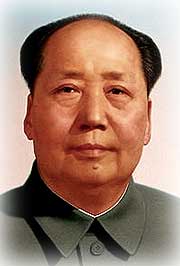 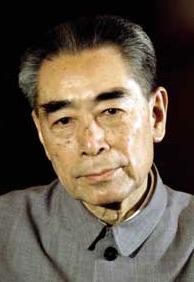 Mao Zedong Zhou Enlai 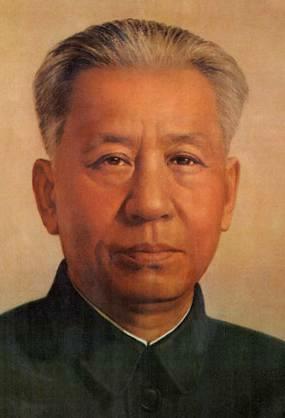 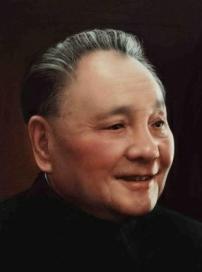 Liu Shaoqi Deng Xiaoping
Disaster. But Mao’s pet project turned out to be a mind-boggling disaster for China. The massive amount of iron created in the village foundries was of useless grade, unsuitable for any industrial purpose. In short it was all a waste of iron ore that should have been refined in industrial foundries. And overall, the whole scheme set back Chinese industrial development in other areas as well. But even worse, it also resulted in millions of deaths, the very best estimates running from 18 million to 42 million deaths (no one quite knows the numbers, they were so large – and statistics were highly unreliable. Starvation was the biggest single cause as workers were taken away from the fields to work at the village foundries, leaving the fields untended ... and agricultural production greatly diminished, leaving the country without adequate supplies of food. Exhaustion and sheer depression in the countryside were also big killers, as farmers lost their fields to the state ... and their zeal as farmers as they were themselves turned into state laborers. Resistance and ‘reeducation’ to this Maoist ideal was another killer. The political fallout. The program was due to continue until 1963, but it soon was obvious to all that this effort to force-march the Chinese toward productive greatness had become a nightmare. In July and August of 1959 Party leaders gathered at Lushan to discuss what should be done next. Chinese Defense Minister General Peng Dehuai had mistaken the nature of the meeting – at least as Mao had intended it to be – and wrote a letter to Mao, strongly criticizing some of the features and consequently recommending some changes to the program. But a very sensitive Mao reacted strongly to implications of mistakes on his part and moved to have Peng immediately removed from power ... and arrested as a "right-opportunist," replacing him with General Lin Biao. 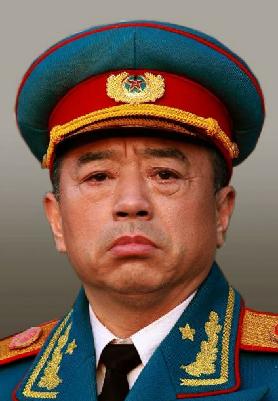 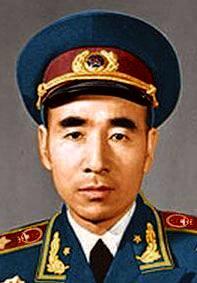 Peng Dehuai Lin Biao
Mao supporters Deng Xiaoping and Liu Shaoqi were more circumspect in their analysis of the program, cautiously suggesting some economic reforms ... which met with the approval of the Party’s Central Committee ... and increased the prestige of both individuals. Liu in fact had just been selected to replace Mao as President of the government of China and in 1961 would be named Mao’s heir-apparent as head of the Party. Mao reacts. It was clear from the way that Mao reacted to developments at the Lushan Meeting that he was not going to take criticism of his leadership without a fight. His reaction to negative comments directed at him demonstrated to all that the idea of ‘collective leadership’ was at an end and that any criticism of him would be treated as a crime against the state. Even though the Great Leap Forward program was finally put aside in 1961, by that time party officials understood well the dangers of criticizing the ‘Great Leader.’ For his part, Mao – having already experienced in the mid-1950s a loss of his prestige and position in the Party (which is what had inspired the Great Leap Forward in the first place) – at this point was extremely nervous ... even paranoid ... concerning his position at the head of the Party. Then when Soviet Premier Khrushchev was removed from power in 1964 by his own Communist Party for ‘policy failures,’ Mao’s paranoia deepened ... Mao fearing that the same might happen to him as well because of the Great Leap Forward disaster. Mao thus decided that he needed to strike first before the Party might undertake his removal. He needed to purge the ranks of the Party of any ideological ‘revisionists’ ... in other words party officials that could not be trusted to support him fully – at any level within the Party, or even the state, or even in society itself. Thus was born the idea of the Chinese "Cultural Revolution." Mao launches his new Chinese "Cultural Revolution" (May 1966)
The Cultural Revolution itself began simply as a plan to enact some needed reforms of the Party structure ... especially the bureaucratic inefficiency and petty corruption that was going on within the lower ranks of the Party. Mao had been preparing for such reform, leaving economic affairs (about which he was at this point quite obviously not a dazzling leader) to Zhou Enlai, Deng Xioaping and Liu Shaoqi ... and devoting himself to ideological reflection – the very centerpiece of his Chinese "Socialism." He was concerned about "bourgeois" or "capitalist" influences (that is, conventional economic and industrial programming) returning to China ... and even overtaking the Party mentality. The Party needed to remain extremely vigilant to ensure that such revisionist influences did not get into the Party to corrupt its vision and dedication to Socialism. 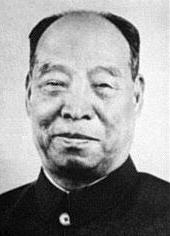 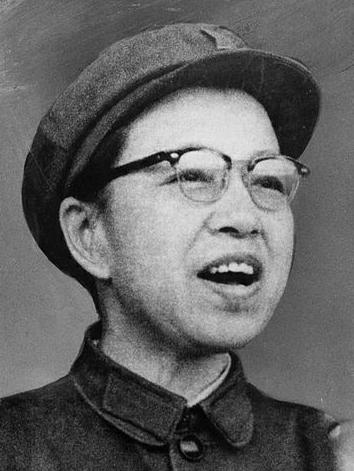 Peng Zhen Jiang Qing
In 1965 Mao convinced the Party to set up a Five Man Group of prominent Party members (headed by the influential Beijing Mayor Peng Zhen) to look into this problem. Not much action resulted at first from the efforts of this Group ... until it looked into a controversy circling around a play about a corrupt Emperor (easily identified as Mao) who unjustly fired a loyal bureaucrat. The play, written by Beijing Deputy Mayor Wu Han, had been attacked in various local newspapers by Mao’s former movie-star wife Jiang Qing and her colleague Yao Wenyuan, upsetting the Group, which had not given clearance for the publication of the article. The consequent suppression of the article by the Group was interpreted by Mao as supporting the "counter-revolutionary" Wu. It also put Group chairman Peng under suspicion by Mao as being also a "counter-revolutionary." In late 1965 Mao moved to replace General Luo Ruiqing as Chief of Staff of the People’s Liberation Army with Mao loyalist Lin Biao ... Mao claiming that Luo did not put enough emphasis on political development in his conduct of the army’s military training. As was a common result of such Maoist denunciation, Luo was forced to resign and offer "self-criticism" publicly (and in March of 1966 would attempt suicide – which failed and left him crippled). Likewise, Mao took action against Yang Shangkun, head of the division controlling inner-party communications (and close associate of Deng Xiaoping, Chinese President Liu Shaoqi, and former Defense Minister Peng Dehuai), replacing him with Mao loyalist Wang Dongxing – who would also now serve as the commander of Mao’s bodyguard force. This now gave Mao greater control over the Party’s propaganda machinery ... as well as a sense of greater personal security. He then attacked recently-appointed Minister of Culture Lu Dingyi, denouncing him for his failure to follow his own Maoist lines of thought in the conduct of the duties his office (and certainly for his membership in the Five Man Group). The "May 16 Notification." Mao now had an anti-party group to target in his campaign against "bourgeois revisionism." At a special Politburo meeting held in Beijing in May of 1966 Mao announced the "May 16 Notification." The Party needed to purge all counter-revolutionary revisionists that had infiltrated the Party. He had especially in mind Yang, Lu and Generals Peng and Luo ... the so-called "Peng-Luo-Lu-Yang Anti-Party Clique." Mao demanded that the Party put all members of the Party under close inspection, utilizing the strict standards of Maoist thought to identify bourgeois enemies of the Revolution. He had the Party dismiss the Five Man Group, demote its chairman Peng Zhen, and replace the Group with a new Cultural Revolution Group (CRG), headed by Chen Boda and authorized to oversee the process of cleansing the ranks of the Party. With this, Mao’s Cultural Revolution was finally underway. "Cleansing" the universities and schools. With the removal of Peng Zhen, Beijing became the first scene of deep Maoist action ... erupting at the Peking University at the end of May when the school’s administration came under attack by radical professors, then students, for its anti-party attitudes (not being fully Maoist in character). Classes were canceled as students paraded along the streets of Beijing, holding giant portraits of Chairman Mao and chanting Maoist slogans or quotes (drawn from his Little Red Book first published in 1964) as they went. Thus it was that the youthful "Red Guards" were first formed. Concerned about where all this street action might end up taking things, Liu Shaoqi and Deng Xiaoping formed ‘work teams’ to go to the city’s schools to meet with students and teachers to discuss Maoist ideology and bring this burst of radicalism back under control. But as these work teams included the very Party members that Mao was insisting needed to come under examination, some of the more radical of Mao’s followers wondered if the work teams themselves were not anti-party, or at least anti-revolutionary. But even as Liu insisted that these work teams were necessary to maintain some degree of order under the new ideological drive, Mao now took the position that the work teams had to go. Indeed Mao seemed to want to go directly to the people, particularly to the youth – and especially these young Red Guards – to take up the cause of cleansing the Party of its dangerous elements. This thus put Liu on the defensive. He was replaced as Party Deputy Chairman (and thus second in command in China) by the rising Lin Biao, but retained his seat on the Politburo. Then at a Party meeting in early August Mao kept interrupting a speech delivered by Liu ... even implying over the next days that the Party’s leadership at the highest level was infected with bourgeois sentiments dangerous to the revolution – which though not specifically identified as such, was clearly an attack aimed at Liu (and Deng Xiaoping). The Red Guards. Mao now followed up his words with actions, sending CRG chairman Chen Boda and Mao’s wife Jiang Qing to help organize the Red Guards to challenge Liu’s Beijing work teams ... and indeed take the offensive against ‘bourgeois’ elements all around them. They were to understand that they would have a totally free hand in doing so ... as neither Party officials nor even the police would be authorized to interrupt or block their work. Mao and his supporters went on to encourage the formation of Red Guards everywhere ... in mid-August Mao and the rising Lin Biao addressing a mass gathering of Red Guard units at Tiananmen Square (nearly a million youth attending the rally), calling all Chinese youth to action. Within weeks Red Guard units were found to be operating throughout all of China. Lin Biao called on the Red Guards to attack the ‘Four Olds’: old customs, old culture, old habits, and old ideas. At first the ‘Olds’ under attack were largely material items: books, artworks, statues, temples, churches, shrines, monuments ... and anything of historical value. School and municipal libraries, museums (containing priceless manuscripts and works of art), even cemeteries were ransacked. Even tombs of ancient emperors were opened and their remains dragged out for display and destruction. But quickly the action turned against people ... people in authority, especially teachers, local officials and even the police (who had been ordered by Mao not to intervene in the actions of the Red Guards). People were dragged from their offices and put on public display, forced to wear signs declaring their anti-revolutionary ‘crimes.’ Often they were tortured mercilessly ... even beaten to death by overwrought Red Guard gangs. By the end of September Beijing’s death count had reached well over 1700 in number. Nationally, the count of injuries and deaths was too great to record accurately. China was spinning out of control. Sadly Chinese youth, who by tradition had always been reverently respectful of their parents and elders, were now encouraged to dismiss all parental authority ... even report to the Red Guards any anti-revolutionary activity or even attitudes if they detected it in their own homes. The educational impact. All of this brought China’s education system to a complete halt. With China’s youth heading off to serve in the Red Guard, colleges and universities – and schools all the way down to the primary level – were completely shut down. The lower-level schools would gradually reopen but colleges and universities would remain closed for the next few years, with most of them in fact not reopening until 1972. Multitudes of teachers and professors were sent off to rural work camps ... and formal learning came to a virtual halt in China. Mao wanted learning to go in a new direction: basic literacy for all, especially in rural areas of the country where the rate of illiteracy was quite high (and indeed, the overall literacy rate for China did improve during the Cultural Revolution) and he wanted education to be of a more ‘practical’ nature. Thus in early 1968 he announced a new campaign calling for urban youth to move to the countryside to take up the learning of basic agriculture. Millions of Chinese urban youth joined the ‘Down to the Countryside Movement’ over the next ten years – most voluntarily (although even then under great cultural pressure to do so) – passing up the opportunity for more formal advanced education. While this in no way advanced the general educational level of the average Chinese it did help bring the Red Guard under some greater degree of control by the Communist authorities. The cultural impact. The lives of tens of millions of Chinese were completely disrupted by Mao’s Revolution, with hundreds of thousands killed directly by Red Guard action, by neglect in prison or by depression and suicide. No one is quite certain about the actual number. But Chinese culture itself was put through a great trauma ... reminiscent of the trauma that the ancient Emperor Qin put China through two thousand years earlier when he wanted to eradicate philosophies that competed with his officially sponsored Legalism ... most prominently Confucianism. And so it was also with Mao’s China. He too targeted the extensive legacy of Confucianism ... as well as Buddhism, Christianity ... and for that matter ‘religion’ in general. Maoist "struggle sessions" were set up all across China ... for those accused of harboring bourgeois, capitalist or anti-revolutionary thought, to confess the error of their ways and begin their moral rehabilitation. No one was exempt ... and millions of Chinese went through such sessions, studying Mao’s Little Red Book (over a billion printed during this period), and being re-educated by instructors commissioned to develop proper ideological thought among the Chinese people – old as well as young. Consequently, "truth" now was understood to be Maoist slogans – slogans printed, displayed, shouted or sung in order to confirm their great insights into life ... slogans in the form of gigantic posters displayed everywhere or announcements and music blared over loudspeakers to fill the air, morning, noon and night. Life was now "revolutionary" ... great things were going to happen and everyone needed to get on board or get out of the way. “Smash the skulls of the enemy and make way for the Red Terror. Long live Chairman Mao.” The whole tone of life in China thus became militant ... aggressive, angry and quite frequently violent. Social order simply disintegrated – not only as Red Guard units took charge of local life – but even as they began to compete, then even fight among themselves like typical street gangs for dominance in the ‘revolutionary’ process. Shifting political dynamics. In October Mao made his move against Liu Shaoqi and Deng Xiaoping ... accusing them of having a "bourgeois" mindset and forcing them to offer humiliating self-criticism before the Party. Both realized that politically they were in deep trouble. With Liu and Deng now demoted, Lin Biao and Jiang Qing now moved into the positions as Mao’s chief advisors and supporters. In January (1967), with Mao’s clear approval, the two led an assault on the huge Shanghai Party organization. But at a February Party meeting, Foreign Minister Chen Yi, Vice-Premier Tan Zhenlin and other generals or former generals came out strongly against the move on Shanghai, declaring that it was destroying the Party. They urged the use of the People’s Liberation Army (PLA) to break up the Red Guard units and force their members to return to school. Indeed, in February and March, PLA units moved (brutally) in a number of provinces to put this policy into action. This alarmed Lin Biao and Jiang Qing and the others of the Party’s radical wing. They grew increasingly determined to get the Red Guards to target the officer class of the PLA in order to keep the reform movement going. However in April (1967) Jiang Qing did attempt to get the Red Guards to restrain some of their activities – especially the street battles that were going on among them. But for his part, Mao did not do anything immediately to head off this growing division between the military and the radicals and their Red Guards. In July Jiang Qing took to the offensive again, encouraging the Red Guards to look into anti-revolutionary activity of local units of the PLA. Soon enough Red Guard attacks on local barracks broke out ... with the military responding in kind in some places but being restrained from counteraction in other places. Overall, China was plunging into something akin to a civil war. Meanwhile Lin Biao and Jiang Qing continued to lead the radicals’ attack on the so-called "capitalist roaders," within the higher ranks of the party ... in particular Liu and Deng (and their families). They soon succeeded in having Liu and his wife put under house arrest in Beijing ... and having Deng forced to undergo humiliating Maoist re-education training.35 But by the spring of 1968, as the PLA began to gain the upper hand (bloodily) it had become apparent even to Mao that the Red Guards were a bigger liability than asset to his Cultural Revolution and by July he issued an order ending the Red Guards’ assaults on the military. It was then in December of 1968 that he announced the ‘Down to the Countryside Movement’ motivated not just by his desire to improve the ideological character of China’s youth ... but to break up the Red Guards units by sending their members out into the countryside to work in labor camps. Additionally, he had made a similar move a couple of months earlier (October) to clean the from the ranks of the CCP of all ‘bourgeoisie’ by also sending them the countryside to undertake forced labor. It was at this time also that Liu was formally expelled from the CCP.36 By the time of the Ninth Party Congress in April of 1969, it had become apparent that Lin Biao, who headed up the PLA, was clearly in command of events (to better serve Mao of course). Members of the military were promoted in great numbers within the higher ranks of the Party ...raising the question as to whether the old Party regulars (most of whom had been purged anyway) or the military was now in charge of China. Once again, attacks were leveled at the (not-present) Liu Shaoqi and other ‘revisionists’ or anti-revolutionaries by Lin ... just to set the general tone of the gathering. Maoist Thought was now officially identified as the absolute standard of socialist law and morality ... the unique guide towards Chinese socialism. But Jiang Qing was beginning to see a threat to her own power by her once-ally Lin Biao ... despite his radical rhetoric. Just as she (and Mao) were trying to strengthen the radicals’ power base within the Party, Lin was building his own power base within the military (and thus also within the CCP by bring numerous military officers into the higher ranks of the party). And others in the party, because of their dislike of the radicalism of Jiang Qing, were being pushed closer to Lin. In October (1969) Lin even went so far as to send out military plans to the various commands in China ... without first checking with Mao on the matter. Mao was deeply annoyed ... as now another heir-apparent (like Liu Shaoqi) seemed to be usurping Mao’s own authority. At the 2nd Plenum of the Ninth Party Congress (August 1970) tensions rose when party theoretician Chen Boda placed his support behind Lin over the controversy about restoring the governmental office of State Chairman (President) which had been terminated with the fall of Liu Shaoqi ... despite Mao’s opposition to the idea. Then Chen went on to criticize the strong Maoist Zhang Chunqiao ... which Mao took personally as an attack against himself. Mao retaliated by forcing Chen off the Politburo Standing Committee ... and then turned on some of the generals by forcing them to undergo self-criticism (sending a message to Lin that Mao – not Lin – was still in charge of the military). Crisis ... and fall of Lin Biao. To Lin and his supporters it was clear that the winds of politics were turning against Lin and the military ... supposedly prompting Lin’s son (and other generals) to plan to remove Mao from power, even by assassination.37 But Mao got wind of the plot. What happened next is not clear except that Lin and his family were possibly fleeing to the Soviet Union when their plane crashed in Mongolia in September of 1971. Coming up with a public explanation of the event proved complicated (it would take months for the party to come up with a proper public explanation) – as Lin had so recently been celebrated as Mao’s political heir... even having his name and position as successor to Mao written into the party constitution. The rise of the "Gang of Four." Mao was so stunned by events that he stepped back from his usual self-promotion ... leaving much of the initiative in continuing his Cultural Revolution to Jiang Qing – and three of her political allies, Wang Hongwen, Zhang Chunqiao and Yao Wenyuan, thus constituting what was later termed the "Gang of Four." This meant that the primary agenda of the party would continue to be overseeing ‘correct thought’ among the Chinese people ... and especially within the party. But by 1973, with all resources going to the propaganda program, the Chinese economy (which was left primarily to Zhou Enlai to deal with) was stalled. Yet every effort of Zhou to get the party to put some push behind the Chinese economy stirred the active opposition by the Gang of Four. In an indirect attempt to undercut Zhou, the Gang of Four initiated in late 1973 a new propaganda campaign directed against unrepentant ‘Confucianism’ ... focusing openly on the betrayer Lin, but also not so subtly aimed at Zhou by rigorous criticism of his namesake, the ancient Zhou Emperor. Deng Xiaoping returned to power. But Mao was not completely out of the picture and in early 1973 brought his old but recently disgraced ally, Deng Xiaoping back into active service to the party as Vice Premier... to bring some balance within the party. But by this point Zhou was experiencing poor health (cancer) and Mao, seeing the economy and the post-Lin military increasingly in need of direction, assigned additional responsibilities to Deng ... making him Vice Chairman of the CCP and Vice Chairman of the Military Commission. And Deng quickly put himself to the task of making China’s steel industry, railway system and other key parts of the industrial order more efficient. But then Mao once again grew suspicious of Deng’s move toward ‘rightist’ (conservative) policies and turned on him, forcing Deng in late 1975 to take up self-criticism in penance for the error of his ways. The Gang of Four was delighted to see Deng humiliated (a second time). Zhou’s death ... and Deng’s removal from power (again!). But the death of Zhou at the beginning of 1976 had a strongly countering effect to this move of Mao ... bringing out Chinese in vast numbers to honor Zhou for his life of service to China, with Deng delivering the official eulogy at the funeral (which Mao did not attend). Shocked at this popular outpouring, the Gang of Four attempted various maneuvers to curtail the ongoing mourning of the people ... having instead the effect of angering the people against the Gang of Four and making Zhou even more the well-celebrated hero of the people. At one point in April of that year possibly two million people attended a gathering in Tiananmen Square in Beijing to honor the nation’s heroes ... but especially Zhou. 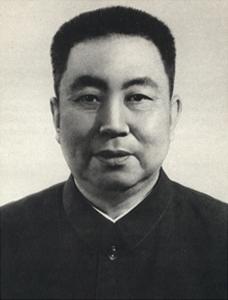 The
Jiang-dominated Central Committee ordered the police to clear the
square of the pilgrims ... and a riot ensued (with a similar
development in other Chinese cities). Ultimately Jiang brought
the Central Committee to put the blame for the incident on Deng ... and
once again he was stripped of all his party positions. The
Jiang-dominated Central Committee ordered the police to clear the
square of the pilgrims ... and a riot ensued (with a similar
development in other Chinese cities). Ultimately Jiang brought
the Central Committee to put the blame for the incident on Deng ... and
once again he was stripped of all his party positions.The elevation of Hua Guofeng to power. At this time Mao was also a very sick (dying)38 man and in February (1976) appointed a relatively unknown Hua Guofeng to take Zhou’s position as (acting) Premier ...and then after the April incident to even take Deng’s positions on the Party and State councils. Mao’s death (1976). Then in September Mao died ... and the nation went into deep mourning. China wondered ... where were things now headed? China’s relations with the larger world during the Maoist Era
Early Sino-Soviet relations. During World War Two Stalin’s Russia was fully occupied in fighting their German occupiers ... and did little to involve themselves in the war going on in East Asia among the Chinese, Japanese, Americans, and the British Commonwealth nations. But at a meeting at Yalta in February of 1945 – as it became apparent that Germany was on the brink of defeat ... and as the war in Asia seemed destined to continue another horrifying two years – Stalin agreed the enter the war on the American-Chinese (KMT or Nationalist Republic) side against the Japanese. Stalin agreed to engaging the Japanese in Chinese Mongolia (‘Inner Mongolia’), Manchuria and other parts of northern China. Stalin promised Chiang that the Russians would respect China’s sovereignty in these areas ... and that the Russians were interested only in bringing the Japanese to defeat. On the other hand Stalin expected Chiang to allow Russian independent use of the vital railways linking Soviet Siberia with the Russian ports of Lushun (or Port Arthur) and Dalian where the Soviet navy had year-round ice-free naval bases. Of course Stalin had greater ambitions in the region than that ... but was subtle in the way the Russians whisked away to war-devastated Russia the industrial property located in the areas they came to occupy as they received the abrupt surrender of the Japanese that August. And though in theory they were allied with Chiang’s Nationalist Government (the Sino-Soviet Treaty of Friendship and Alliance of August 1945) the Russians saw to it that weapons and other war material that they received from the surrendering Japanese would fall into the hands of Chiang’s ongoing enemy, the Chinese Communists. Nonetheless, the outward appearance of diplomatic friendship between Stalin’s Soviet Union and Chiang’s China was maintained ... all the way up until 1949 when Mao was able to declare the creation of the (Communist) People’s Republic of China. In February of 1950 PRC President Liu Shaoqi negotiated with Stalin a new Sino-Soviet Treaty of Friendship, Alliance and Mutual Assistance ... in which Stalin formally recognized Mao’s government as the official government of China, agreed to give to China the ports of Lushan and Dalian, and to extend a $300 million loan to China to help in its development (much less than Mao had been hoping for). Also informally, Stalin withdrew support of the Uyghur nationalists in the far western Chinese province of Xinjiang who had set up the East Turkestan Republic during the days of Chiang’s Nationalist Republic. When the Korean War broke out in mid-1950 some considerable back and forth negotiations went on as to the role that both Soviet Russia and Mao’s China were to play. In the end, with the Chinese taking the initiative in sending ground forces into Korea to fight the ‘UN’ (American) troops, the Soviets agreed to offer air cover to the Chinese ground troops. This joint service brought Mao and Stalin together in a very close relationship ... that would last until Stalin died in 1953. Relations with America. America did what it could to isolate from the international community Mao’s PRC ... especially with the outbreak of the Korean War and China’s involvement in it. Then during the first half of the 1950s Senator Joe McCarthy did what he could to advance his own political career nationally with his sweeping charges that America was about to be done in by a grand Communist conspiracy operating not only from abroad but also from points high up within American society and government. Thus any willingness to work with Mao’s Communist China (which most every other European country was originally willing to do) came to be viewed as some form of complicity in this Communist plot to destroy America and the "Free World." No Americans, not even President Eisenhower, wanted to touch this hot rail laid out by McCarthy ... not even after his political fall in December of 1954. Ironically, the very effort of America to isolate Mao’s China in every way possible – not only blocking Communist China from taking Chiang’s China seat on the UN Security Council but also leaning on American allies to follow the U.S. lead in boycotting China socially and economically as well as diplomatically – served Mao nicely in giving him a free hand in reshaping Chinese society according to his own design ... with no foreign intervention to have to deal with. Indeed, the days of British, American, French, German and even Japanese intervention in Chinese affairs were over ... very over. A "Third World" leader. Nehru’s India was quick (1949) to recognize Mao’s new Communist government of China – even acknowledging China’s claim to sovereignty in Tibet ... provided that India’s traditional trade rights with Tibet and the traditional Lamaist-Buddhist social structure of Tibet continued to be respected by China. In 1955, leaders from 29 Asian and African states met in Bandung, Indonesia, to chart out a diplomatic course for their countries as neutrals or nations "non-aligned" to either Russia or America in their Cold War (thus the concept of the "Third World"). Communist China was one of the countries participating, presenting itself as belonging to the Third World rather than the Russian Soviet orbit. Actually, China was trying to distinguish itself from the Soviet Union – looking to establish an independent identity entirely of its own. It in no ways considered itself a "satellite" of the Russian Soviet Empire. Indeed, it was looking forward to establishing a sphere of influence of its own, in Asia – and possibly throughout the entire Third World. America remains blinded about China’s role in the Cold War. America, however, remained caught up in such an intense "Red Scare" that it missed entirely this distinction that China itself was attempting to make between its larger interests and those of the Russians. It would not be until Richard Nixon became U.S. President in 1969 that America would acknowledge that China was not merely a Soviet puppet state operating under the Kremlin-dominated Communist International, but instead a distinct country with its own particular set of interests that American diplomacy could work with. America and Chiang’s KMT government on Taiwan. At the same time America remained firm in its determination to recognize the legitimacy of only Chiang’s KMT Government, now transferred to the huge island of Taiwan ... moving the American Seventh Fleet into the waters separating the island from the mainland to prevent Mao’s forces from also taking Taiwan. Soon Taiwan rapidly developed industrially on its own – making it along with Japan, Hong Kong, and Singapore one of the four ‘Asian Tigers.’ But the island also became the scene of considerable political repression, as Chiang remained resolute that only the KMT (and his Han Chinese KMT mainlanders who were ethnically distinct from the Taiwanese natives) should ever rule Taiwan. Only after Chiang’s death in 1975 when his son took over, did the island’s political restrictions begin to lighten. But the growth of a strong commercial middle class also helped move the island to an ever-widening political openness towards the end of the 1970s and early 1980s. The Sino-Soviet split. In 1956 Nikita Khrushchev made his way to the top of the Soviet or Russian Communist Party in promoting the idea of a thaw in the Cold War with the Capitalist West. This did not please Mao at all, who began to distance himself from Khrushchev during the latter part of the 1950s ... and in 1961 openly and loudly accused the Soviets of being "revisionist traitors." But there was more to the matter than a warming of relations with the West. Khrushchev and Mao had distinctly different ideas about how to advance the cause of Socialism ... and Moscow and Beijing were also at that point competing against each other for control of the rising Socialist tendencies among the newly emerging Third World countries of Africa, Asia and Latin America. Mao had made it very clear in China that the European strategy for advancing the cause of Communism – which was built on the evolution of industrial capitalism there – would not work in the peasant-based societies of China and the East. This is why Mao had created his own Maoist strategy ... one that was more relevant to the actual social-political situation facing the Third World nations. Moscow’s version of Communism would not work there. Mao’s would. And it became imperative to Mao to prove his point ... not only in China but throughout the larger world. Conflict between Moscow and Beijing was thus just as inevitable as it had been within China’s own Communist Party where this same issued divided the Maoists from the CCP ‘revisionists’ (as Mao termed his personal opponents). And of course a lot of this was simply the battle of egos among leaders ... with Mao having an enormous ego to defend and advance. One issue after another only deepened the split. Albania had refused to de-Stalinize and had been cut off by Moscow ... with Beijing then rushing in to offer aid to Albania (and moving it into the Maoist orbit). Tempers flared between the Soviet and CCP delegations at international meetings of the Communists in 1960 and 1962 – the Russians accusing the Chinese of dangerous adventurism that could plunge the world in nuclear war (Khrushchev was even coming to believe that Mao actually suffered from dangerous bouts of insanity) ... and China accusing the Russians of having abandoned the cause of Communist revolution. Also tensions between China and Russia had been building since the 1959 Tibetan uprising (against the recent Chinese takeover over the Tibetan Buddhist society and culture) – an event in which India and Russia openly supported the Tibetans Finally, the breaking point between Moscow and Beijing occurred when Moscow openly sided with India during the brief but bloody war that broke out in 1962 along the Himalayan border between India and China. That year Russia and China broke off further diplomatic relations (with a huge loss in Soviet economic aid to China). With Khrushchev’s replacement in 1964 by Brezhnev as the Soviet leader, Mao hoped relations could be restored ... and sent Zhou Enlai to Moscow to explore that very possibility ... only to have Zhou return disappointed. Little had changed in the basic thinking of Moscow on strategic matters. The Soviets seemed more interested in achieving stability in their relations with America (as per the 1967 Glassboro Summit meeting between Soviet leader Kosygin and American President Johnson) ... than in restoring a working relationship with China. Only in the area of supporting the Communist North Vietnamese effort to conquer the pro-Western Saigon government of South Vietnam did the two countries cooperate ... China allowing Russia to send war materials across China to the North Vietnamese capital of Hanoi. But as Mao’s Cultural Revolution deepened, relations between Russia and China worsened further. An age-old quarrel had been revived in 1966 concerning the ‘unequal treaties” in which China had been forced in 1858 and 1860 to grant Russian sovereignty over northern lands in Siberia that China claimed as historically part of their realm. The Soviets were not interested in adjusting those borders. Then in early 1967 Red Guards attacked the Soviet Embassy in Beijing. Mao eventually responded to this Red Guard action ... not in response to Soviet injury but to bring the youthful radicals under control because their behavior was weakening China’s hand internationally. During the years of Cultural Revolution, the Soviets had by 1968 doubled their military divisions to 25 in number along the northwestern border with China (China’s Xinjiang Province, inhabited by Muslim Uyghur Turks), in part due to the Soviet fear of what Mao’s intentions were since exploding China’s first nuclear bomb in the region in 1964. China on the other hand feared that the Soviets intended to knock out their nuclear facility at the Lop Nur basin nuclear test site in Xinjiang. China had thus come to station 1.5 million troops along the same border, expecting trouble. This in turn caused the Soviets to fear that China might unleash his massive army to take Soviet territory, cutting off the Trans-Siberian Railroad and access to the Russian port of Vladivostok. Tensions mounted during 1968. In March of 1969 Chinese troops conducted a surprise attack on Russian border guards on the small Zhenbao Island in the Ussuri River serving as part of the Russian-Chinese border. The Soviets responded by sending tanks against the Chinese ... and a stalemate developed. But further west along the border other small incidents like this occurred that August as tensions remained high. America re-enters the picture. The border clashes produced a swell of Chinese nationalism which strengthened further the hand of Lin Biao who was moving to curb to Red Guards and elevate the PLA to increased prominence in Chinese politics. The clashes also produced the idea of possibly working more closely with America in countering Soviet power. At this point (and for the next ten years) the Chinese dislike for the fellow Communist Soviets greatly exceeded the dislike they held for Americans. Besides, the Chinese figured that they could play the diplomatic game as well as did anyone else ... reversing a developing Soviet-American friendship ( America had been working with the Soviets in an effort to block Chinese nuclear development). The first move in the thaw in the long-standing Cold War between China and America came in April 1971 at the World Table Tennis Championship held in Japan ... when American players were invited to come to China ... the first American group to set foot formally in China since 1949 (although the militantly anti-American or at least anti-White Black Panthers had been allowed into China previously for a one-week visit). Much in both China and America was made of this visit to China of the ping pong players and the accompanying journalists. As American President Nixon and his National Security Advisor Henry Kissinger had already been talking about political overtures to China, the ‘table-tennis diplomacy’ clearly opened the way for Kissinger to make a secret visit to China that July to investigate (with Zhou Enlai) the possibility of better Chinese-American relations. The response was positive. Thus the following February (1972) President Nixon and his wife (and lots of journalists) flew to China ... a shock to so many because Nixon had earlier gained the reputation as a major ‘Commie-hater.’ But the mood was warm (Nixon even briefly met with Mao) ... pointing to a new ‘relaxation’ (détente) in Chinese-American relations. The net result was that America now would no longer block the move of Communist China finally to take the prestigious China seat at the United Nations.39 And from this point on, better relations between the countries would slowly develop. Indeed, in 1974 former U.S. Ambassador to the United Nations and future U.S. President, George H.W. Bush (the first of the two Bush presidents) was appointed as America’s envoy to China, serving in China for the next 14 months (before being returned to America to head up the C.I.A. in order to clean up a scandal shaking the American intelligence agency). In 1979 American President Jimmy Carter would transfer formal diplomatic relations from the KMT government in Taiwan to the CCP Government in Beijing. 33They were classed as ‘volunteer’ troops by the Chinese in the attempt to avoid the appearance of a direct war being conducted by the Chinese against the United Nations troops. But they were hardly ‘volunteers.’ 34Because of this action, among Americans at home MacArthur was viewed at the times as the hero – and Truman as a coward, if not almost a traitor. But a Congressional investigation concluded that Truman had indeed acted constitutionally ... and correctly ... and that MacArthur (who actually spent all his time in Tokyo) was out of touch with the military realities in Korea (not to mention the rest of the world). 35In 1969 Deng was sent off to work in a factory where for the next four years he would work as a common laborer. But he would survive ... and later rise again to power – although in 1968 his son Deng Pufang was tortured – and broke his back falling (thrown?) from a 3-story window at the Peking University... and ended up a paraplegic. 36Liu eventually was sent to a detention camp where he was regularly beaten and then – gravely weakened by his treatment and by an untreated case of diabetes – died of pneumonia in November of 1969. 37There seems to be some strong evidence that Lin himself did not plan the coup. In fact some have come to question the idea that there was a plot at all. 38Mao had always been a heavy smoker and thus suffered from various lung and heart diseases ... and possibly also from the crippling Parkinson’s disease (attacks the central nervous system). 39Mao offered Chiang some form of dual representation of China at the UN. But Chiang refused the offer. Consequently, the PRC backed away from its willingness to give some kind of recognition of Taiwan’s sovereign rights as a distinct nation. Thus it is that Taiwan, the 22nd largest economy in the world, finds itself today with no official diplomatic recognition at the UN or elsewhere. |
|
|
Hua has the Gang of Four arrested
Soon after Mao’s death – and much to everyone’s surprise – the supposedly weak Hua (who nonetheless enjoyed strong support from the military and the party moderates) had the Gang of Four arrested (October 1976). It was the Defense Minister Ye Jianying that had tipped Hua off to the fact that the Gang of Four and some of the generals were plotting to overthrow him ... leading Hua to move so quickly. Perhaps not surprisingly, celebrations broke out across China at the news of the arrest of the four. As Hua now found himself clearly in command in China, he cleverly wrapped Mao’s legitimacy around his own rule ... by claiming that he was merely supporting Mao, in following "whatever" – or more formally, the "Two Whatevers"40 – that had formerly been Mao’s own ideas on all matters. But Hua also had his own agenda ... which was to push past the Cultural Revolution and resume the quest for Chinese industrial development – along lines similar to the Soviet industrial development of the 1930s (emphasizing the State’s development of heavy industry). Nonetheless, the "Two Whatevers" would anchor Hua firmly in the Maoist propaganda mode as his more general approach to leadership (including Hua’s efforts to develop his own ‘cult of personality’ alongside Mao’s images). Deng restored to power (again!) – 1977
With Mao and the Gang of Four out of the way, the Central Committee at a meeting in mid-1977 felt sufficiently emboldened to call for the restoration of the disgraced Deng, exonerating him from responsibility for the Tiananmen Square incident, and elevating him to position as Vice-Chairman Xiaoping (despite Hua’s strong opposition to this restoration of Deng). The Central Committee went even further in declaring the Cultural Revolution officially over ... blaming all the obvious excesses and social failures of the Cultural Revolution on the leadership of the Gang of Four. Step by step Deng expanded the reach of his authority (as he also moved to undercut the position of the relative lackluster Hua), so that by mid-1978 Deng had succeeded in moving a number of personal supporters into positions of power, notably Hu Yaobang – who would eventually become the CCP’s General-Secretary – and Zhao Ziyang – who would become Chinese Premier. Then he began his move to neutralize the Maoist legacy ... by bringing out to discussion a self-criticism of Mao’s issued in 1962 in response to the failed Great Leap Forward – and by bringing Hua to criticize openly his own "Two Whatevers" policy. Further, Deng began to look to the restoration of the reputation of Communists who had been purged during the Maoist Cultural Revolution ... even in late 1978 conducting a belated (eleven years after his death) state funeral for the disgraced Liu Shaoqi. Deng also promised the Chinese people that the CCP was now pledged to never ever again let such a catastrophe as the Cultural Revolution fall on them again. Deng undertakes the "Four Modernizations"
At the critical Third Plenum of the Eleventh National Party Congress in December of 1978, Deng called for China to move its primary focus away from propagandizing the Chinese population (Mao’s greatest interest) and instead look to the ‘Four Modernizations’ first proposed by Zhou Enlai back in 1963: the development of agriculture, industry, national defense and science and technology. He was aiming in particular at de-collectivizing China’s farmlands and cutting back on the government controls of the country’s industrial sector. Deng was even so bold the next year (September 1979) at the Fourth Plenum of the Eleventh National Party Congress to take an honest look at the entire 30 years of Communist rule in China. While being upbeat about the general record of CCP achievements during that period they were blunt in pointing out some times of trouble and error ... especially the time of the Cultural Revolution which was a horrible disaster and enormous setback to the socialist cause (and though not mentioned by name, the blame was clearly understood to fall on Mao). This meeting was soon (early 1980) followed up by the demotion of a number of ‘leftist’ party members, essentially Hua’s supporters. China’s foreign policy during this time of transition
Frosty relations with the Soviets continued as before ... but greeted Communist Yugoslavian leader Josip Tito with great enthusiasm in Tito’s visit to Beijing in May of 1977 (Tito had long been on the outs with Moscow) and in October Deng flew to Japan to sign a peace treaty formally ending the Sino-Japanese War (World War Two). The Cambodian-Vietnamese-Chinese conflict (December 1978-January 1979). On the other hand, relations with Vietnam and Cambodia got very messy. Formerly China had been supporting the ‘Maoist’ Khmer Rouge Communists in Cambodia in their effort to overthrow the Cambodian monarchy. The Khmer Rouge victory in 1975, and the subsequent slaughter of "bourgeois" Cambodians in a follow-up cultural cleansing that was reminiscent of Mao’s Cultural Revolution, quickly managed to reach levels of violence that greatly exceeded even the 1960s violence in China (Westerners spoke of the "killing fields" of Cambodia in reference to what was occurring in Cambodia). Meanwhile tensions had been mounting between Cambodia and the neighboring Communist Vietnam (a Soviet rather than a Chinese client state) and border conflicts had been occurring along with the general chaos in Cambodia. Finally in December of 1978 150,000 Vietnamese troops marched into Cambodia, quickly occupied the country, and ousted the Khmer Rouge government ... and replaced it with a client government under Vietnamese tutelage. But Deng took exception to this move of Vietnam against Cambodia ... and responded in February of 1979 with a full-scale Chinese invasion of Vietnam. But things did not go well for the Chinese ... despite the fact that the Vietnamese army was away in Cambodia and China consequently found itself facing only Vietnamese militia. But the Chinese PLA was in poor shape and immediately lost thousands of soldiers ... and withdrew after only three weeks, claiming that it had "met its objectives." Actually quite the opposite was true. It had been a humiliating defeat for China. Instead, the event demonstrated clearly that its own army was in terrible shape and that it was in no position to dictate policy to Vietnam. But the Chinese also learned that the Soviets had no real interest in another conflict with China. Deng’s trip to the United States (February 1979). At exactly the same time that China was invading Vietnam, Deng was on a visit in America, receiving from President Carter full diplomatic recognition, including the exchange of Ambassadors (and not just envoys). With this went America's acknowledging that China was indeed something of a world power ... and not just a bad ideological experiment. The Gang of Four brought to trial (November 1980-January 1981)
In November of 1980, in a grand show before the Chinese national audience, the members of the Gang of Four – plus supporters of the disgraced Lin Biao – were brought before a tribunal to account for their "anti-party" activities during the Cultural Revolution. Jiang Qing was emotional and defiant during the trial, Zhang Chunqiao would admit to no wrongdoing, and Wang Hongwen and Yao Wenyuan repented publicly for their crimes. Aimed at them were particularly the horrifying statistics concerning the extent of the persecution and the number of deaths caused by the Cultural Revolution (never exactly a precise number, however). Jiang and Zhang were sentenced to death (though the sentences were later commuted to life imprisonment). The other two members of the Gang of Four, plus Chen Boda and other Lin Biao followers, were given lengthy prison sentences. And that June (1981) Hua stepped down from his position as party and military leader. But in fact it was the deceased Mao Zedong who had been on trial during these days ... and now party officials were even so bold as to say so directly – though they were quick to point out that although Mao was responsible for the grand disaster that was the Cultural Revolution, overall he had done the country more good than harm (Deng stated: “7 parts good, 3 part bad”) ... and that he should be remembered as such. But whatever the verdict, one thing was clear: the Maoist Era in China had come to an end. Deng's reforms
Economic reform. As Deng took charge of the CCP in the early 1980s, he pushed for the creation of Special Economic Zones where foreign investment would be allowed to set up and run on a capitalist basis, with light industry leading the way eventually to heavier industry. The state would still be in charge of infrastructure projects (roads, dams, etc.) ... but private industry would be supported in its move into light industry production (consumer goods). Also the Chinese economy would be opened up to foreign trade and banking ... allowing China to purchase needed advanced industrial goods – with new openings for Chinese goods abroad in exchange. The West was quick to respond to this new relationship And unlike Mao’s emphasis on peasant culture, Deng specifically called for the development of a robust Chinese middle class, one that would raise up the level of the nation’s standard of living (consumer goods, educational level, general health). This is not to say that Deng ignored the vital role of Chinese agriculture. Actually this area of the economy too received a freeing up, allowing Chinese farmers to sell the produce of their private plots on the local market. In short, under the new direction set out by Deng (but taken up rather naturally by the Chinese themselves) market factors rather than ideology would be the key motivating force behind the development of the Chinese economy. This would become (as Deng termed it) ‘market socialism’ ... more natural to Chinese social instincts. Political reform. The Chinese Constitution was revised in 1982, with Chinese executive leadership vested in two (not one) offices: the Premier of the People's Republic of China (heading up the State) and the CCP General Secretary (heading up the Party). Deng's understanding was that by dividing power between two offices, China could avoid the development of another "cult of personality" as had existed under Mao. Actually, Deng took neither of those two positions for himself (he wanted a younger generation to step forward to those responsibilities) ... though clearly he himself remained in command of China and its new direction. The One-Child Policy. In 1979 the Chinese government announced a new policy designed to bring under control the rapid growth of the Chinese population. Families would be allowed to birth only one child (a second child was usually permitted if the first child was a girl). Clearly the Chinese population was growing far more rapidly than the Chinese economy ... pushing Chinese families into deeper poverty. Thus the new policy was generally greeted with willing support (fines were imposed if the policy was not heeded) ... although a drop in the birth rate had already begun even before the new policy was announced. (The policy would remain in force until 2016 when a two-child policy replaced the former one-child policy). Cultural reform. Accompanying this economic and political liberalization was a new mood cautiously asserting itself, most clearly manifest in the 'Democracy Wall' which made its appearance in Beijing in 1978 ... where posters were hung criticizing Mao and the Gang of Four ... and even Hua. But restrictions were placed on the postings when calls for Western-style elections was called for. The CCP made it clear that while the Chinese could expect much in the way of pragmatic economic and social reform, the country would remain under the direction of the CCP. Nonetheless, an unprecedented degree of criticism of economic and social failure was beginning to be allowed to be aired. The Chinese were coming to expect better things of their new leaders. One of the new freedoms was registered in the lifting of the Maoist restrictions against the practice of religion imposed during the period 1966-1976 (the only religion at that time allowed in China was Maoism itself). Five faiths were given official recognition – and the right to worship openly (as long as they did not oppose either the CCP or Socialism): Taoism, Buddhism, Islam, Catholicism and Protestantism. Unlicensed ‘house churches’ (mostly Protestant) however were forbidden (but existed widely anyway). Chinese foreign policy during the 1980s. Needless to say, Chinese relations with its Vietnamese neighbor remained tense during the 1980s. Both countries stationed around 30 divisions at the border, with mutual small-scale shelling occurring frequently. Only at the end of the 1980s did Chinese-Vietnamese relations begin to improve. Chinese relations with Russia remained largely the same: icy. In 1982 China’s Foreign Minister Huang Hua was sent by China to attend former Soviet leader Brezhnev’s funeral – where Huang had positive and hopeful messages to bring to the Soviets (though he overstated the case and was removed from office on his return to China). To the great distress of Chine, the Soviets continued to support the Vietnamese occupation of China’s former ally Cambodia ... and Soviet and Chinese troops continued to be amassed along the border between the two nations. When Reagan took office as U.S. President in 1981, relations with America underwent deep strains. Reagan had been highly critical of the détente policy of the previous Administrations (Nixon’s, Ford’s and Carter’s) claiming that America had received little in return for its generosity to its Cold War adversaries ... and that America was going to focus more on defending and advancing its own national interests in the competitive diplomatic world. Predictably, Chinese reactions were very hostile. But gradually Reagan lightened up on his rhetoric ... especially as urged on by his Vice President Bush – who had served formerly as the American envoy to China (and had been part of the détente policy) The Tiananmen Protest Movement ...
and the changing of the guard at the CCP Mounting liberal-hardliner tensions. All of this new freedom seemed to be accompanied by problems of local corruption, migration from the countryside to the cities, inflation, a growing sex trade ... and sometimes quite aggressive press and academic criticism of the CCP’s failures to meet the rising expectations of the Chinese people. Hardliners (numerous within the army) had been critical of the speed and extent of Deng’s reforms and in 1983 were able to get the CCP to retake the old Maoist campaign of ideological struggle against the "moral deviation" going on within the country (everything from Western hair styles to pornography). But Deng was soon able to get the CCP turned back to a continuation of his pragmatic reforms. Then in late 1986 Deng’s policies came under attack by the hardliners when a professor – and a growing number of university students – began to protest loudly that the reforms were going too slowly and too cautiously. The hardliners direct their animosity over these developments against the CCP’s General Secretary, Hu Yaobang – a key Deng supporter and major reformer – forcing him from power in early 1987. Although another reformer Zhao Ziyang took his place as the party’s General Secretary, a major hardliner, Li Peng, was elevated to the position as Premier. Zhao attempted to continue the reforms ... but by mid-1988 was running into stiff opposition from hardliners who were blaming the reforms for the strong inflation rocking the country. The debate between reformers and hardliners stiffened through the rest of 1988 and into 1989 ... as the hardliners wanted economic policy to move in the direction of tighter state control of the economy. Meanwhile the public was growing impatient over the inflation ... but also the question of the speed and direction of the government’s reforms. Students and intellectuals were demanding that the government liberalize even more (not harden) its hand on the economy. The disintegration of the Soviet empire (1989). Two events would bring these tensions to a full-blown political crisis in 1989. One of these was the meltdown of the Soviet Empire in Europe. Gorbachev’s attempts to liberalize the Soviet hand over Russia’s satellite nations (East Germany, Czechoslovakia, Hungary, etc.) was producing not Communist reforms but instead the full abandonment of Communism. This development became very suggestive in a positive way to both Chinese students and intellectuals – who advocated for a similar thing to happen to China – and in a very negative way to the hardliners – who were quick to point out how Deng’s reforms were likely to lead to exactly the same collapse of Communism in China. Even Deng now appeared to be rattled by events within the dying Soviet empire ... making it clear that China was not anywhere near ready for democracy – that such democracy would merely throw China again into a state of civil war. The Tiananmen Square protests (1989). The other event was the death of the deposed, but well-loved (by reformers anyway) Hu Yaobang in April of 1989 ... and the gathering of multitudes of students in Beijing’s Tiananmen Square to mourn his passing – and to protest against the slow pace of national reforms. Soon the example of the students protesting in Beijing spread to other cities across China. As the protests dragged on week after week, Deng (who was actually head of the Central Military Commission) in May joined with the hardliner Premier Li Peng to arrest some of the leaders of the movement and declare martial law in Beijing ... overriding the objections of the party General Secretary Zhao Ziyang and other reformers on the party’s Politburo. But martial law seemed not to discourage the protesters, who continued to gather in the hundreds of thousands (some say as many as a million at one point) in the Tiananmen Square demanding new freedoms. Finally the government ordered the clearing of the Square by the military, who moved in at night on June 3-4 and brutally broke the occupation of the Tiananmen Square ... causing the deaths of hundreds – or even thousands (figures are unknown because reporters were forbidden to be present during the clearing process and the government suppressed all specific accounting of the event. In China the Tiananmen Square protest and its suppression became officially a ‘non-event’ – forbidden to be discussed publicly in China. Only Deng’s praise for the military units that crushed the rebels received public attention (some army units had refused to take action against the students and were punished severely). And for his objections to the military action, Zhao Ziyang was not only dismissed from his office as party General Secretary but put under house arrest – remaining there until his death 16 years later. The event for a while produced a distancing of the CCP from its Western friends, including America. Congress voted to cut off all further sales of military items to China, and found itself very vigilant in tracking the violation of civil rights in China. Bush also was at first highly critical of the Tiananmen tragedy, but then backed off, trying to keep a positive attitude towards China's continuing development.
Jiang Zemin (1989-2002)
But even here, Chinese reform paid a huge price. In putting in Jiang's hands direction of all key state and party matters, this ended Deng's policy of checking and balancing power at the top. Once again, the party and the state had come under the command of a single individual Hu Jintao (2002-2012)
As a Chinese leader, he was rather collective in his style, quiet in his "presence" in public, and focused more on the growing role of technology in the process of national government. And, like Jiang, at the end of his two terms of power as China's leader, he stepped aside to allow a new individual to take his place. Xi Jinping (2012 to the present)
He took Hu's policy of tightening the party's grip over Chinese social dynamics – and the party leader's control over the CCP itself – even further than Hu. Censorship of the press, widening mass surveillance of China's internet communications, his internment and removal of Uyghur Muslims in the Xinjiang province are some of the more notable way that Xi went about the business of bringing greater personal control of the doings of the Chinese nation. Indeed, in March of 2018, the National People's Congress voted 2,964 to 2 to remove the Constitution's two-term limits on the presidency – limits observed since the reforms of Deng Xiaoping in the 1990s. This was quite indicative of how Xi had eliminated the collective leadership of the country in order to make himself the sole determiner of China's policies and programs, something not seen in China since the days of Mao Zedong but something that looked a bit like the situation still going on in North Korea – where the Great Leader does the thinking for all the people.
Xi moves to replace Chinese cooperation with Chinese dominance
The Chinese economy becomes truly global. Over the years, but especially as things developed in the Hu and Xi years, tensions had been growing between the West and China over the dramatically one-sided trade relationship that favored China because its economy had been allowed to be protected by Chinese mercantilist policies as it entered the competitive world market. But with the rapid growth of the Chinese economy, the age of the need to protect an infant market system was long past. But the protections remained in place. As a result, cheap Chinese goods flooded the world market, driving out Western producers, and sending trillions of dollars to China as a huge growing dollar reserve – allowing China additional social leverage in its dealings with America. The Chinese used that dollar reserve not only to buy oil for its hungry economy (growing at an annual rate of 9 to 10 percent annually since the 1980s and thus doubling in size approximately every seven years) driving up the price of oil in the process, but also purchasing other scarce minerals, purchasing land development rights in Africa and Latin America, but also buying up the debt of European governments – thus helping them keep afloat, but also placing them as debtors under very persuasive Chinese influence. However, it was not just troubled European governments that were sliding into this relationship. The American government also was headed rapidly down this road as it attempted to keep the American economy afloat with government spending, which meant government debt, which meant a larger claim of China on the American government and economy as it gladly bought up American debt with its dollar reserves. What the American and European economies really needed to get back up and running was a reversal of this dynamic. And that would have to start with the Chinese allowing its currency, the renminbi (also known as the yuan), to float to a true market exchange value. But the Chinese were not willing to do that. The whole system worked beautifully to the advantage of the Chinese economy. A more expensive renminbi would lower considerably the Chinese ability to export its production, forcing a cutback on production and increasing unemployment within the huge Chinese work force. Of course, failure of China not to free
up its currency was having exactly the same effect on the American work
force. So the problem was not one of "let's find a compromise," but
rather "who is going to win and who is going to lose in this economic
tug of war." As negotiations with the Chinese moved forward, it was quite apparent that the Chinese were not
going to budge. They figured that they had a lot to lose if they did
so. The West was wealthy and could take the heat better than China. But Westerners were becoming very agitated over the high
unemployment and general stagnation of the economy. In addition to these economic issues, American President Obama's decision to "Pivot to Asia" greater American military-diplomatic involvement was received by the Chinese as some kind of new American containment policy with respect to China. Obama's idea was to strengthen America's relations economically and militarily with other Asian powers, such as Australia, South Korea, Taiwan, etc. Obama claimed that the Pivot to Asia actually included a greater emphasis on Chinese-American relations as well. But the Chinese leadership was not convinced that this was indeed the case. Xi moves to take command of the South China Sea. Also the long-standing role of America as protector of the freedom of navigation through the South China Sea began to come under Chinese challenge when Chinese President Xi Jinping began to talk aloud about protecting its own territorial rights in the South China Sea – territorial rights which literally reached close to the shores of the numerous countries ranged around that sea. Xi defined the South China Sea as "Chinese territory." This deeply alarmed Japan, South Korea, Taiwan, Vietnam, the Philippines and Malaysia, all of which must pass through some or all of the South China Sea in order to trade with Europe, the Middle East, India, etc. China agreed to negotiate maritime rights with the border countries, notably Vietnam, the Philippines, and Malaysia, but made it clear that oil and gas reserves belonged to China alone, and all fishing rights would have to come under Chinese authority. But in 2014 the Philippines challenged China on this matter at the Permanent Court of Arbitration (at The Hague, Netherlands). Other Southeast Asian countries soon did the same. In 2016 the Court decided in favor of the Philippines. But China was not moved by this decision. Meanwhile the Chinese in 2014 had begun dredging reefs in the Spratly Islands group (close to the Philippines), creating islands on which they could then build naval and military facilities, with the obvious intent of enforcing their territorial claims from these man-made islands. By the beginning of 2016, work there was completed. Also, China was strengthening its navy with the building of yet another aircraft carrier, by which they could also patrol "their waters." In 2016, both America and China conducted naval exercises in the South China Sea, in an attempt to make their points, in opposition to each other: America to keep the sea open as international high sea – and China to assert its full sovereignty over the sea. But in the end, China had taken a vastly stronger position in the dispute – one that would only swing even more strongly in China's favor in the future. There really was little at this point that Obama was willing to do ... fearful of starting a war with China. But that certainly was not going to happen. China was not looking for war – just strategic position. Then why, for instance, hadn't Obama also ordered the dredging and military island-building of America's own naval base, somewhere else in the Spratly Islands, as a countering emplacement of American power designed to protect the status of the South China Sea as international high sea? Ultimately, his "Pivot to Asia" came with no muscle.
Meanwhile, Xi continues quietly to advance China's political,
economic and diplomatic position around the globe. China, under its
potential President-for-Life, Xi Jinping,
was moving ever forward in a grand effort to replace America as the
world's leading superpower – even the only superpower still standing
after America would take its inevitable fall, as had every other
Western superpower since the decline of Spain in the 1600s and 1700s
(even just in the 20th century alone: France, England, the Netherlands,
Russia, etc.) This goal became quite clear back in 2015
when Xi announced a new Chinese 10-Year Plan, "Made in China 2025." The
heart of the Plan involved the development of a number of areas in the
realm of high-technology, economic realms which would receive a large
amount of government protection and support, designed to give China a
commanding position in the international technology market (robotics,
telecommunications, artificial intelligence or AI in a wide range of
fields, etc.), in the bio-medical market, in industrial materials
development, and in the establishment of global purchasing and sales
networks. The international strategy or game that
China played was a subtle one: avoid direct confrontation where
possible, but gradually (and quietly) take a vital position of control
here and there, in small bites, of course, so as not to spark a
reaction from America and the West at any particular point.41 Anyway, America had been so distracted
with events in the Middle East since the beginning of the 21st century
that it was not really paying attention to what was coming out of East
Asia. Bush, Jr. was so wrapped up in Afghanistan and Iraq that he had
no time to focus on developments in East Asia. And Obama thought he
could charm the world into niceness, failing to respond strongly to
challenges to America's vital points of placement on the global playing
field. Also, it is important to note that China
alone mines most of the world market's "rare metals" vitally needed by
today's technology (such as cobalt), and a shutdown, or even slowdown,
would cripple the ability of the world beyond China to continue to
develop that technology. These metals are also found elsewhere outside
of China, though very expensive to process. It is a lot easier to
depend on the Chinese supply. And China, and the world, both know this. Furthermore, the number of American (and
other Western) companies that depend on cheap Chinese labor to assemble
parts or even the whole of their products prior to market is incredibly
large. Thus now to find their products even marketable, they depend
entirely on their "China connection." Again, China – and the world –
are well aware of this growing dependency. Also, in China companies such as Alibaba
and Tencent have moved to near monopolistic positions in a wide range
of areas (somewhat similar to Amazon in the way such companies control
financial transactions in a wide range of industries), including
purchases of companies abroad. This includes even American companies,
such as Alibaba's proposal to purchase the American company MoneyGram –
until the U.S. government's Committee on Foreign Investment in the U.S.
(CFIUS) stepped in to block the sale. At the same time, China has long been
offering a lot of foreign aid to smaller countries. Multitudes of
Chinese technologists can be found all around the world, helping
smaller countries develop – using Chinese equipment and technology that
in the long run would make them China-dependent. Also very importantly, China by 2019 was
offering the world the new 5G internet technology, the highly advanced
technology following up Huawei Technology's 4G telecommunications
network and consumer products sales, also strategically located
globally. Huawei offered top-level communications technology and
products at rock-bottom prices through Chinese government price support
(and research services support), putting this Chinese company at the
head and heart of the world telecommunications industry, by which the
world's commerce was managed. Just like the South China Sea naval-air
station, and the global rare-metals siting, this put China in the
position on its diplomatic game-board of full dominance. To put this plan on a solid basis, in
April of 2019, Xi hosted an international gathering to discuss his
"Belt and Road" program, linking the Chinese economy with the economies
of other countries, even in Europe. Some 40 countries attended (America
did not attend, nor did China's chief rival in Asia, India). Meanwhile, Trump had long been
complaining about the Chinese theft of American intellectual property
(critically important in the technology field), and the subsidizing of
their own Chinese companies in order to give them a competitive edge on
the world market, even in America (this certainly was the case with
Hwawei products). Trump was also very upset at the way Chinese
companies had bought up American companies, quite notably in the
high-tech field (estimates ran to as much as $46 billion worth of
Chinese investment as of 2016), whereas the Chinese made foreign
investment in their country prohibitively difficult. Anyway, trust in the actual enforcement
of any agreed-on terms by China remains a huge American concern, as the
Chinese have long been known to find clever ways of getting around the
rules of trade as set out by the World Trade Organization (WTO). But America is not the only country
becoming very suspicious of Chinese economic programming. Australia
also has been the recipient of massive Chinese investment by way of the
purchasing of Australian companies in key fields. Finally in 2016, the
Australian government put up road blocks preventing China from buying
up Australian companies in the key fields of agriculture and electric
power generation and supply. Germany and France have also become wary
about Chinese strategic investment, and the dumping of subsidized (and
thus cheaper) Chinese products on the European market, and have begun
to press the European Union to tighten up on Chinese economic activity
in Europe. 40Hua promised to uphold exactly whatever policy decisions Mao had made ... and unswervingly follow whatever instructions he had given. 41Newt Gingrich likened it to the difference between the West's most sophisticated board game, chess, and the Chinese counterpart, Weiqi. Chess is played by carefully moving particular pieces with varying importance or power, focusing on throwing that weight at the two most valuable of all pieces, the queen and then the king. But Weiqi is played on a larger board with many, but equal, pieces – in which the goal is simply to place each piece in a particular stationary position on the board until one or the other of the adversaries finds itself so surrounded that it cannot move another piece into place. Subtle, but an effective path to victory. "China wants to replace America as THE global superpower – Here's what we must learn," Fox News, April 25, 2019. |
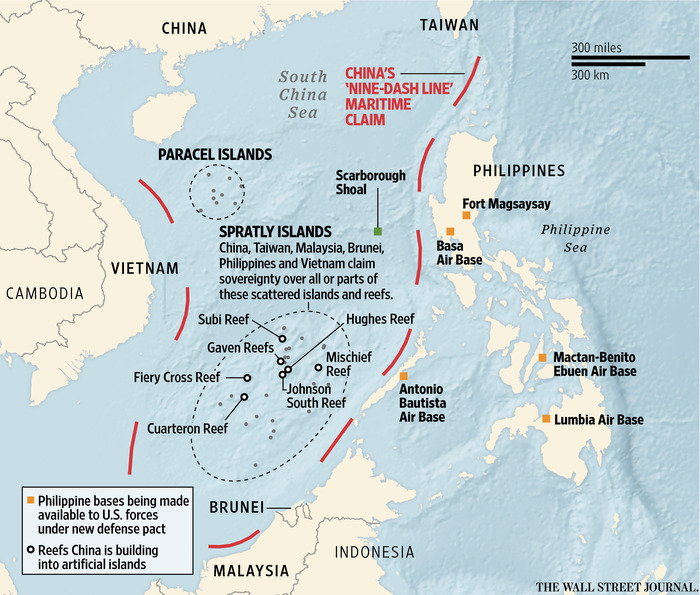
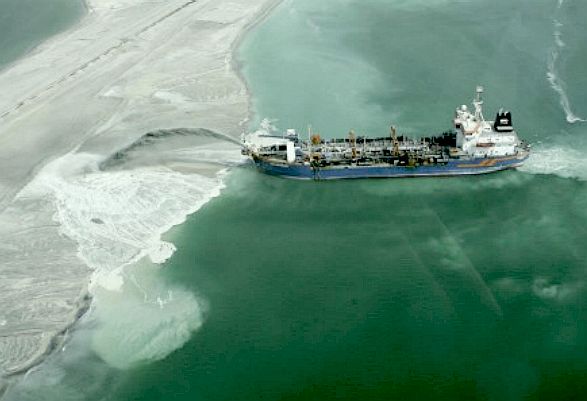
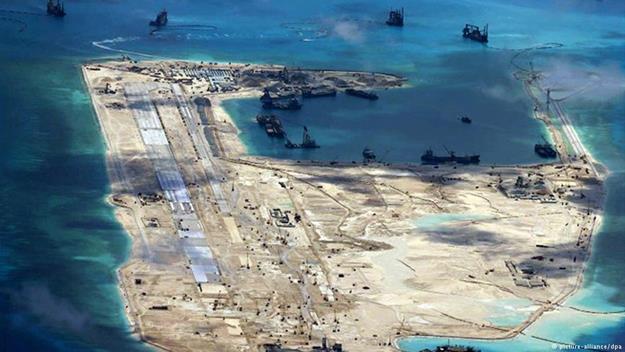
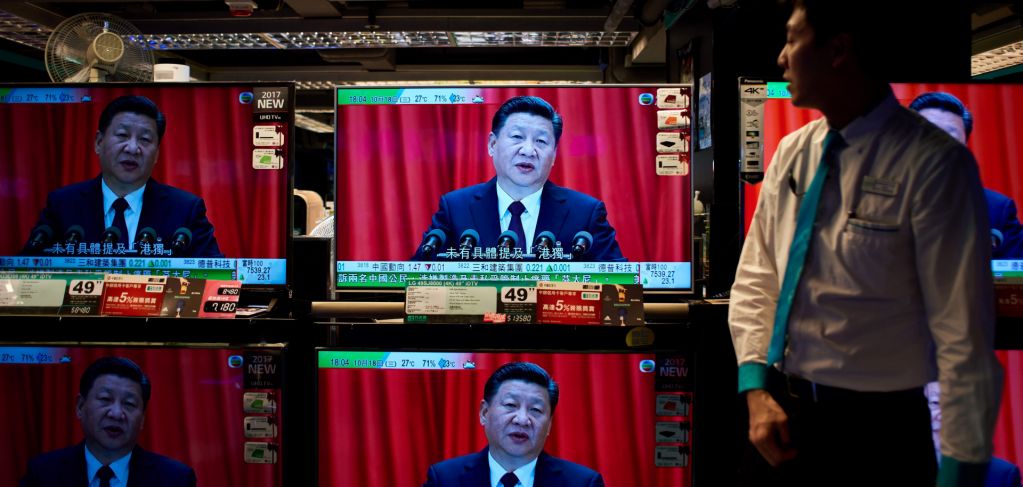
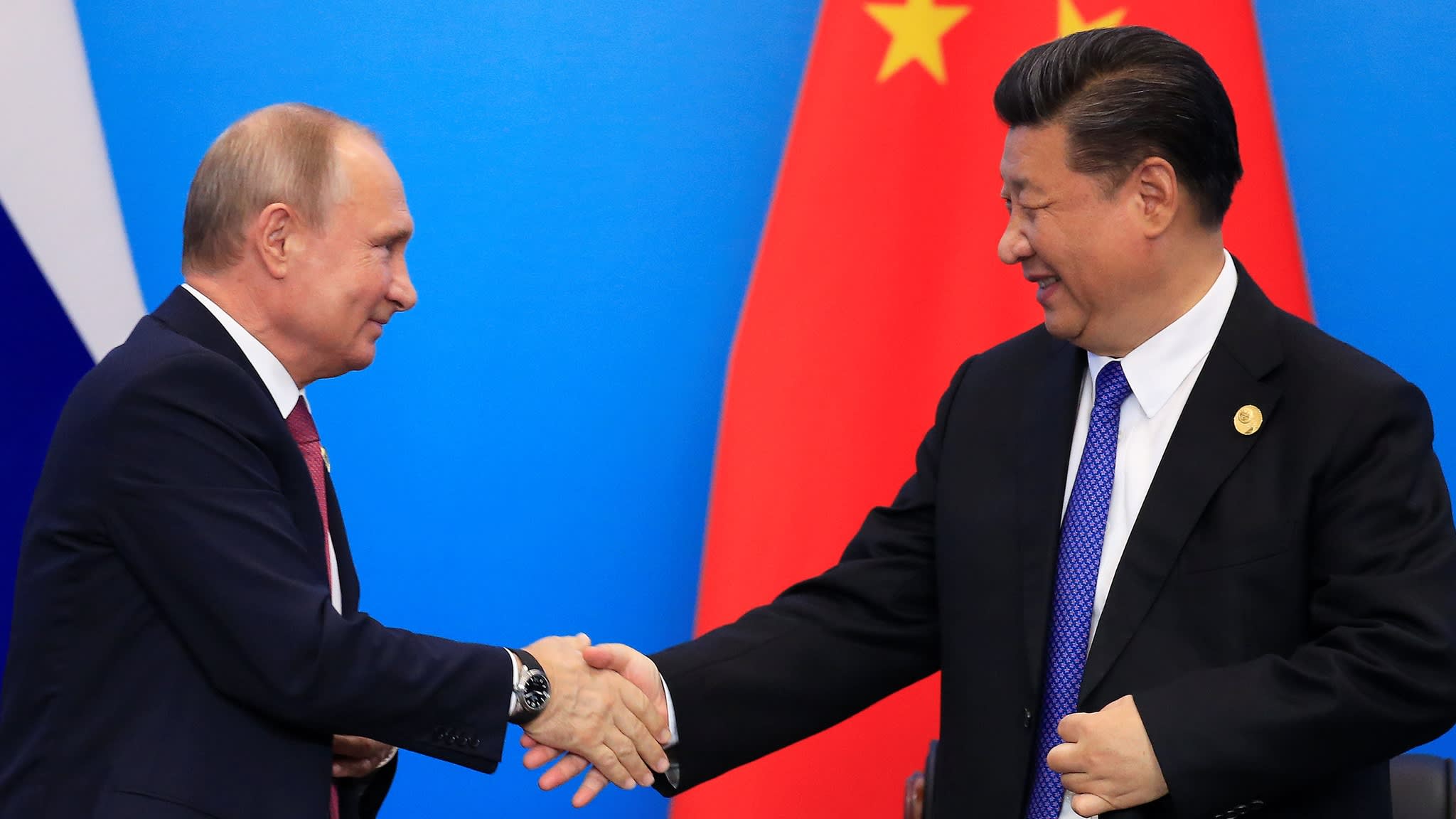
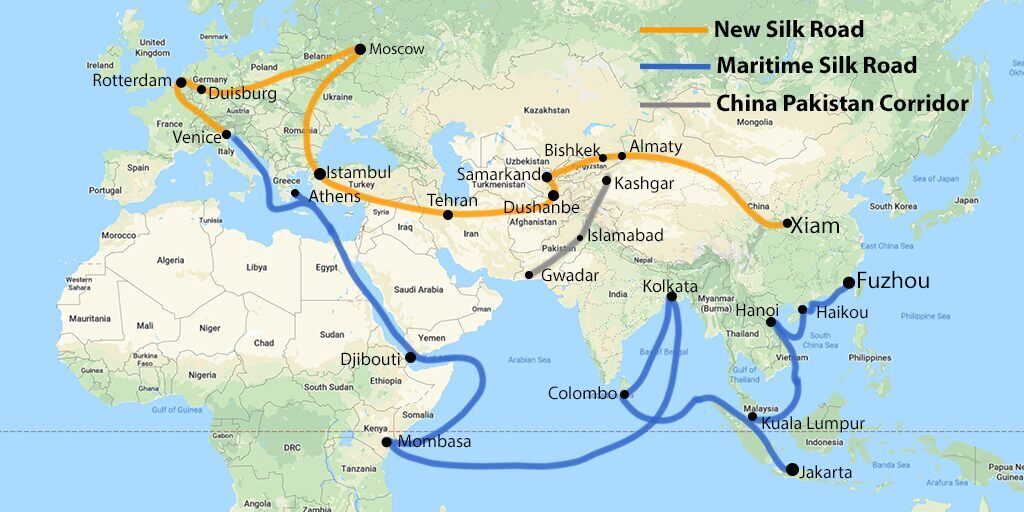
| China's "One Belt, One Road" or Belt and Road Initiative (BRI), initiated back in 2013, involves trillions of dollars in infrastructure development assistance offered to countries struggling financially to meet their economic challenges. This puts China in a very persuasive position as to political as well as economic developments in the many (100 or more?) countries receiving BRI ... and also China's Asian Infrasturcture Investment Bank (AIIB) assistance. |
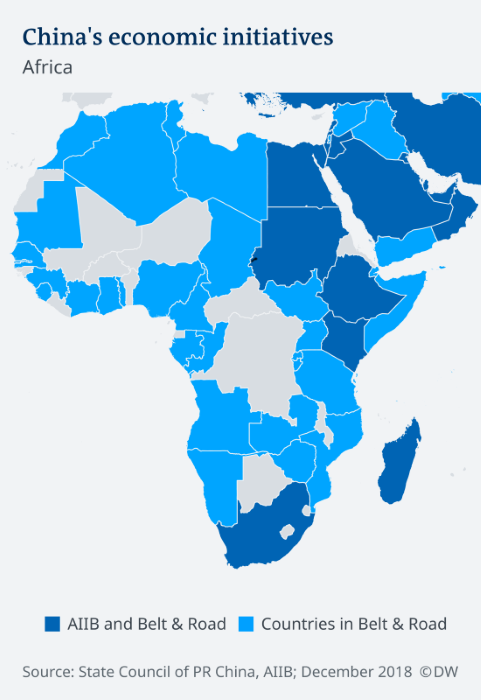
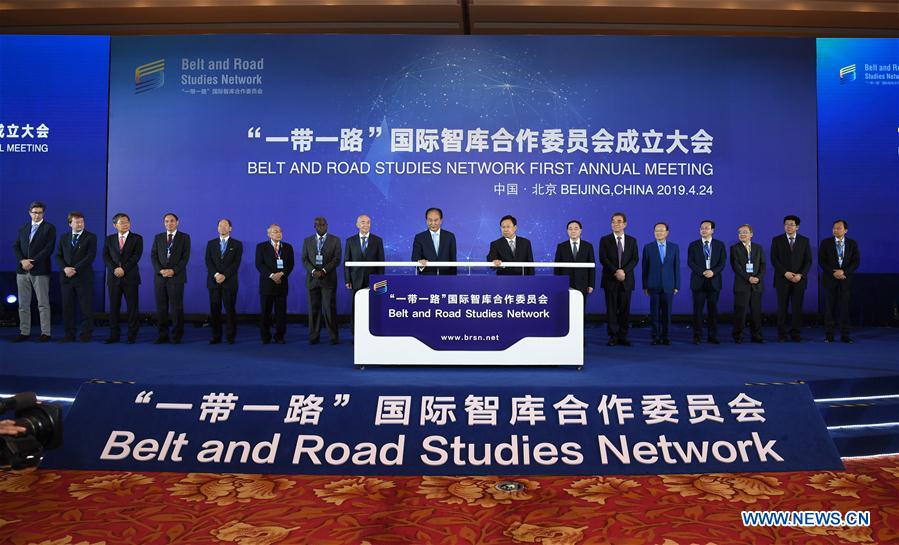


 Miles
H. Hodges
Miles
H. Hodges